Battle royal – Earl Spencer on Henry V and Agincourt

King of Comedy November 2023 | £5.25 £4.13 to subscribers | www.theoldie.co.uk | Issue 432 40-PAGE CHRISTMAS GIFT GUIDE ‘The Oldie is an incredible magazine – perhaps the best magazine in the world’ Graydon Carter GYLES BRANDRETH MY NEW LOVE AFFAIR
Drunk on fame – Jonathan Meades on Burton and Taylor The Red Cross and Remembrance Sunday – the Duke of Gloucester Barry Cryer – by his son Bob Cryer and Roger Lewis

Features
12 Olden Life: What was the three-day week?
Christopher Sandford
12 Modern Life: What is the Wilford Brimley line? Richard Godwin
Books
52 Erotic Vagrancy: Everything about Richard Burton and Elizabeth Taylor, by Roger Lewis Jonathan Meades
53 The Secret Life of John le Carré, by Adam Sisman Jasper Rees
55 Agincourt; Battle of the Scarred King, by Michael Livingston Charles Spencer
57 2SAS: Bill Stirling and the Forgotten Special Forces Unit of World War II, by Gavin Mortimer William Stirling
59 Holding the Note: Writing on Music, by David Remnick David Hepworth
61 The Letters of Gustave Flaubert 1830-1880, edited and translated by Francis Steegmuller Nicholas Lezard

Arts
64 Film: A Life on the Farm Harry Mount
65 Theatre: Frank and Percy
William Cook
65 Radio Valerie Grove
66 Television Frances Wilson
See page 33
Regulars
67 Music Richard Osborne
68 Golden Oldies Rachel Johnson
Pursuits
71 Gardening David Wheeler
71 Kitchen Garden
Simon Courtauld
72 Cookery Elisabeth Luard
72 Restaurants James Pembroke
73 Drink Bill Knott
74 Sport Jim White
74 Motoring Alan Judd
76 Digital Life
Matthew Webster
76 Money Matters
Margaret Dibben
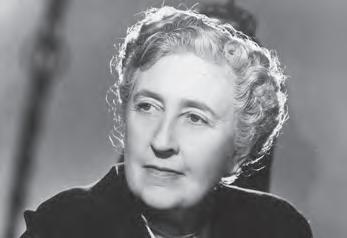
78 Bird of the Month: Shoveler John McEwen
Travel
80 Rome in Lucrezia Borgia’s footsteps Charlotte Eagar
82 Overlooked Britain: Jordans Friends Meeting House, Buckinghamshire
Lucinda Lambton
85 Taking a Walk: Suffolk by moonlight Patrick Barkham
87 On the Road: Julia McKenzie Louise Flind
Come to Greece with Harry Mount p77
Editor Harry Mount
Sub-editor Penny Phillips
Art editors Christina Richmond and Emma Swift
Supplements editor Jane Mays
Editorial assistant Amelia Milne
Publisher James Pembroke
Patron saints Jeremy Lewis, Barry Cryer

At large Richard Beatty
Our Old Master David Kowitz
Oldie subscriptions
69 Exhibitions Huon Mallalieu Moray
To order a print subscription, go to www.subscription.co.uk/oldie/offers, or email theoldie@subscription.co.uk, or call 01858 438791
Print subscription rates for 12 issues: UK £49.50; Europe/Eire £58; USA/Canada £70; rest of world £69.
To buy a digital subscription for £29.99 or single issue for £2.99, go to the App Store on your tablet/mobile and search for ‘The Oldie’.
Advertising For display, contact : Paul Pryde on 020 3859 7095 or Jasper Gibbons on 020 3859 7096
For classified: Monty Martin-Zakheim on 020 3859 7093
News-stand enquiries mark.jones@newstrademarketing.co.uk
Front cover Barry Cryer at an Oldie Literary Lunch at the Savoy Hotel, 2017. By Neil Spence
The Oldie November 2023 3
Barry Cryer, my funny Dad page 26
I love real-life drama Liz Hodgkinson
Joy of nudity Alice
14 Triumph of the Red Cross The Duke of Gloucester 17 Goodbye, Good
Guide James
18 Brunel, my lovely ancestor
20 Wave farewell to long wave Rob Mannion 21 Rugby’s 200th birthday Christopher Sandford 24 Barry Cryer, King of Comedy Roger Lewis 26 Dad’s best lines Bob Cryer 28 Losing my stutter Christopher Coleridge 30 Modern miracles Joseph Connolly 32 My ancient Greek lessons Lulu Taylor 39 Agatha Christie’s stained-glass window Hilary Macaskill 42 Circumcision gets the chop John de Bruyne
11
13
Cockerell
Food
Pembroke
Bella Thomas
The Old Un’s Notes 9 Gyles Brandreth’s Diary
5
Tips 36 Town
37 Country
Wood 38 Postcards from the
Mary Kenny 40 School Days Sophia Waugh 43 Oldie Man of Letters A N Wilson 44 God Sister Teresa 44 Memorial Service: Andrew Edmunds James Hughes-Onslow 45 The Doctor’s Surgery Dr Theodore Dalrymple 46 Readers’ Letters 48 I Once Met … Joni Mitchell Nigel Summerley 48 Memory Lane Alison Cutler 50 Small World Jem Clarke 51 History David Horspool 63 Commonplace Corner 63 Rant: Swimming pools Carolyn Whitehead 89 Crossword 91 Bridge Andrew Robson 91 Competition Tessa Castro 98 Ask Virginia Ironside
34 Mary Killen’s Beauty
Mouse Tom Hodgkinson
Mouse Giles
Edge
House, 23/31
Titchfield Street, London W1W 7PA www.theoldie.co.uk
Great
Subs Emailqueries? co.uksubscription.theoldie@ or 01858phone 438791
last mystery page
Mr Brunel page 18 Reader Trip
Agatha Christie’s
39 Nice
issue
Give from £2.75 an
Out now! 2024 Oldie Annual £6.95 inc p&p
39
See page


The Old Un’s Notes







The late Andrew Edmunds (1943-2022) created a corner of Soho full of amusing, sympathetic souls, as his splendid memorial service, featuring on page 44 of this issue, showed.
In Soho’s Academy Club, in the eponymous Andrew Edmunds Restaurant and in his print shop, Edmunds showed a tremendous sense of style.
These three are housed in two charming 18th-century houses, untarnished by the modern age but pleasantly tarnished by quite a lot of layers laid down by previous ages.

Together with the late Auberon Waugh, hallowed Oldie contributor, Andrew set up the Academy Club.
The rules for membership – devised by Bron Waugh –are satirical: ‘No poets’ is one of them.









Edmunds had a rare understanding of the best food. One day, he was found, head buried in a bin in the kitchen, crying, ‘They don’t know anything.’ He was referring to guests who’d just eaten langoustines for lunch. And now Andrew was picking the langoustines out of the bin, sucking away at them.

‘They didn’t eat the brains. That’s the best bit,’ he said.
Among this month’s contributors


















Lulu Taylor (p32) is a Sunday Times bestselling novelist, editor and interviewer. Her latest book, The Forgotten Tower, is published on November 23rd. She lives in Dorset.

Jonathan Meades (p52) is author of Pedro and Ricky Come Again: Selected Writing 1988-2020 and The Plagiarist in the Kitchen. His TV films include Travels with Pevsner: Worcestershire


Earl Spencer (p55) is author of The White Ship – Conquest, Anarchy and the Wrecking of Henry I’s Dream, Killers of the King and To Catch a King: Charles II’s Great Escape. He lives at Althorp House.

David Hepworth (p59) edited Smash Hits, launched Just Seventeen and presented Live Aid. He is author of Abbey Road Studios at 90 and 1971 – Never a Dull Moment: Rock’s Golden Year
Say cheese: instructions on how to cut Stilton by the late Andrew Edmunds, proprietor of the Academy Club




As so often, style grew out of strict enforcement of certain rules. The order of service contained his instructions (pictured) to his staff on how to cut cheese and, more precisely, Stilton. Once read, never forgotten.








Andrew would have been 80 on 16th September . Happy birthday – and RIP.
The Old Un much enjoyed AN Wilson’s evocation of the 1940s literary world in Anthony Powell’s day (October issue).

He was reminded of
a 1940s anecdote about Horizon, the literary magazine, and Somerset Maugham, then probably the most famous author in the world.
Horizon’s editor, Cyril Connolly, commissioned






The Oldie November 2023 5
HOMER SYKES / ALAMY STOCK PHOTO
Anthony Powell (1905-2000)
Important stories you may have missed
Cardboard left on toaster blamed for Telford house fire alert
Shropshire Star
Maugham to write a piece about detective stories.
Connolly showed the proofs to the literary journalist Julian MacLaren-Ross (inspiration for X Trapnel in Powell’s A Dance to the Music of Time).
MacLaren-Ross said how good he thought it was. But Connolly said he was spiking it, to MacLaren-Ross’s astonishment.
MacLaren-Ross said, ‘But it’s by Maugham!’
And Connolly replied, ‘It’s good enough to be accepted by Horizon, but not quite good enough for me to publish.’
Boris Johnson? Or the more competent, calming influence that is Rishi Sunak?
‘There is no doubt who is better for the political wellbeing of the country, and that is the latter.
Burglar who stole bag of cat litter from OAP jailed Sunderland Echo
Brighton and Hove plan to tackle weeds promised Brighton Argus
£15 for published contributions
NEXT ISSUE
The December issue is on sale on 15th November 2023.
GET THE OLDIE APP
Go to App Store or Google Play Store. Search for Oldie Magazine and then pay for app.
OLDIE BOOKS
The Very Best of The Oldie Cartoons, The Oldie Annual 2024 and other Oldie books are available at: www.theoldie.co.uk/ readers-corner/shop Free p&p.
OLDIE NEWSLETTER
Go to the Oldie website; put your email address in the red SIGN UP box.
HOLIDAY WITH THE OLDIE Go to www.theoldie.co. uk/courses-tours
Peter Brookes, the greatest political cartoonist still in the saddle, turned 80 on 28th September.
To coincide with his birthday, Biteback has published Torrid Times, a new collection from the Times cartoonist, including the glorious one of Prince Harry (pictured).


In his introduction, Brookes writes, ‘Who is better to draw? The rotund, mendacious shyster that is

‘But ask who is better to engage with from a cartoonist’s perspective, and Johnson wins hands down. He’s an enormous barrel of overflowing obnoxiousness, so there’s more to get your teeth, or pen nib, into and a greater satisfaction in targeting his manifold wickedness.’
What’s good for the cartoonist may not be good for the country but, still, what joy to have such a fine artist still working in his ninth decade.

John Mortimer, creator of Rumpole of the Bailey, always said he was raised, nurtured and educated on the proceeds of adultery.
His father, Clifford Mortimer – who went blind but refused to let this hamper his courtroom performances – was a celebrated divorce lawyer in the 1920s and ’30s.

Cases were dramatic then, featuring illicit assignations between servant girls and aristocrats. And headlines were lurid: ‘Passionate love letters found in trunk’; ‘Melancholy story of married man’s intrigue’; ‘Actress as respondent’ etc.

After 50 years of seeing his play A Voyage Round My Father on stage and screen,
In the wake of his memoir, Spare, Prince Harry attends King Charles’s 2023 coronation, but it is announced he will only have a ‘minor role’.
By Peter Brookes
‘God came to me in a dream and told me to cut my salary in half. Obviously it’s a metaphor for something but I can’t figure out what’
6 The Oldie November
2023
Rumpole’s Dad: Mark Dignam in A Voyage Round My Father
‘Not me – you go first’
DONALD COOPER / ALAMY
John Mortimer could hardly recall which lines really were his father’s and which he had written himself.

Rupert Everett is currently starring in the play on tour, directed by Richard Eyre. John Mortimer’s son Jeremy, now in his mid-sixties, found it at first ‘a bit odd to think of Rupert Everett, someone my age, playing my grandfather’.
The warm and witty role of Clifford Mortimer has been coveted by a succession of theatrical greats.
Roger Livesey, aka Colonel Blimp, was the first, on the Third Programme in 1964, two years after Clifford Mortimer’s death. Readers

may remember the first televised version in 1969, with the excellent Mark Dignam.

Sir Alec Guinness starred in a long West End run. Sir Rex Harrison almost played him in a film. A frail Sir Laurence Olivier played him on TV. And in 2006 it was Sir Derek Jacobi’s turn.
At the Donmar’s first night, it was touching to see Sir John in the front row in his wheelchair, watching Sir Derek on stage in his old wicker chair, playing his dad.
The death of the Queen just over a year ago had vast implications not only for the country but also for
companies and individuals to whom she had granted a Royal Warrant.
Royal Warrants have been awarded since the early Middle Ages for services provided to a grateful sovereign. Traditionally, when that sovereign dies, the Royal Warrant becomes void until granted anew by the next monarch. The 600 or so grantees (always an individual within a business), who until recently held the Queen’s Royal Warrant, may continue to display the Royal coat of arms for two years, providing there is no significant change within their companies.
The Royal Household is currently reviewing which Warrants are going to be maintained.
Many of the grantees are now on tenterhooks, wondering whether they will continue to hold the Royal Warrant and be entitled to proclaim those magical words ‘By Royal Appointment’.
There were joyful scenes this autumn at the site of the old Actors’ Orphanage for the abandoned children of struggling or incapacitated actors.
Former residents gathered in Chertsey, Surrey, to be greeted by theatre director Michael Attenborough, son of actor and director Richard Attenborough, who put a huge amount of effort into helping the orphanage.
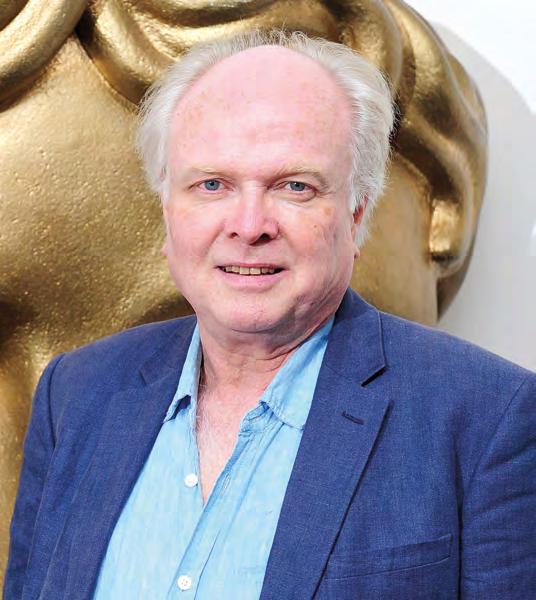
The Actors’ Orphanage
‘I’ve told you a million times – don’t exaggerate!’
began in 1896 and sadly closed in 1958. Its legacy lives on in the Actors’ Orphanage Fund.
In its heyday, many showbiz stars helped the orphanage, notably Sir Noël Coward. As Elliot James writes in The Importance of Happiness: Noël Coward and the Actors’ Orphanage, Coward would often ask, after yet another success, ‘What now?’
He filled that gap by, along with other actors, transforming the austere old orphanage into a happy, thriving place. Many children’s lives were transformed by it.
Coward held theatrical garden parties, midnight matinees at the London Palladium, cabarets at the Café de Paris and charity galas at West End theatres.
During the war, the orphans were evacuated to New York, where they put on a Broadway show and met stars including Charlie Chaplin and Gertrude Lawrence.
The tear-jerking story is worthy of a Noël Coward play.
The Oldie November 2023 7
Kind to actors’ orphans: Michael Attenborough
PA IMAGES / ALAMY STOCK PHOTO

The new woman in my life
I am not planning an affair but if I were, I’d have Hannah Rothschild in my sights.
She is brilliant (the first female chair of the National Gallery). She is beautiful (the evidence is there on Google). She is witty (her novels have been compared to those of Evelyn Waugh, Nancy Mitford and Jane Austen). She is generous (her philanthropy has brought her a welldeserved CBE).

And she is only 14 years my junior, which is just about respectable (isn’t it?) when you are in your seventh or eighth decade.
Of course, I wouldn’t have a chance. I know that: I am not a complete idiot. But the fantasy floated into my head unbidden when, the other day, at the Barnes BookFest in south-west London, I was interviewing Hannah about her new novel, High Time.
We talked about our different writing routines. I told her that I am a disciplined hack, in the study from 9am to 6pm to ensure a minimum daily output of a thousand words. She told me that, for her, writing was ‘akin to a love affair’, to be undertaken in unexpected places at unlikely times, in out-of-theway coffee shops and secret hotels.
I have met her only three times, and I am smitten. By the way, my wife really liked her, too.
Hannah and I were chatting about artists.
In her time as a documentary filmmaker, she filmed noted profiles of Frank Auerbach, Walter Sickert and R B Kitaj. She knew Lucian Freud.
‘And?’ I enquired.
‘He didn’t fancy me,’ she replied. We agreed that Freud’s famous portrait of Andrew Parker Bowles is one of our all-time favourites (sold at Christie’s in New York for $34.89m), and that led me to tell Hannah about the night I thought Freud might have wanted to paint me.
A few years ago, I was dining at the Wolseley restaurant on London’s
Piccadilly. Freud was sitting at his customary corner table. I was a couple of tables away. My wife had gone to the loo and I was gazing around the room.
I realised that Freud was looking directly at me. He was half-smiling and then, lifting his right hand, he began to beckon me towards him with his forefinger.
Heart pounding, thinking ‘Lucian Freud’s canvas, here I come,’ I got to my feet and began to move from my table towards his.
As I moved, I was immediately overtaken by a beautiful blonde girl who had been sitting alone at the table immediately behind mine. She joined the great artist on his banquette. I joined my wife in the basement by the loos.
Whenever I go to Venice (it’s one of my favourite cities: I have been twice this year), I make a point of visiting the Rialto Bridge.
I pay my respects to the great Venetian playwright Carlo Goldoni (1707-93), whose statue stands nearby. Goldoni wrote farces that have stood the test of time (eg One Man, Two Guvnors) and came up with any number of wise and witty lines worth pondering.
‘The world is a beautiful book,’ he said, ‘but of little use to him who cannot read it.’ He was also of the view that ‘he who never leaves his country is full of prejudices’.
I love travelling and I have been to lots of places, but I haven’t been everywhere.
Before I die, as an ambassador for the Royal Commonwealth Society I am particularly keen to visit every one of the 56 countries of the Commonwealth.
To make a start, with my daughter Aphra, I am making a virtual tour of the Commonwealth, visiting a different country on Zoom every fortnight and meeting a different literary figure (sometimes a novelist, often a playwright, usually a poet) and getting them to tell us about the land of their birth (as it was and as it is) and to introduce us to some of the poetry of that country.
This month, we had a particular treat when our Zoom call took us to Gambia, the smallest country in West Africa, where we met Tijan M Sallah. Born in 1958, he is reckoned to be one of Africa’s leading writers.
I had never heard of him. But now I have discovered his work (he has published six volumes of poetry: the most recent, I Come from a Country), I can tell you he is one of the great poets of our time. He is extraordinary: human, humorous, humane, accessible.
Read him. You will be blown away.

This time, while in Venice, I visited Goldoni’s birthplace, as well as his statue. Outside, the hot and heaving streets were rammed with tourists. Inside the Casa Goldoni – currently housing an exhibition of huge masks and a wonderful collection of 18th-century puppets – it was deliciously cool and totally deserted. My wife and I were the only two visitors.
As I burbled on about the genius of Goldoni and the fact that Venice is never crowded when you get off the beaten track, my wife reminded me of another of Goldoni’s famous lines: ‘He who talks much cannot talk well.’
Gyles’s latest book is Elizabeth – An Intimate Portrait
Gyles Brandreth’s Diary
She’s brilliant and beautiful and her books have been compared to Nancy Mitford’s – I’m besotted
The Oldie November 2023 9
JEFF MORGAN 05 / ALAMY STOCK PHOTO
My pin-up: Hannah Rothschild



You couldn’t make it up
With so many gripping true stories on the screen, Liz Hodgkinson is tired of fictional dramas
Once I loved fictional television dramas but now I hardly ever watch them. Is it because today’s actors tend to mumble, the filming is too dark or so many of them are unacceptably violent or sexual?
No – none of these, even though they are all good reasons. It’s because the very best recent dramas on television, by far, have been true-life stories, even if some may seem stranger than fiction.
There was A Very English Scandal, about the murky doings of creepy, saturnine politician Jeremy Thorpe, The Trial of Christine Keeler and, more recently, The Sixth Commandment, the horrific true story of how two retired teachers were targeted by a ruthless con man.
Much of the appeal was down to the quality of the script and the acting. Hugh Grant was uncannily real as Jeremy Thorpe, and Timothy Spall inhabited, rather than simply played, the part of Peter Farquhar, the closeted gay teacher who was murdered by his 40-years-younger lover.
But, mainly, they gripped because we knew that the events, as they unfolded, actually happened. The screenwriter didn’t have to invent anything or worry about how to dispatch an undesirable character. The stories were all there, ready to be converted into drama.
It’s the same at the cinema. The Duke, the scarcely believable story of a 60-year-old taxi driver stealing a Goya from the National Gallery, Oppenheimer, Mrs Lowry & Son and Mr Turner were far more watchable and engaging than made-up films, such as Mrs Harris Goes to Paris or The Good Liar.
In The Wife, the apparently mousy, downtrodden spouse of a Nobel prizewinner is revealed as being the author of the masterpieces attributed to her husband. When I first started watching the film, starring the marvellous Glenn Close, I thought the story was factual. The realisation that it was based on a novel about sexism in the literary world was a grave disappointment. I felt I had been conned.
Or take The Unlikely Pilgrimage of Harold Fry, based on a novel about a retired man who receives a letter telling him that a former colleague is dying in a hospice. He writes her a letter and then, instead of posting it, walks 450 miles to deliver it, without proper boots, credit cards or money, becoming a local newspaper celebrity along the way.
Even the incredible acting skills of Jim Broadbent and Penelope Wilton as the retired couple couldn’t rescue the story’s inherent improbability. Would a respectable elderly man really set out to walk so far without any preparation? He doesn’t even take his phone.
By contrast, Broadbent was totally believable as Blake Morrison’s complicated doctor father in And When Did You Last See Your Father?, based on Morrison’s memoir.
But then he had a flesh-and-blood character to bring to life on the big screen. Broadbent is wonderful at playing these rather disappointed, bewildered, middle-class, older men who wonder what life is all about.
When there are so many actual stories waiting to be made into a film, why make them up? So often, with made-up stories, writers can’t work out how to end the film or what to do with characters who never quite convince.
Even when true-life stories are dramatic in themselves, film-makers
The real thing: Norman Scott (Ben Whishaw) and Jeremy Thorpe (Hugh Grant) in A Very English Scandal

frequently feel they have to embellish them beyond plausibility.
The film Emily, supposedly based on the life of reclusive writer Emily Brontë, has some magnificent shots of rainy Yorkshire moors and fine scenes with her wastrel brother, Branwell. But Emily did not have any kind of affair with the Rev William Weightman, her father’s handsome young curate. It was her sister Anne who was in love with him, although there is no evidence anything happened between them. I am an unashamed realist. I don’t want to have to suspend my disbelief by watching nonsense.
My other cinema gripe? Instead of getting new films, we’re always being treated to remakes or sequels, which are rarely as good as the original.
This Christmas will bring the prequel to Charlie and the Chocolate Factory in the form of Wonka, starring the (admittedly divine) Timothée Chalamet. There have been two remakes of The Italian Job. But can anybody improve on the 1969 film starring Michael Caine?
Why don’t directors make sequels to bad films – they could only be an improvement – rather than make poor versions of great originals?
Dramatising true-life stories is where TV and movies excel. Let’s have more of these, please, and fewer sequels, prequels, remakes and dramas.
The Oldie November 2023 11
AMAZON STUDIOS / ALBUM
what was the three-day week?
Fifty years ago, in November 1973, the National Union of Mineworkers (NUM) began working to rule in support of its demand for a 35-per-cent pay increase.
The next day, Ted Heath’s Conservative government declared its fifth and final state of national emergency, with the first wave of rolling power cuts following in December.
By Christmas Day, there was a 50mph speed limit on Britain’s motorways, and the thermostats in centrally heated offices and businesses were meant to be set no higher than 63° Fahrenheit (17° Celsius) until further notice.
The energy crisis of 1973-74 was the result of a series of domestic and international problems colliding in a perfect storm for the British consumer.
In retaliation for the West’s support of Israel in the October 1973 Yom Kippur War, the Arab, oil-producing nations quadrupled their prices. More expensive
what is the Wilford Brimley line?
The Wilford Brimley line is a staging post in midlife. A person crosses the Wilford Brimley line when they reach the age of 50 years, nine months and six days – or 18,530 days.
Celebrities who have recently crested the Wilford Brimley line include Liam Gallagher, Idris Elba, Eminem, Geri Halliwell, Zinedine Zidane and Cameron Diaz. Congratulations, one and all.
Brimley was an American actor, who served as a Marine in the 1950s before working his way into the movies as a stuntman, extra, and eventually, character actor, specialising in ‘grumpy old man’ roles.

The high point of his career was playing the lead in Ron Howard’s sci-fi caper Cocoon (1985), about a group of elderly people who find an alien elixir in a swimming pool
fuel pushed up business costs and reduced the disposable incomes of British workers such as the 300,000-strong membership of the NUM. It became a vicious cycle. The result was simultaneously inflationary and deflationary, and saw a new word enter the lexicon: stagflation.
Another term soon entered Britain’s national vocabulary. This was the three-day week, which began at the stroke of midnight on 31st December 1973. The basic idea, which again invoked comparison to wartime austerity, was to restrict the use of electricity to three out of each seven days.
TV companies were ordered to close down at 10.30pm, while even on ‘on’ days Britons were supposed to limit heating to one room and to keep unnecessary lights switched off.
In an ironic twist, some people even took to walking around in the blackout with miners’ lamps strapped to their foreheads. There was a bit of incongruous relief from the glam-rock group Slade, who tried to keep spirits up with the
chorus of their chart-topping song –‘Here it is, Merry Christmas. Everybody’s having fun!’ – but few of those struggling with petrol queues and food shortages believed them.
I was at boarding school at the time. In the late afternoon, lessons were conducted by candlelight and boys awoke to a thin layer of frost on the bedclothes in the morning.
Much of Britain was quite literally at a standstill. Matters came to a head when Heath called a snap general election on 28th February 1974. It proved something of a miscalculation on his part. The Tories lost 28 seats, resulting in a hung parliament, and Heath eventually gave way to Harold Wilson’s Labour party.
The NUM duly got their 35 per cent, and the three-day week finally came to an end on 7th March 1974. A couple of weeks later, the Arab cartel lifted its oil embargo, Abba won the Eurovision Song Contest with their infectious Waterloo, and at least for the time being life returned to normal.
Christopher Sandford
next to their retirement home.
Cocoon was released when Brimley was, yes, 50 years, nine months and six days – though he looks so convincingly ancient in the part, you would swear he was 70 at least. When placed next to a modern-day quinquagenarian – say, the impossibly handsome Paul Rudd, or the never-more fragrant Gwyneth Paltrow –the contrast is striking.
So poor Wilford has become a symbol of how much older older people looked in times past. Or to put it another way, how much younger older people look now. I mean, if this were the 1980s, Daniel Craig (55) or Nigella Lawson (63) would presumably have settled for dentures and slippers by now. But look at them. Total smokeshows.
‘Old people are hot now,’ was the conclusion of one publication after it subjected the Wilford Brimley line to a rigorous scientific analysis. Never mind ‘lifespans’ or
‘healthspans’ – ‘hotspans’ are increasing apace. Older people – at least those who can afford it – are dressing better, eating better and taking better care of their bodies and faces.
They are also having better sex. Anthropologist Helen Fisher noted that the fastest-growing dating site in the US is the ‘mature’ Our Time – and that ‘seniors are the most likely to achieve orgasm at a whopping 91 per cent per bang’.
In the Guardian’s This Is How We Do It column – where anonymous readers share details of their sex lives – entries concerning more senior couples bear this out. ‘One of our favourite positions is the 69, although that’s a little trickier for us to get into than it was half a century ago,’ divulged Tony, 76, in a memorable recent entry about his wife June, 75. ‘After the sex, we like to have a hearty breakfast.’
Tony and June’s secret? Viagra, and an avoidance of squabbles about chores and money. Oh, and time – time that 30 or 40 somethings can only dream of. They are retired and so have long mornings to fill.
Richard Godwin
12 The Oldie November 2023 EVERETT COLLECTION INC / ALAMY STOCK PHOTO
Wilford Brimley (1934-2020)
Bare necessity
Alice Cockerell and her family do everything naked – from swimming to eating paella
On holiday, we eat lunch naked. Paella is doled out as everything flaps in the breeze.
We are a family of congenital nudists. This genetic strain comes from both sides. Although long divorced, my parents have never stopped sharing one core value: the importance of baring it all.
I haven’t lived with my dad since I was two, but we still have some of our best conversations when he chats to me as I have a bath.
It’s not the same when he has a bath. He tends to have his best conversations with himself in the bath. ‘DO NOT interrupt me when I’m talking to myself,’ he bellows from the bubbles if you try to intrude.
The great nudist idyll is most often realised on family holidays. On jaunts, both my mother and my father view swimwear as The Enemy. Towels, on the other hand, are treated with great reverence. The most repeated sentence on a Cockerell outing is ‘Yes, you can borrow my towel – but NO CREVICE WORK.’ Quickly followed by ‘Your nipples are about to burn.’
Once you start down the beaten path of naturism, it is hard to retreat. This can be tricky. Marrying into the colony is not for everyone. My stepfather is what is known derisively in family circles as ‘body shy’. He’s not an anti-nudist, though, and is often on hand with the gold-dust commodity – towels – when we clamber out of the water.
My stepmother, though, is Nude by Nature. This was officially proved four years ago when my little sister turned her into a TikTok sensation. Thousands of viewers around the world noted that second 143 of my sister’s viral video of us swimming in a lake with a deer showcased her full-frontal mum.

My beloved stepmother didn’t bat an eyelid. She might, in fact, have been secretly quite pleased by the exposure.
She was also coolly unfazed when a family friend arrived unannounced at the swimming pool to catch her competing in the finals of Mushrooms.
Mushrooms is a game where you have to survive as long as you can bobbing face down in the water, arms wrapped around knees, other things splayed by the current. As one of the more accomplished players of the game, she bobbed for over three minutes, unaware of her riveted audience.
Lack of apology is an important part of the nudist philosophy. Once you get into the swing of it, there is no room to be bashful. I love this about nudism; no one is self-conscious or tries to be cutely pert. It’s a prelapsarian way of padding about the place.
Over the years, there have been plenty of converts to the cause, and nothing matches the zealotry of a new recruit. Last year, a great friend of ours took to it so wholeheartedly that even we had gently to suggest that she wore knickers when she craned into the dishwasher
or when it was her night to supervise the barbecue.
There will always be refuseniks. The anti faction is made up of various different categories that include – but are not limited to – gardenvariety prudes, sun-challenged redheads and, strangely, the deeply lecherous.
Creeps often don’t see the point of nudism. Roald Dahl (not necessarily a creep, but a man not unpreoccupied with sex) couldn’t bear the sight of his wife, actress Patricia Neal, pottering around their bedroom without clothes on. Unless it was expressly to titillate, he thought a naked woman was a shamefully inappropriate sight.
Last summer, there was a row when workmen, painting a fence by the pond I leap into in Somerset, put in an anxious request that I invest in bathers for the period of their work. They couldn’t unsee what they had seen – that was the wounding allegation. I suppose they had a point; there might have to be an element of consent to it all.
The next generation worries me. Though my brother-in-law remains mulishly opposed to conversion, he hasn’t yet objected to his eight-monthold son being raised within our belief system. The overwhelming urge I have to take off all my nephew Ludo’s clothes and stretch him out on the lawn is a fledgling and progressive cult I have dubbed Ludism. So, far Ludo is a fanatic disciple.
Still, I must confess, perhaps my devotion to the cult might not be entirely the high-minded expression of purity and untainted family values. There might be an element of vanity in the mix.
Might my calling be driven by a pathological fear of returning home after two weeks of dedicated sunbathing with a piglet-pink bikini mark?
I would rather tan my hide than hide my tan.
The Oldie November 2023 13
As nature intended: Alice’s family throw caution aside
On the eve of Remembrance Sunday, the Duke of Gloucester salutes the Red Cross packets that lifted the spirits of prisoners of war
Parcels from heaven
When war broke out on 1st September 1939 on Hitler’s invasion of Poland, everyone remembered what happened last time. After all, it had been only 25 years before.
When it comes to the treatment of prisoners of war, the Geneva Convention had become quite effective, and sophisticated.
Although national governments could not directly help their surrendered prisoners of war, they could be supported by a scheme regulated by the International Red Cross.
In WWI, the British Red Cross Society combined with the Order of St John to collect funds to send food parcels to our prisoners of war held by the Germans. There was a reciprocal arrangement for the prisoners we captured. This meant a fairly level playing field, even though the normal international postal system was severely interrupted.
The joint committee sent 2.5 million parcels. They were much appreciated by those in Germany, where food stocks were very low owing to the Royal Navy blockade of the continent.
And so it became necessary in 1939 to dust down the archives and see what had been successful the previous time and how to use the prestige of the International Red Cross Society to employ the work of the British Red Cross Society to greatest effect.

My father had been Chairman of the British Red Cross Society since 1936 and he succeeded the Duke of Connaught in 1939 as Grand Prior of the Order of St John. So he needed to take the lead in recreating the war council to revive the successful work of the joint committee in the First World War.
The committee to raise funds was set up immediately in September 1939. It was decided to try to raise small amounts from very many people, rather than large amounts from a few.
The most successful initiative of the fundraising campaign was to adopt the scheme started by the trade-union
movement. This scheme deducted a penny a week from people’s wages, which would be sent direct to the Red Cross fund. This was expanded nationwide and was generally accepted with pride, as everyone understood the necessity of this noble cause.
It was noted that, as demonstrated by the Spanish Civil War, modern bombers could carry a lot more explosives than the rattly old aeroplanes of 1918.
So the committee’s first thought was not for help for prisoners, but for ambulances for air-raid victims and enlisting first-aid volunteers, who could help the many wounded.
The Order of St John already had an active army of first-aid volunteers, mainly to be found in dangerous industries such as mining, the docks, the railways and heavy engineering.
Halfway through the Battle of Britain, the Blitz started. All those new ambulances and first-aid volunteers came into their own, often at personal risk to themselves and their colleagues in the fire brigade, the police and the salvage corps.
Responsibility was also taken by the new committee for attending to the

newly homeless, missing persons and many personal calamities, where husbands were abroad with the armed forces and the children had been evacuated to the countryside.
After the withdrawal of the British Army from Dunkirk, there were 40,000 left behind to become prisoners, along with millions of French, to join a large number of Poles in POW camps.
The officers were kept separate from the other ranks, in accordance with the Geneva Convention, and were not recruited for labour. For the other ranks, there were endless tasks to replace the German workforce who had joined the German army.
Most of the officers were deeply frustrated by the fact that there was nothing for them to do to help the war effort. Some were desperate to escape and frustrate their captors.
Most, however, accepted their lot and fought off the boredom, trying to re-educate themselves through books and lectures and to rise above the hunger resulting from their meagre diets – which most Germans shared, as a result of the Royal Navy blockade.
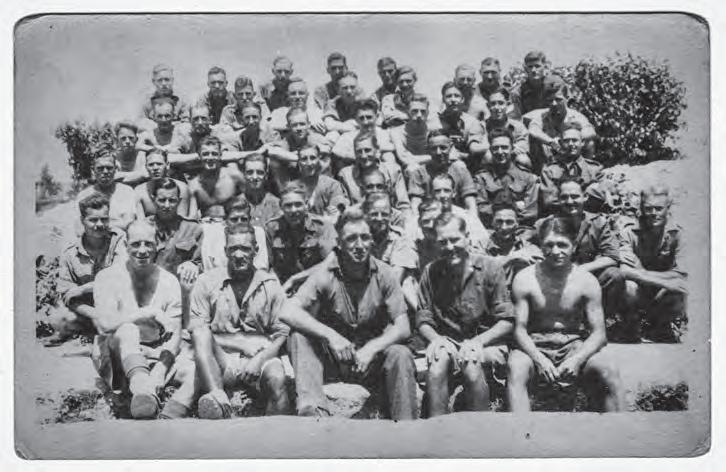
RAC IMAGES / ALAMY STOCK PHOTO 14 The Oldie November 2023
Italian porridge: British soldiers, captured in the Western Desert Campaign, at PG 70 transit camp, Monte Urano, Italy, 1943
After the fall of Tobruk, there were many more British prisoners encamped in Italy – where they were extremely badly fed. In contrast, Italian prisoners from the fighting in North Africa were sent to South Africa and Australia, where there were no shortages of food, and the climate was kinder. Hitler’s policy of reinforcing his troops in Tunisia, when he was unable to supply them with food or ammunition, led to the taking of 500,000 prisoners, half of them Italian. And so the need for Red Cross parcels increased and the joint committee went up a gear, responding as best they could. Here is an extract from the diary of Robert Dickinson, a soldier in an Italian camp, after he’d just received food parcels from the Red Cross:
26th April 1942
Commenced with a roll of bread and a tin of bacon, followed by a Yorkshire Pudd. with strawberries in syrup that was supposed to be the finish; but our stomachs won and we finished off the remains of the 2 parcels in this order, every article being the last!
Spooned the condensed milk then the jam, followed by 15oz tin of Herrings in tomato sauce; rest of the margarine (spooned), Chicken and Ham Galantine; tin of baked Beans.
Feeling a little better but a few more tins would find a good home here.
Robert Dickinson was killed in 1943, while fighting with the Italian partisans. He is buried in Milan War Cemetery.
The committee was very sensitive to the effects of their mission. They sent not only food and soap and clothes, but also medical necessities. Among the POWs, there were many Medical Corps doctors, who were frustrated by the lack of proper medical supplies.

They sent a lot of sports equipment, footballs, chess sets, cards, cricket balls, bats and stumps – but probably not mountain-climbing boots!
Similarly, there were lots of books: not only fiction, but also educational books, useful for learning a new profession.
They also managed to smuggle in escape equipment, including compasses and maps printed on handkerchiefs and things that were helpful for printing out false documents.
Statistics show that only one German prisoner successfully made the home run, while 1,200 Allied soldiers

succeeded – which raised morale in the camps when postcards arrived from friends who’d made it home.

Most of the parcels were anonymous and could be dispersed generally. But it was possible to send parcels of whatever you liked to relatives, and many people shared their rations by sending parcels labelled ‘Next of kin’ to named individuals. No doubt some people had their parcel sent by Fortnum & Mason!
There were also bring-and-buy sales in every town or village, and Christie’s auctioned grander items kindly donated for that purpose. Children contributed vegetables they had grown, and dentists collected used toothpaste tubes that were melted down for recycling.
An agricultural sub-committee
organised sales of livestock, seeds and crops. Gymkhanas were used for fundraising. Special shops were opened in high streets – 200 permanent and 150 temporary – staffed mostly by volunteers.
This started a trend: there are now 10,000 charity shops for many different good causes.
When the war in Europe came to an end, the committee decided it had enough funds to continue its Far Eastern responsibilities, and so on 30th June 1945 the fundraising was closed down.
The final figure for funds raised was £54,324,408. In today’s money, that is equivalent to £7.7 billion.
No British charity has ever raised so much by public subscription, with donations given so willingly.
MAP: RAC IMAGES / ALAMY STOCK PHOTO; RED CROSS PARCEL: PAUL BROADBENT / ALAMY STOCK PHOTO; THE BLITZ: THE PRINT COLLECTOR / ALAMY STOCK PHOTO The Oldie November 2023 15
Clockwise from top: POW camps in Europe, June 1944; homeless Londoners after a Blitz raid, October 1940; Second World War Red Cross parcel for a prisoner of war


Goodbye to The Good Food Guide



James Pembroke says a fond farewell to the eating-out Bible, founded in 1951 by Raymond Postgate
Stop all the clocks … The Good Food Guide has ceased publication. Waitrose, which bought the Guide from Which? in 2013, has decided ‘to focus on our other publications, Waitrose Food and Waitrose Weekend’
The truth is that, in common with Michelin and Time Out, they were giving all their hard-earned information away free on their website – and still are.
Most people Google ‘restaurants near me’ and choose the one with the highest score out of five. That army of volunteer inspectors must now stand down.
I was brought up with the Guides; at home there used to be an entire bookshelf of them in chronological order. The font of the title anxiously evolved from the conservative fifties, through the hip sixties and the Day-Glo seventies, only to retreat in the conservative eighties.
My mother, always in pursuit of a bargain, used them to track down which restaurants would offer children halfportions at half-price – a brilliant concept, introducing children to adult food, which has been replaced by the infantilising tyranny of the kiddies’ menu and sweetened chicken nuggets.
The brainchild of Raymond Postgate (1896-1971), the first Guide appeared in 1951. Not minding about food was our national condition and so we got the food we deserved. Restaurateurs had become complacent, certain in the knowledge that two wars had taught us not to complain.
Derek Cooper, author of The Bad Food Guide, believed this was a result of British reserve: ‘An Englishman would rather submit to voluntary euthanasia than expose himself to the possibility of Raised Voices in Public.’
In Postgate, we got the gastronomic champion we deserved, a militant campaigner rather than a worldly gastronome – Egon Ronay, the Hungarian restaurateur, was to take up that position from 1959 with his Guide to British Eateries
Although he dubbed himself ‘the
self-elected Chairman of British Gastronomy’, Postgate’s gastronomic credentials lay firmly in the English tradition. He dreamed not of the Provençal dishes beloved by Elizabeth David, but of ‘lobsters in whisky, roast cygnet, salmon in cider and ormers’.
His reputation as a connoisseur was due to wine expertise and, even then, his The Plain Man’s Guide to Wine was for the no-nonsense man on the street. He was the absolute opposite of the French elitist André Simon, who called him ‘a good judge of cheap wine’.
Postgate had always been the outsider. A conscientious objector in the First World War, he was on the far left of the Labour party in the twenties and thirties. A classics scholar, he wrote effusively about John Wilkes, but a high-profile campaign had until then eluded him.
In 1949, Stephen Potter, author of the Gamesmanship books, commissioned him to write an article on British catering for his Leader Magazine. Postgate suggested a Society for the Prevention of Cruelty to Food to expose the rank offerings of English eateries. He wouldn’t accept this was down to rationing – then at its peak – given that our island of game is surrounded by fish and seafood.
He wanted to encourage us Britons to learn to fight against established practices, and food was his battleground. And so he formed an army, unsusceptible to bribes, which would root out the profiteers. By 1966, he had 13,000 members submitting reports, and was selling more than 100,000 copies a year.
Every Good Food Guide’s introduction exhorted readers to complain about poor food and poor service, and to check the bill assiduously (‘If you can’t add, do at least scowl at it and look as if you are adding it up’).
He all but treated the trade as the enemy – eager to rip off its customers and willing to sue for libel if the truth was exposed. The last mention of libel threats against the Guides was as late as 1979, and the two camps weren’t to work together until 1982, when Albert Roux was invited to put the view of ‘the other side’.
Despite his self-congratulatory claims of having revived the restaurant trade, if anything Postgate succeeded in entrenching the mutual suspicion and animosity between staff and customer. In 1963, a hotelkeeper forced his guests to finish their dinner by 7.45pm because he wanted to watch something on telly.
The Guides are a brilliant record of our attitudes to food. Well into the 1960s, portion size was deemed paramount. Members rejoiced when ‘helpings were generous’ or there was ‘more than I could eat’. The chief inspector of the Guides complained in 1966, ‘A vast mass of our population, as far as I can make out, eat nothing but chips with absolutely everything.’
There were flourishes of selfcongratulation. The 1968 Good Food Guide to London boasted, ‘No other city in the world, not even New York or Paris, today has such a variety of restaurants as London. Inside every English Puritan, there has always been a hedonist struggling to get out, and in the past decade he has got out.’
Yet, in his 1970 Guide, Postgate complained, ‘There is still a decayed Puritan atmosphere in parts of Britain.’
The 1990 Guide was full of woe: ‘There is an apparent lack of a restaurant culture in large parts of Britain.’
And yet would London now be the capital of European gastronomy without that army of watchdogs?
The Oldie November 2023 17
Grub’s up!
Few people were familiar with the name Isambard when I was growing up in the 1970s.
I remember this because it was my brother’s name. It almost always needed to be explained to anyone who asked, and they often did.
It was also a family name, as Isambard Kingdom Brunel was my great-greatgreat-grandfather (our mother’s mother’s mother’s mother was IKB’s only daughter, Florence).
It was because of this connection that I found, among my late uncle’s papers, a personal letter from IKB to his son Isambard.
These days, we rarely have to explain the name. Brunel is far more famous now than he was.
This may reflect the changing way history is taught in schools. Most history used to be political history (the Reformation, the World Wars and so on).
Now it’s less about dates and more about themes. And what better way to bring the 19th century to life than by examining the lasting monuments of some of its prominent engineers?
Unlike the 1832 Reform Act, the vestiges of that history are also visible. You can walk through IKB’s Box Tunnel, over his Clifton Suspension Bridge and down his Thames Tunnel, and examine his flat iron vaults at Paddington Station.
An interest in Brunel’s particular achievements was rejuvenated in the 1990s and 2000s. Some say it was the huge reproduction of the iconic Robert Howlett photograph of the engineer that covered the scaffolding of the British Library for years that caused a stir. In it, he stands nonchalantly in front of the chains of the SS Great Eastern, a stovepipe hat on his head, a cigar hanging between his lips, mud on his trews, an air of gritty authority about him.

Others claim that it was Jeremy Clarkson’s dynamic portrait of him for the BBC’s 100 Greatest Britons series on
TV in 2002, in which Brunel was voted the second-greatest Briton ever, after Winston Churchill.
There had always been the railway enthusiasts, who kept the flame for years. There were the ship aficionados who dragged the SS Great Britain back from the Falklands. But it was only in the 1990s that Brunel became mainstream famous because of the range of his
conquests (railways, bridges, tunnels, stations, ships).
The Stephensons, father and son, contributed as much to railways, but never indulged in ships or bridges. The Arkwrights and the Telfords of this world specialised.
Brunel was always propelled into new engineering possibilities, which made his ingenuity clearer. That he was a child of
Most eminent Victorian Isambard Kingdom Brunel was Britain’s greatest engineer – and a family man, says his great-great-great granddaughter Bella Thomas
18 The Oldie November 2023
Brunel and the giant chains of the SS Great Eastern, launched in 1858
a refugee from revolutionary France only added to his allure.
Since then, IKB has remained at that peak (while Churchill’s shine has been tarnished), and he is probably relatively safe in the current pantheon.
While old political heroes are being widely decolonised, a museum, Being Brunel, has opened in Bristol. His grave is regularly visited at Kensal Green Cemetery, while other Victorian luminaries (Trollope, Thackeray, statesmen, soldiers) are overlooked.
Although he certainly helped enable British power abroad, so far no one has tried to diminish his star on decolonising grounds.
Writers and poets, such as David Hume and Matthew Arnold, can have their words taken out of context; engineers and architects remain above the fray. Perhaps that’s another reason for Brunel’s renewed fame.

For half a century before that vote, Brunel’s achievements lay buried in the general tide of anti-Victorian feeling. Celia Brunel Noble (my mother’s grandmother), Brunel’s only grandchild, who barely knew her mother (Florence died at 29), let alone her grandfather (who had died at 53 in 1859), eventually became the keeper of all the Brunel papers after her childless uncles –Brunel’s sons – had died.
By the 1920s, Brunel’s achievements had been largely forgotten, but Celia was conscious of her grandparentage. She had been steeped in the Brunel legacy by Uncle Diddy (IKB’s son).
With the aid of the letters in her possession, she published The Brunels: Father & Son, in 1938, emphatically marking Brunel’s gifts as a direct result of his father’s influence and energy. IKB’s success was, she argued, partly if not fully steamed by his father’s enthusiasms and existing networks.
Brunel père, Marc Isambard (the French refugee who married Sophia Kingdom), was kindly and self-effacing. He promoted his son, to his own exclusion, said Celia (this was quite unlike the relationship between the other Victorian railway duo, the Stephensons, the father ensuring he was never eclipsed by his son).
It was Marc Isambard who had begun work on the Thames Tunnel and who propelled his son into pole position when he was only a teenage novice. When the tunnel finally opened, Marc Isambard took a back seat.
Having written her book, Celia deposited the bulk of the letters in
Bristol. But she kept back one letter and gave it to her grandson, my uncle.
It reveals a warmth between father and son that undermines the notion of Victorian coldness so mythologised by the Bloomsbury set.
It had been often implied that IKB did not have a sympathetic relationship with his eldest son because he was disappointed that his son, also called Isambard, was debarred by lack of talent and health (he was a lifelong ‘cripple’, unable to walk unaided) from following what had become the family profession.
It seems untrue. IKB wrote to him, ‘I was not sorry you were not present as, in spite of any amount of firmness, one’s anxieties are increased by the consideration of the feelings of those one loves.’
How many successful men today would write like this to their sons, in an age when we tell ourselves we are more emotionally open than the Victorians?
He writes that though he is not religious, he likes to pray and advises his son to do so also. There is also a rigorous, self-critical honesty about his potential for failure:
‘I have never felt more strongly how entirely all the evils and difficulties in such cases are the result of our own imprudence or mistakes, or weakness in giving way to feelings, instead of considering well what was best with the single view of success.’
Isambard Brunel Jr left the letter on his death to his brother, Henry (IKB’s second son), and wrote on the envelope, ‘The most valuable thing I could leave you’, stamping it with Brunel’s ‘EN AVANT’ seal. The letter was deemed by Isambard III a greater gift than anything else he acquired from his father.
So much for the frozen sensibility of the Victorians. The letter suggests ample feeling. The fact that it was bequeathed to his brother even more so. Perhaps the stiff upper lip was more 20th-century than we suppose?
In 2006, our family was invited to Bristol for the displays and celebrations celebrating IKB’s 200th birthday. Fireworks were let off from the Clifton Suspension Bridge and vast crowds assembled to watch.
My brother Isambard was given a prominent role (because of his name), and he was surprised to find such huge crowds. Afterwards, he took a cab back to the station, and a driver of Pakistani descent told him that his ‘community’ were out in force because this was a celebration of ISLAMABAD Kingdom.
How many layers there are to the name Isambard.
The Oldie November 2023 19
Gorgeous: Clifton Suspension Bridge, spanning the Avon Gorge, opened in 1864
A letter to his son reveals a warmth that undermines notions of Victorian coldness
ADRIAN BAKER / ALAMY STOCK PHOTO
Don’t wave farewell to long wave
Next March, the BBC will switch off its LW radio signals. It’s a tragedy, says wireless fan Rob Mannion
Remember those pictures of families listening to the ‘wireless’ in the 1940s and 50s? Their wireless was probably tuned into the BBC Light Programme’s long-wave 1,500-metrewavelength transmissions.

Well, now long-wave transmissions are to disappear. They are due to fade from the illuminated tuning dials on 31st March 2024.
The BBC and its commercial partners Arqiva (who operate all its radio and television transmitters in the UK) plan to switch off the three transmitters using the frequency.
The first is near Droitwich Spa in Worcestershire, with the other two in Scotland – at Westerglen, near Falkirk, and further north at Burghead on the Moray Firth.
When I was a boy, my favourite transmitter was Droitwich, as it was easy to receive the BBC’s Light Programme. Sunday afternoons meant The Navy Lark and the Billy Cotton Band Show.
The Eagle comic, with its ‘Professor Brittain Explains’ column, also fuelled my love of radio. I learned about magnetism and electricity, which led me to build receivers with empty toilet rolls re-employed as tuning coil formers.
Practical Wireless magazine was later key to developing my interest in radio and electronics. I even had the privilege of editing the publication from 1989 until 2013.
The BBC’s medium- and long-wave transmissions enabled keen constructors to make very simple receivers, using homemade ‘cat’s whisker’ detectors. During the 1950s, ready-made
semiconductor signal diodes became available.
Eventually, the British Ferranti company designed and produced the pioneering ‘all in one’ ZN414. A complete ‘radio on a chip’ arrived.
It became popular, enabling constructors to make reliable receivers using only one AA-size battery and very few components.
The tiny chip also provided receivers for our daughters Alex and Charlotte, who attended Clayesmore school in Dorset. The pupils built crystal receivers and then graduated to ZN414 radios built into plastic hand-torch cases. These contained miniature ferrite antennas, a battery and the earpiece which replaced the bulb and lens. The user just placed it against an ear while their head was on the pillow.
The radios were popular, as they could be tuned either to a local station or to BBC Radio 4 long wave on 198kHz. Alex was caught listening to Radio 4 after ‘Lights out in the dormitory’!
Reception from the three transmitters was good. However, there were some ‘nulls’, which meant the signal was cancelled or difficult to receive when the radio waves they emitted interfered with one another.
In fact, if you lived near Hadrian’s Wall between Carlisle and Hexham, bad reception was deliberately planned.
When I worked at what was then the Independent Broadcasting Authority, a former BBC engineer explained that the Corporation had arranged for the unavoidable nulls generated by the three separate transmitters to occur along Hadrian’s Wall.
Why? Because very few people live on or very near the Roman fortification.
Still, you can get reception much further afield. On my travels, I’ve listened to the Daily Service in Clifden in County Galway, former home of the pioneering Marconi transatlantic telegraphy transmitter.
Reception is also possible deep into Europe. When my wife, Carol, and I stayed in a Budapest hotel, we found that the internet service was unreliable, but our long-wave-equipped portable received the Radio 4 programmes we wanted.
Radio 4 and the World Service can be heard in Eastern Europe. Yes, transmissions can be interfered with by autocratic regimes but, unlike the internet, which can be simply switched off, radio transmissions are extremely difficult and costly to block effectively.
Please don’t make us dump our longwave-equipped radios yet!
If the internet or other radio services fail for technical reasons, or thanks to international shutdowns, they are a reliable standby.
Long live long-wave radio!
20 The Oldie November 2023
Rob Mannion is the former editor of Practical Wireless magazine
Please don’t make us dump our longwave-equipped radios yet!
Radio Hollywood: MGM star Gloria DeHaven, 1944
Rugby’s number-one player
Two hundred years ago, William Webb Ellis picked up a ball and created a new sport. Or did he? asks Christopher Sandford
At this year’s Rugby World Cup Final on 28th October, the winner of the Webb Ellis Cup will be celebrating 200 years after William Webb Ellis’s sporting breakthrough.
In 1823, Webb Ellis, in the words of the commemorative stone at his old school, ‘with a fine disregard for the rules of football as played in his time, first took the ball in his arms and ran … thus originating the distinctive feature of the Rugby Game.’

Or did he? There’s a degree of Arthurian myth about the origins of the world’s ninth most popular sport, played competitively in more than 100 countries.
William Webb Ellis (1806-72) was real enough. We know he was up at Rugby as a ‘foundationer’ (scholarship boy) and that the game he was playing that autumn afternoon in 1823 was probably a form of hybrid soccer peculiar to the school.
The idea was to kick the ball between the posts and over the crossbar to score a goal, like certain recent English football penalty-takers.
The most likely scenario is that Ellis caught the ball, which was allowed under the rules of the game. But instead of retreating ten yards to ponder his options, he ran headlong with it towards the opposition’s line, which wasn’t.
The earliest surviving reference to the Webb Ellis story comes 53 years after the feat. In 1876, Matthew Bloxham, a Rugby old boy, wrote to the school magazine, relating the incident as told to him by an anonymous eyewitness.
Bloxham initially dated the event to 1824, then to December 1825 (which would have been tricky, as Webb Ellis had actually left the school the previous July), before settling on the Michaelmas term of 1823.
But, again, we’ll probably never know. By the time the Old Rugby Society came to investigate the matter in the 1890s, both Bloxham and Ellis himself were dead, and no one has ever established the identity of the eyewitness apparently
responsible for the story in the first place. So Webb Ellis may or may not be the founding father of rugby. But his life is still a classic Victorian story of its sort.
The younger of two surviving sons of an army officer killed in the Peninsular War in 1812, William was sent to Rugby at age ten. The family seems to have been financially strapped, because they moved to the Midlands town from their home in Salford specifically so that William could qualify for one of the free places made available to local boys ‘of reduced means but good character, and in that sense worthy of a [Rugby] education’.
He was recorded in the school magazine as being a good scholar and sportsman, although, perhaps significantly, ‘rather inclined to take unfair advantage at cricket’.
Webb Ellis won an exhibition to Oxford, where he read theology – a popular choice among younger sons at the time. He appeared in the first recorded Varsity cricket match against Cambridge, a rain-affected draw at Lord’s in June 1827.
‘Ellis batted correctly’ for his 12 runs, said the Globe, not knowing or not caring about his other sporting exploits.
The next we know for sure is that he left Oxford in 1829, entered the Church, and became successively Anglican chaplain of St George’s Church in Albemarle Street, London, and rector of St Clement Danes in the Strand.
Beyond that, little is known of Ellis’s 30 years in the cloth. In April 1854, at St Clement Danes, he preached a sermon on the subject of the Crimean War sufficiently robust for a daguerreotype of him (the only known portrait) to appear in the Illustrated London News.
Webb Ellis never married. His widowed mother, Ann, lived with him at St Clement Danes, and he later placed a tablet there in her memory. It read, ‘A mother, whose piety is recorded in Heaven and requires no praise upon earth… Her spirit rejoices in God her saviour. Let my last end be like hers.’ It was destroyed by German bombing in the Blitz. He may also have written a poem in praise of beer.
After a further dozen years’ service as rector of St Mary’s at Magdalen Laver in Essex, Webb Ellis retired to a cottage at Menton, close to the Italian border on the French Riviera.
He was thought to have been suffering from tuberculosis, for which sunshine was then the preferred treatment. On a last visit back to London, he wrote that he ‘never thought any place could be so changed, as were from a pleasant village to a strident metropolis’.
Webb Ellis died at Menton on 24th January 1872, at the age of 65. He left an estate of £9,000 – roughly £1.2 million today – mostly to local charities.
His grave lies only 20 miles up the coast from Nice, where England played one of their World Cup group matches this autumn. So perhaps a few rugby fans will pay their respects to the man who –possibly – invented the sport.
The Oldie November 2023 21
MARTIN BOND / ALAMY
William Webb Ellis, Rugby School


Barry Cryer was the elder statesman of light entertainment. His friend Roger Lewis enjoys a new biography by his son

King of Comedy
While the Women’s Institute traditionally rounds off proceedings with a chorus of Jerusalem, the ritual at Oldie functions was for Barry Cryer to tell his parrot joke (‘Hello, Keith!’), which never failed to bring the house down.
Barry (1935-2022) championed the magazine for a quarter of a century. He introduced luminaries at the Oldie Literary Lunches, was present at receptions and launching parties. He was unswervingly loyal to editorial staff and contributors. As his son Bob quotes Stephen Fry as saying, in this warmhearted tribute, ‘He was always welcoming to new talent in comedy. He never succumbed to envy and bitterness. He saw all comedy as one.’
This is true. Barry was appreciative and well mannered. There was never any malice or gossip-mongering. He was the sort of person who ‘shared cigarettes at bus stops’.
I am simply one of the hundreds of people Barry would phone periodically (‘Cryer here. I’ve got a couple of jokes for you’), and his friendship enriched much of my adult life, particularly when he’d introduce me to troupers, such as Peter O’Toole or Leslie Phillips, with whom I was soon hoisting back drinks.
Barry was light entertainment’s elder statesman. He had a reputation in television circles for ‘fast turnarounds and an impeccable ear’, and, beginning in the Sixties, he wrote sketches and patter for absolutely everybody – from Dick Emery and Dave Allen to Spike Milligan, Les Dawson and Danny La Rue, for whom he invented a character called Lady Cynthia Grope.
The Two Ronnies were his clients. ‘I met my wife and Ronnie Corbett on the same day,’ Barry said. ‘I tossed a coin and married her instead.’ Barry created Cupid Stunt for Kenny Everett. When a BBC grandee complained about the innuendo, Barry came up with Mary Hinge instead. ‘You see. You don’t have to be disgusting to get a laugh,’ said the BBC grandee.
NEIL SPENCE COPYRIGHT 2017 24 The Oldie November 2023
As Bob says, Barry ‘enjoyed being a benign presence in a cut-throat business’, and it is the case that most comics are melancholy, pushy and insecure. Except for the fact that Barry’s father, an accountant in the Leeds Council Education Department, had died when Barry was five – and except for an affliction of eczema, which put him in hospital when a young man –Barry was blessed with a lack of personal agony. The family was provided for by the Freemasons, and Barry went to Leeds Grammar School on a scholarship in 1947.
His intention was to be a journalist. Barry read English at Leeds University, but failed his exams – because he was too busy writing skits and performing in Leeds students’ Charity Rag. They gave him an honorary doctorate later. Among the cast was the future Nobel Laureate Wole Soyinka, whom Barry called Wally.
Though he was no academic, a professional knowledge of literature and its workings never left him (J B Priestley was a personal friend). If Barry loved jokes, it was because he loved language, ‘fixing it, polishing it’, with his instinct for rhythms, sounds, nuances.
These were the last days of music hall, and Barry learnt much from its stalwarts, Arthur Askey and Max Miller, who advised, ‘Keep at a distance and be objective, because it’s all unreal.’
After a few fee-paying stints at Leed’s Cities Varieties, Barry was invited by the magician David Nixon to London, where he met theatre managers, agents and producers. He also met Frankie Howerd, who threw a pass, wanting to be rubbed with embrocation (see overleaf).
‘Turns out he did the same thing with Bob Monkhouse,’ Barry laughed. Another famous face was Bruce Forsyth, at that time crestfallen: ‘I’m packing it in. I’m opening a tobacconist’s instead.’
Barry was engaged at the Windmill (‘Dressing room 12A. You’re on at midday’), telling jokes between the strippers. He was soon furnishing David Frost with ad-libs (‘which is just as absurd as it sounds’) and writing television scripts with the pre-Python John Cleese and Michael Palin and the pre-Goodies Tim Brooke-Taylor. He was the warm-up man for Morecambe and Wise. He wrote additional lyrics for Thanks for the Memory, when Bob Hope went on Parkinson

Graham Chapman was another collaborator, with whom the catchphrase became, ‘Shall we go to the pub?’ When Cryer attended a gala dinner with
Chapman, the toastmaster introduced them as ‘Mr Enoch Powell and Mrs Harry Belafonte’.
Originally, Barry had wanted to be only a performer, ‘but I just didn’t have enough sparkle’, and so he concentrated on the authorship side.
When he co-starred in the West End with Paul Scofield in Expresso Bongo, it wasn’t sparkle Barry lacked, but perhaps there wasn’t a powerful stage presence – wackiness, zaniness and forthrightness were alien to his style.
Barry was more reflective, seemingly diffident, at the opposite end of the scale from, say, Norman Wisdom or Rik Mayall. His one-man stand-up act, which I saw often, was a string of Christmas-cracker jokes, about married life, clergymen, three men in a pub, parrots and moths. Barry was Barry – there was no comic persona, no eccentric guise to hide behind. Often, he was mistaken in the street for Barry Took or Barry Norman –but never Barry Humphries.
Yet, as Bob says, his father’s belief that his career was no more than a series of ‘happy accidents’, little more than ‘mucking about,’ can’t be true.
Barry was much more driven than that implies – every day until his eighties there were after-dinner speaking events, charity functions, panel games, a
professional existence of ‘high-profile writing and performing engagements’, particularly on radio.
I’m Sorry I Haven’t a Clue, chaired by Humphrey Lyttelton and latterly Jack Dee, was widely worshipped – though when a fan came up to Barry and said, ‘You’re a legend,’ I heard him reply, ‘What? You mean, I’m not alive?’
Comedy is, of course, under threat today by the progressive forces of woke. How horrible, as well as hilarious, to learn I’m Sorry I Haven’t a Clue has been censured by fat-headed puritans at the BBC, who feel it has ‘failed to keep abreast of changing social attitudes and values relating to the non-acceptability of sexist humour and the sexual objectification of women’.
Rulings like this meant a battle was on my hands when, in my new book about Burton and Taylor [reviewed on page 52 by Jonathan Meades], I referred to Sophia Loren’s big knockers as booby-doohs.
Barry died in January 2022, aged 86. Lung cancer caught up with him, and Bernard Cribbins fell over at the funeral. Barry had lived all his married life in a house in Hatch End, bought for £10,400. The gas bill is now more than that.
As a father, says Bob, ‘He could be self-absorbed and incapable of talking about anything other than work.’
This is nevertheless what made him endlessly fascinating to people like me, who are devoted to the comic arts. I’d give anything to listen to him again on the subject of Ted Ray.
There’s no one now left with these tangible links to a glorious cultural past. The death of Barry Cryer is like the death of one of those old soldiers who’d fought at Waterloo.
Bob Cryer’s Barry Cryer: Same Time Tomorrow? (Bloomsbury, £20) EXTRACT OVERLEAF
TRINITY MIRROR / MIRRORPIX / ALAMY STOCK PHOTO The Oldie November 2023 25
Double act: John Junkin (1930-2006) and Barry writing for Morecambe and Wise
If Barry loved jokes, it was because he loved language, ‘fixing it, polishing it’, with his instinct for rhythms, sounds, nuances
Barry Cryer’s biography by his son Bob Cryer includes the comedian’s favourite jokes and stories from 65 years in showbiz

Dad’s best lines
I’ve been trying to think of the right word for two weeks. And then it hit me. It’s fortnight.
Lot became naturally rather peeved/ When his sex life came to a halt./ Well, wouldn’t you, when you had to make do/
With occasional pinches of salt?
Barry’s student poem in the Leeds University magazine
Poetry and Audience
A man is driving down a country lane and he runs over a cockerel. He goes to the farmhouse and knocks on the door. The farmer’s wife answers, and the man says, ‘I appear to have run over your cockerel. Is there anything I can do to replace him?’
She says, ‘Well, please yourself. The hens are round the back.’
A woman sees this beautiful blue and gold parrot in the shop and she says to the man, ‘He’s gorgeous! How much?’
He replies, ‘Twenty pounds.’
‘Really? He’s beautiful.’
‘Yeah, I know. I’m sorry, but he’s got form. He’s got a history. He was in a brothel, you see. And, to put it delicately, he’s got quite a colourful vocabulary.’
‘Oh, I don’t mind. I’ll take him now, if that’s OK?’
So she takes the parrot back to the flat, takes the cover off, and the parrot looks around and says, ‘New place. Very nice.’
And the woman’s two daughters walk in and the parrot says: ‘New place, new girls. Very nice.’
And her husband walks in and the parrot says, ‘Hello, Keith.’
Frank says, ‘Come and see me between the shows twice nightly on a Friday night.’ So, I go to the stage door. We go to his dressing room, I think, ‘It’s Frankie Howerd! Fantastic.’ And I’m talking to him and he suddenly turned it round, going, ‘What are you doing with your life?’ And I said, ‘Oh, I’m supposed to be interviewing you.’
He then produces this bottle of embrocation. He said, ‘Oh dear. I get
these terrible pains. And it’s not the same when I rub it in.’
So, I thought, game on. I sidestepped and managed to get out of the dressing room. And he took the rejection. And that was the end of that.
Years later, I’m in the Captain’s Cabin pub off Lower Regent Street, where we all went after radio shows at the Paris Studios. I’m with the young Rory McGrath and Jimmy Mulville, who’d become Frankie Howerd writers.
So I’m telling them the embrocation story. And Griff Rhys Jones walked in. And he’s listening. And he said, ‘I don’t believe it.’
I said, ‘It’s true.’
He said, ‘No, I don’t mean that. I mean he did it with me.’ And we all started laughing and saying, ‘Is it the same bottle of embrocation? Is this a prop?’
Turns out he did the same thing with Bob Monkhouse.
Barry on Frankie Howerd
ALL IMAGES: COURTESY OF THE CRYER FAMILY 26 The Oldie November 2023
Home-made publicity poster for Barry’s debut show at the City Varieties, Leeds, August 1956. He was 21
A woman is lying in bed with a gentleman she should not be with. Her husband is in Hong Kong. A classic start to any joke – the sound of the key in the lock. The woman says to the man: ‘Get out of here! It’s my husband, get into the bathroom!’
The man does as he’s told, just before the husband comes into the room. The husband sees his wife, as you might say, en déshabille. She says, ‘Oh, darling, I have missed you. Welcome home, you must have jet lag, come to bed...’
He says, ‘That’s a lovely thought, but I’ll just go to the bathroom to freshen up.’
And, before she can say anything, the husband is in the bathroom, confronted by a man, who is barefoot to the neck, clapping in the air above his head.

The husband says, ‘What are you doing here?’
The man replies, ‘Council. Your wife phoned and said the flat was infested with moths.’
The man continues clapping.
The husband then says, ‘But you’re naked!’ And the man looks at himself and says, ‘The bastards!’
A man in a hospital gown and a drip on wheels walks into a pub. He orders a double whisky, which the barman gives him. The man drinks it all. ‘I shouldn’t be having this with what I’ve got.’
‘What have you got?’ asks the barman. ‘Fifty pence.’
Barry said about his wife, Terry, ‘The secret to our marriage is that we don’t understand each other.’
She understood him all too well. Only one woman would pull up to the roundabout at Elstree Studios to pick him up and when she found him dancing naked on the roundabout, arm in arm with the comic Bob Todd, not divorce him. Though she did drive off.
Eric Morecambe once wondered what would happen if they had a guest on the show who didn’t know what they were supposed to do.
Barry and John Junkin, his co-writer, hit upon the idea of having Vera Lynn on and getting Eric to mispronounce her name (see Andrew Preview, as they called
André Previn). Vera then goes to sulk in her dressing room and refuses to come back on.
Ernie: ‘How can we get her to sing?’
Eric: ‘I don’t know. Short of starting another war, I’ve no idea!’
Barry’s favourite sketch that he wrote for Morecambe and Wise
He could do that thing, which I’ve described as telling a thing that isn’t a joke but makes a noise like a joke.
There was one he used to do relentlessly on tour, sometimes in recordings, during the Uxbridge English Dictionary round (where panellists would give alternative definitions to words) which was ‘rancour – a Japanese term of abuse’. The audience would always laugh.
As a purist, I’d say that doesn’t work on any level. Because the Japanese have no problem with a W. Ls and Rs? Sure. But the audience still laughed.
Graeme Garden on Barry
Left: Barry wrote for The Kenny Everett Television Show, 1983. Kenny (dressed as Dracula) said to him, ‘Oh, Ba, a wife and four children. What a smokescreen!’
Below left: Henri Wintermans cigar ad, with Barry as Groucho Marx


Below: When Barry wed Terry, Bristol, 4th March 1962

A man and his wife are walking one day when they spot a bloke sitting alone in a bus shelter on the other side of the road.

‘That looks like the Archbishop of Canterbury,’ says the woman. ‘Go and ask him if he is.’
The husband crosses the road and asks the man if he is the Archbishop of Canterbury. ‘Fuck off,’ says the man.
The husband crosses back to his wife, who asks: ‘What did he say? Is he the Archbishop of Canterbury?’
‘He told me to fuck off,’ says the husband. ‘Oh no,’ says the wife. ‘Now we’ll never know.’
Barry’s last joke. He told it to a nurse at Northwick Park Hospital in north-west London the day before he died in 2022
Barry Cryer: Same Time Tomorrow? The Life and Laughs of a Comedy Legend by Bob Cryer (Bloomsbury) is published on 26th October
The Oldie November 2023 27
How I found my voice
Aged 11, Christopher Coleridge suddenly developed a stutter. After a decade of agony, he discovered a cure
What do Demosthenes, President Biden, Ed Sheeran and I have in common? A stutter.
We are a select bunch: about one in every hundred. Although nowadays I rarely stutter, like an evil gremlin it still lurks in the background, ready to ambush me when I am tired or stressed.
Stuttering is now understood to be a neurological condition, meaning that the wires in the speech-related parts of the brain are not connected quite correctly. It is not because of a psychological flaw or a sign of character weakness. Most children who stutter will grow out of it, but if it develops into adulthood, then it is almost impossible to cure.
My stutter started at boarding school in West Sussex when I was 11, some 40 years ago. I am still not sure what brought it on. Perhaps there’s a genetic factor, since a great-aunt is remembered to have stuttered.
The pressure of preparing for the scholarship exam to my next school and a bully who picked on me that same year probably did not help either. Would the stutter have appeared if that one year had been different? Or remained dormant? I do not know.
Everyone’s stutter is different. Mine was not a repetitive one (‘P-p-please p-p-pass the b-b-butter’) but more a total block where I could not say the first letter of the word. I found hard consonants such as cs and bs particularly difficult – so my name with its two Cs was unfortunate.
I would sense a stutter coming from some way off, feeling the inside of my mouth locking. A few seconds of awkward silence, with me straining to speak through it, would feel much longer than it was.
As well as being upsetting, it could sometimes have a funny side. On my first day at senior school, a boy asked me which school I’d been to before. Its name was Windlesham House. Starting to stutter and sensing a long battle with the
word, I answered him, ‘Indlesham House – with a W on the front.’
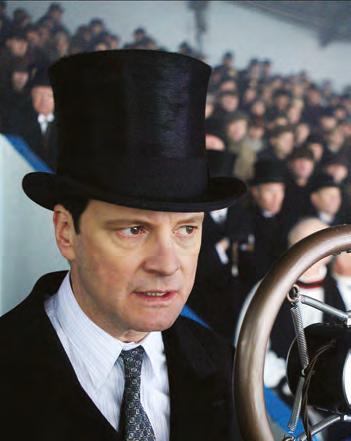
School days had regular hurdles to jump over for a stutterer. I can remember walking, aged 14, up the aisle of the school chapel to read to hundreds of boys from one of St Paul’s Epistles.
My name had been selected – we all had to do it – and it did not occur to me to ask for a stutter dispensation. The first word was ‘Behold’, a dreaded hard B. I had already decided that this B was impossibly challenging, so craftily planned to say ‘And behold’ instead, to make it a bit easier.
Up on the lectern, the ‘And’ proved harder than expected. I froze, as a loud, long, high-pitched, mangled vowel emerged from my throat like an animal in pain and echoed through the loudspeaker. The rest of the passage came out smoothly and stutter-free –as if my stutter just wanted to remind me that it was there but didn’t want to steal the whole show.
Towards the end of university, I could stand the stutter no longer. I wondered if my local doctor had any ideas. He casually mentioned a well-known speech centre on the outskirts of Oxford, and
quickly got me enrolled after Finals for a week-long intensive stutter course.
It changed my life. First, I was the least-bad stutterer there. Others could hardly speak, and I could see how lucky I was compared with them. I practised speaking slowly in time to a metronome (this method is now seen as oldfashioned, but it worked for me).
Once we had to venture into Oxford and speak to strangers. I went with a young man called Dave, who had come down from Hull and had a debilitating stutter. In Magdalen College, we spotted the actor Anthony Hopkins, who was filming Shadowlands
We nervously approached him, laboriously explaining that we were from a local stutter course. He could not have been more friendly, and it was an encouraging story to tell the group later.
After that week, my stutter improved, and since then it has evolved into an old acquaintance who never quite leaves. We tolerate each other. It let me get married without stuttering over the wedding vows, which I was grateful for. Sometimes it reappears when I am tired. Most stutterers have it far worse.
In Los Angeles, where we now live, I recently helped set up a stutter centre. It is a branch of the renowned New Yorkbased American Institute of Stuttering, whose patron is the actress Emily Blunt, also a stutterer.
Every big city should have a highquality place for stutterers, as London has the excellent Michael Palin Centre. Palin, whose father stuttered, played a stutterer in A Fish Called Wanda (1988).
Our mantra is ‘speak freely, live fearlessly’, the aim being not to hide the stutter but rather to embrace it openly and without shame. This more accepting mindset helps stutterers live more confidently. It also often improves their speech once the pressure to speak ‘perfectly’ has been removed.
28 The Oldie November 2023
Christopher Coleridge is a British businessman in Los Angeles
Tough talking: Colin Firth as George VI in The King’s Speech (2010)

Did we ever think that…
Joseph Connolly on the everyday stuff of modern life that would have seemed impossible 60 years ago
The Rolling Stones, whom we’d watched on a small black-and-white-TV screen, would still be rolling 60 years later, and that Mick Jagger at the age of 80 would be possibly the most famous man in the world?

Or that he and so many other pop stars would receive knighthoods – Cliff Richard, Paul McCartney, Rod Stewart, Tom Jones, Van Morrison, Bono, Ray Davies, Elton John, Ringo Starr?
And that when our parents said we would soon grow out of our love for the Beatles, they were wrong?
The insane rise in the value of houses would mean that being a millionaire was no big deal?
The phone would evolve from being the black Bakelite behemoth in the hall into a bafflingly ingenious portable sliver that could do everything?
And meanwhile, to the young, it would become a vital and wholly addictive adjunct to their limbs and heart, if not their soul?
A pandemic would result in unprecedented lockdowns over two years, preventing all socialising and necessitating ‘working from home’?
Quaintly titillating magazines such as Parade and Health & Efficiency would give way to 24-hour online pornography?
Having watched Sean Connery’s James Bond strapped to a table in Goldfinger, we would voluntarily submit to lasers invading our eyes?
Rolls-Royce would be sold to the Germans?
The price of a birthday card could be £2.99 and a second-class stamp £1.10?
In the 1960s, this £3-odd would have bought you an LP, six paperbacks, a pound of Black Magic and a couple of pints of beer.
Glorified gym shoes would become the ubiquitous footwear of choice? Or that men would come to dress like sloppy children, including T-shirts bearing cartoons, advertisements and idiot slogans?
Everything in the news would terrify, bewilder or appear to be a gag?
Having been able instantly to recognise a Jaguar, Morris, Humber, Rover, Wolseley, MG and all the other beauties, we would witness every car uniformly come to resemble an aluminium window wedge?
Smoking would become illegal just about everywhere, including in pubs, and it wouldn’t seem impossibly weird?
A daily newspaper could cost three quid?
Communities would have to fight –usually unsuccessfully – for the retention of a bank, post office, police station and library? Or that a butcher, fishmonger, greengrocer or sweetshop would become
ever scarcer, while coffee shops and bakers proliferated? And tobacconists moved towards extinction?
British history would be seen to be almost wholly malign, its heroes warmongering racists?
Our most-loved authors (including Shakespeare and Dickens) could be censored, rewritten or issued with ‘trigger warnings’?
We would be exhorted to save the NHS? Not to mention the planet?
Almost everything essential to living would be conducted on a computer, and nearly everybody would own one? And that despite their frequent glitches, crashes and deliberate hacking, an absolute determination to cancel all alternatives (cash, chequebooks, pen and paper, human beings) would prevail?
Something called Google would render the Encyclopaedia Britannica handy only for kindling?
A drive for inclusivity and diversity would make ‘elite’ a dirty word, and also a mockery of merit and superior ability?
Heart-attack or stroke victims could be left for many hours, possibly to die, for the lack of an ambulance? Or that it could take weeks to see your GP?
Food staples – beef, ham, bacon, sausages, eggs, butter, cheese – would routinely be branded ‘dangerous’, or that vegetarianism, let alone veganism, would take such a hold?
Any voiced memory of pulling the chain, licking stamps, spending a penny or breaking a note would occasion at least funny looks, if not open ridicule or utter incomprehension?
Or that, oh dear, we would ever become an oldie…?
30 The Oldie November 2023
Still rockin’: Mick Jagger, 1967

It’s all Greek to me – thank Zeus
When I moved from London to darkest Dorset, my friends secretly pitied me.
‘Lucky you,’ they’d say wistfully. ‘We’d love to leave too, if only we could…’
They didn’t mean it. They couldn’t conceive of a worthwhile life over two hours away from town. When I told them that my children would be going to school on Saturdays, they pitied them too. Poor enslaved babies!
But the children went happily to enjoy things such as circus skills, cartoon drawing and chess. One club caught my eye: Ancient Greek – parents welcome.
Keen on languages and eager to embrace everything my new life could offer, I signed up. My teacher was Micky Burton-Brown, Oxford-educated classicist (Pembroke), ex-prep-school head, and only 82. He brought a razorsharp mind and bags of enthusiasm, as though he hadn’t already taught dozens of generations the same alphabet, sentence construction, breathings, cases and conjugations. He’d been teaching for so long he’d known three different official pronunciations of the letter eta.
The class was a mixture of Year 7s preparing for their scholarships, parents brushing up their long-forgotten Greek or, like me, trying something entirely new, and pupils from the local comprehensive. I know of three of the latter who got into Oxbridge to read classics with Micky’s help – he was hugely proud of their achievements.
At first, I found Greek quite easy. It helped that I’d studied German to A-level and so the grammar felt familiar: the same cases (no ablative) and the flinging of the verb to the end of the clause. I enjoyed mastering the alphabet – writing out theta, phi and psi always gave me a thrill, perhaps because they look so Greek – and learned to identify the false friends: p is pronounced ‘r’, v is ‘n’, y is ‘g’. I was delighted when I could write a simple sentence and translate a fable.
It went so swimmingly that I got carried away and had happy thoughts of a GCSE within a year or two. When Mr B-B asked the boys where they were going for their next school, I wondered if I should consider Eton or Winchester – before remembering, with a pang, that was all long behind me.
Then it got tricky. The grammar got harder. It was no longer enough to say, ‘Remember, remember, every day – neuter plurals end in A.’
We did one hour a week in term time, excluding exeats, so there were only 21 lessons in a whole academic year.
It was easy to forget the endings for third-declension verbs, confuse those pesky participles and get muddled with the aorist passive, but I persisted. The reward was worth it. When I first worked on a small passage of Homer, I felt a tingling connection with human history, poetry and story-telling.
But I could see that thoughts of a GCSE were ridiculous – as if I needed one anyway. GCSE Greek is hard, and my brain was no longer a sponge. My son, only ten when I started learning, began his Greek course four years after me, and finished it in two years, when I was still working on chapter one of John Taylor’s excellent Greek to GCSE: Part 2
My son has done his A-levels now and is off to university. I’m on chapter two.
But I am still entranced by Greek and all that I’ve learned, despite a head full of other demands. It helps in quizzes, too.
When Covid came – ‘It’s o-MIKEron,’ Mr B-B would declare, ‘not OMicron’ – there were no lessons for a long while. After that, things changed.
Old school: masters and pupils, Athens

Mr B-B is now 91 and no longer teaches at the junior school. He can’t provide the appropriate safeguarding information and doesn’t really see why he should. He is still keen to offer the fruits of his extraordinary classicist’s mind, but without a classroom to teach in there are no more Year 7 children.
Greek class has shrunk to three parents and is held in my dining room on a Saturday morning. It is still exciting to translate stories of Alexander and Socrates, as is the prospect of chapter three, but there is the sense of an ending. It is not so easy now for someone to teach youngsters simply for the love of it.
I put a classics teacher called Fred Burton-Brown in my novel Her Frozen Heart and dedicated it to Mr B-B, didaskalos kai philos –teacher and friend. He calls himself the gerontosaurus – the old dinosaur – but he has touched hundreds of lives with his kindness and love of learning, and has certainly changed mine.
I recently tried out my skills on a native Greek speaker. I said: ‘The slave chases the horse towards the river’ –easy, present tense, beginner level. He understood not one word.
I was reminded then that this isn’t for practical use, a scholarship or a GCSE. It’s for the love of learning, the passing and receiving of knowledge from one generation to the next, the stuff that adds to the richness and pleasure of life.
Lulu Taylor is the author of The Forgotten Tower, published on 23rd November
32 The Oldie November 2023
When novelist Lulu Taylor’s children started Saturday school, she went, too – and signed up for Ancient Greek lessons
ANN RONAN PICTURE LIBRARY/HERITAGE-IMAGES
Christmas solved by The Oldie
Give 12-issue subscriptions from £2.75 an issue SAVE UP TO £90 AND GET THREE FREE BOOKS
GIVE ONE 12-issue subscription for £43, saving £20 on the shop price, and get one FREE copy of The Oldie Annual 2024 worth £6.95
TWO subscriptions for only £79, saving £47, and get one FREE copy of The Oldie Annual 2024 AND one FREE copy of The Very Best of The Oldie Cartoons worth a total of £15.90




THREE subscriptions for just £99 – BEST DEAL, saving £90, AND get the two books plus TheOldie Travel Omnibus, worth a total of £21.85

OR Complete the form below and return it with your payment to: FREEPOST RUER-BEKE-ZAXE Oldie Publications Ltd, Tower House, Sovereign Park, Market Harborough, LE16 9EF OR CALL 01858 438 791 NOW
using o er code PXM1123


I would like to give a subscription(s)
Please send the free books to me, the donor. (We will also send you a gift card to personalise and pass on.)
Please choose a start issue:


FOR OVERSEAS SUBSCRIPTIONS,
Example:
- reply by 15th Dec)
per

PAYMENT DETAILS - choose one of two ways to pay

The Oldie Month 2016 33 The Oldie October
ers
❑
❑
❑
sell)
third parties.
Policy
NAME OF DONOR ADDRESS POSTCODE EMAIL PHONE: RECIPIENT NAME 1 ADDRESS POSTCODE EMAIL PHONE RECIPIENT NAME 2 ADDRESS POSTCODE EMAIL PHONE RECIPIENT NAME 3 ADDRESS POSTCODE EMAIL PHONE DETAILS
*The Oldie is published 13 times a year, which means a 12-issue subscription runs for 48 weeks. The Oldie collects your data so that we can ful l your subscription. We may also, from time to time, send you details of Oldie o ers, events and competitions, but you always have a choice and can opt out by emailing us at help@subscribe.theoldie.co.uk. Please tick here if you’d prefer not to receive such o
by Phone
by Post
by Email
. We do not share with (or
your data to
Details you share with us will be managed as described in our Privacy
here: https://www.theoldie.co.uk/about-us/privacy
January
sale 10th
(on-sale 13th Dec - reply by 24th Nov to guarantee delivery of this issue) February (on
January
BY CHEQUE: I ENCLOSE
CHEQUE FOR
PAYABLE TO OLDIE
LTD OR 2. BY CREDIT OR DEBIT CARD: PLEASE CHARGE MY VISA MASTERCARD WITH £ CARD NO: START DATE EXPIRY DATE MAESTRO ISSUE NO SIGNATURE PXM1123 MAESTRO DATE
1.
MY
£________
PUBLICATIONS
The Oldie November 2023
ORDER NOW AT www.oldiegiftsubs.co.uk
simply add £5
subscription to the above rates.
one UK sub, one Europe sub and one Australian sub will cost you just £109. This o er is applicable only to recipients who have not subscribed for six months or more.
For hands that do dishes...
It is too late for my own hands, owing to my failure as a younger woman to wear rubber gloves when washing up.
It’s not the hot water that causes the problem – otherwise our whole bodies would be dehydrated and wrinkled by hot baths. It’s the combination of the hot water with the detergent that causes the damage.
Hair can be dyed, bodies can be rendered agile and taut through Pilates, teeth can be carefully curated but, after necks, hands are the biggest giveaway to our true age. And, unlike necks, we can’t cover them up.
Not that one’s true age matters, of course. It’s just that we don’t want to depress others – or ourselves – by the memento mori incurred by the sight of crocodilian hands with liver spots. The latter are known by the French as fleurs de la cimetière.
The skin gets thinner and we lose fat on our hands as we age – even if we are simultaneously gaining it elsewhere. The super-vain suffer the torture of having fat harvested – usually from the top of the thigh – and, for the purposes of plumping, reinjected via tiny incisions at the wrists.

Madonna, who used to wear gloves on stage, has come up with a better solution. She has, allegedly, undergone mesotherapy, which involves injecting amino acids into the hands with minimal recovery time.
It has obviously worked. Some 2023 images of the star show her with the soft unlined hands of a 20-year-old.
Age spots can be zapped with a laser. A giant machine targets the speckles, resulting in a worrying burning smell, followed by crusting, leaving a creamy dot instead of the liver spot.
But, like damp in a basement, the brown smudges soon return. The alternative is to use Veil cover cream, as prescribed by doctors for the best coverup of scars and even tattoos. A sample
pack can be ordered from Veil to select a shade to suit every skin type.
And the good news is that you too can halt the deterioration today by applying high-protection factor sunscreen onto your hands, as well as your face, every day, and wearing James Bond-style driving gloves every time you set out on a long car journey You can stop smoking, too, as the decreased blood flow triggers dehydration in finger skin.
Incidentally, the Queen wore gloves, not to conceal her age – everyone knew what it was anyway – but to protect herself from germ transfer. She would never have wished one of her subjects harm but, realistically, shaking Her Majesty’s gloved hand after a hundred others had already done so must have been something of a health risk.

Old wives used to say that it was good for us to pick up a few germs here and there via our hands – a few germs, not a complexity of infectious diseases such as Her Majesty’s ungloved hands
would have been exposed to: TB, flu, campylobacter, trachoma, conjunctivitis, adenovirus etc.
Our local septic-tank-emptier told me folk were generally healthier in the days when septic tanks were leakier and homeopathic doses of nasties went into the general water supply, thus building up our immunity.
Everyone talks today about the microbiome of the gut and how important it is to have as many different bacteria as possible in there. But the public is yet to wise up about the microbiome of our skin, the largest organ of the body.
During Covid, we got into the habit of zealously over-washing our hands at every opportunity, but it is wrong to think they need to be immaculately clean. Left alone, we would have helpful little microbes on our hands, as well as in our gut, doing us enormous favours, protecting against inflammation and building immunity Every time you shake hands with someone, there is a useful micro transfer.
By the way, take photographs of your hands to make sure the jewellery you favour is not intensifying what defects they may have. You cannot properly judge from the viewpoint of your own eyes.
In the end, all that really matters is your hands’ feel when you touch another person – ideally they will feel silky rather than scaly or dry. To this end, you can skip expensive hand creams and go instead for the purse-friendly and widely available E45 cream, invented 60 years ago, and favoured by Mary Berry.
For deeply dehydrated, almost callused repair, you might also take a tip from a 30-something Jamaican man of my acquaintance who regularly coats his hands in coconut oil and sits in front of the television for an hour at a time with a sock on each hand, ‘to make sure it sinks in’.
Mary
Killen’s Beauty Tips
ALLSTAR PICTURE LIBRARY LTD / ALAMY STOCK PHOTO
I ruined mine with the washing-up, but you can preserve yours
34 The Oldie November 2023
Handy royal advice: gloves save your skin

Town Mouse


Florence, home of the lavatory Renaissance
tom hodgkinson
to the gutter running under the street. The rainwater collected in the underground gutter was used to cleanse the privy on the Hithe but was becoming blocked with the human waste from Alice’s pipe. This was certainly an ingenious idea, but she had forgotten that her waste may have, and indeed did, clog the pipes she was attempting to use. She was ordered to remove the pipe within 40 days.’
Perhaps Alice had had to pay a fine before – hence her ingenuity. By the end of the 14th century, Londoners were fined two shillings for flinging slops into the street.
Sometimes a block of flats would share a ‘backhouse’, an outdoor loo arrangement that would connect to either a cesspit or a sewer.
The less well-off would use chamber pots and indoor lavatories. Once a week, they would put the solid stuff outside their front door, where it would be collected by one of Lovegold’s agents.
Ancient Greece had plenty of public and private lavatories. A latrine was recently discovered at Delos, along with sewer canals and evidence of some sort of flushing system.
The Romans were inspired by the Greeks and became great sewer-builders, constructing the Cloaca Maxima in the 6th century BC. This was later extended with paved channels, connected both to gutters and to the Tiber.
A few weeks ago, I had a little scamper around Palazzo Davanzati, a 14th-century merchant’s house in Florence.
The Davanzatis bought the house in 1580 from a family of wealthy wool merchants who’d had it built 200 years earlier.
On the first floor is the great hall, a gigantic room for business meetings with absurdly high ceilings. It makes Crispin Odey’s old wood-panelled meeting room in Mayfair look like a council Portakabin.
I was struck by the first and second floor. They both feature a privy or lavatory room – a private corner chamber with a wooden loo seat.
This civilised facility might come as a slight surprise to those who believe that sanitary waste disposal systems were invented in London in 1860 by Victorian engineer Peter Bazalgette.
In Palazzo Davanzati, the lavatories (I’m a very snooty, U mouse and never use the word ‘toilet’) connected via pipes to a cesspit. They might even have joined up with a medieval sewer running into the Arno River.
The Florentines were just as fastidious as we are now when it came to stinking
piles of human excrement – and so were medieval Londoners. Archaeologists have discovered several cesspits in the capital, as well as public latrines.
Excrement expert Craig Taylor, in his essay The Disposal of Human Waste: A Comparison Between Ancient Rome and Medieval London, says a London ‘longhouse’, built in the 1420s, contained two rows of 64 seats. The latrines were connected to cesspits, in turn connected to the Thames or emptied by entrepreneurs. They then carted their load to the countryside by river or road and sold it to farmers for manure.
This business was captured by one single company in the 15th century:
‘In 1466, the city authorities granted John Lovegold a monopoly on cleaning the privies. He was granted this right for ten years because, Lovegold explained, “the business hitherto been done imperfectly and at an exorbitant charge.” ’
Some medieval people took the problem of waste disposal into their own hands.
‘Alice Wade in 1314 decided that she would attach a wooden pipe from her private privy in her room
In the first century AD, the geographer Strabo wrote admiringly that the Cloaca Maxima was filled with ‘close-fitting stones in some places with room enough for wagons loaded with hay to pass through them’.
By the 4th century AD, 144 public lavatories were installed in Rome. They accommodated 10 to 20 people each, and there were no screens between stalls. So it was that going to the loo could be a social occasion.
Some public latrines were installed at the baths. So the Romans were fairly well catered for when it came to lavatorial facilities. Well-off houses sometimes connected their loos to the sewer, while the poorer sort would wait to get their waste collected by the stercorarii, who would transport it to the countryside, as in medieval London.
A flushing loo was invented in the 1590s in England, but did not catch on until the Great Exhibition of 1851.
When teamed up with Bazalgette’s new sewer, and various sewagetreatment facilities, this is the basis of the quite amazing system of poo removal now enjoyed by eight million Londoners – pioneered many centuries ago, not least in the Palazzo Davanzati.
36 The Oldie November 2023
Country Mouse
Mary’s new diagnosis? I’ve got rural dementia

giles wood
In a thoroughly modern essay, entitled Village Hunting 1877, the Wiltshire writer and mystic Richard Jefferies anticipated the Special Places to Stay website of green-travel pioneer Alastair Sawday.
A hundred years divide them, but the two men are barking up the same sort of tree.

Jefferies mused on the tendency of Victorian-era pleasure-seekers always to go where somebody else has been – such as Brighton or Scarborough –instead of striking out a bold, original course for themselves. He advised these early tourists to the countryside to buy a railway map and head for the spaces between the lines where, because of inconveniently placed hills, engineers had avoided laying tracks.
In these spaces, according to Jefferies, were preserved ‘good village hunting grounds’ and a chance to encounter a little of the olde-world life of England. ‘You may find traces of that life in the strange indifference to time which seems to brood over the village.’
Time and motion studies had not yet been invented. As the author observes, ‘Even at their work in the fields, the men and women do not hasten; their arms move slowly, and ever and anon they pause and talk.’

This was just the idyllic scenario in which I hoped to immerse myself when we moved to this Wiltshire village. Unique among villages under 100 miles from London, it has full-time residents. Moreover, none of the villagers heads to London for work in a classic diurnal brain-drain, as seen in other villages. As it is still a remarkably feudal area, many instead find employment in the local fields and cow sheds, or as gardeners or shepherds.
Each day should bring the promise of examples I have read about in Jefferies, Geoffrey Grigson and John Aubrey.
Yet I am constantly disappointed. Few villagers loiter outside their homes, gossiping in slow, drawling dialect about things like withwind (bindweed) or feeling quanked (tired), while smoking characteristic clay pipes and wearing homespun linen or hemp smocks, to protect their clothing.
They are not dropping their tools to stare in awe as ‘fine carriages pass through’, as in Aubrey’s day. They are not even moving slowly.
My only consolation is that the terrier men still refer to the original field names. They are, of course, no use to owners of lost dogs, who come through the village using Google Maps and are baffled when advised to ‘Have a look in Kit’s Meadow.’
There is one time of day when I fancy I can detect a flavour of traditional village life. It coincides with the postman’s midmorning arrival, which for hundreds of years now has signalled news from the outside world. His presence seems still to prompt an atavistic low-level excitement among older villagers.
They take a break from cultivating their giant cabbages in their long back gardens, to congregate amid assorted ribald comments and private jokes.
On warmer days, I throw open the front door in the hope of finding out
what on earth they could be finding so amusing at precisely the same time as my croissants and arabica coffee are coming to term. Eavesdropping is a much underrated pastime.
John Aubrey, in the 17th century, described the indigeni of Wiltshire as ‘slow and dull, contemplative, heavy of spirit, litigious, melancholy with skins pale and livid’.
Mary has a theory that, so desperate am I to live in a ye-olde-England theme park, I have become slow and dull. In the absence of real-life bumpkins, I have had to take to the stage myself to fulfil a multiplicity of bumpkin roles.
She has noted that, even when I first moved here as a young man, my gait began to change from sprightly to shuffling. Fans of YouTube videos will note that this change is often a telltale sign of frontotemporal dementia.
It’s no laughing matter. Mary has noticed how long I am taking to walk the dog: ‘I saw you from the window and you seem to have started dawdling.’
‘Yes,’ I reply ‘I have revived the centuries-old country custom of leaning heavily, arms crossed, on gates or fences, overlooking large prospects, the better to observe what, if anything, is going on in the countryside.’
To paraphrase J B S Haldane, country life is not only queerer than we suppose, but queerer than we can suppose.
It is seldom now that I fail to return to the cottage without a tale of modern mishap – a herd of cows trampling ramblers, a herd of sheep being rounded up by a stray poodle.
Take today, when I saw the most extraordinary sight:
A grown man gaining the brow of Martinsell, the local hill, at an improbably rapid pace, before casting off his outer garments pell-mell and throwing himself like a human log to roll down the steepest incline to just where he started. This was, I repeat, a man –not a boy. I have waited almost a lifetime to witness my first ‘fool on a hill’!
The Oldie November 2023 37
‘I do believe you’re right, Henderson … it is … it’s Indian Ink!’
Wall-to-wall art in Kent
New murals of Buster Keaton and Somerset Maugham have popped up in my home county, says Mary Kenny
The art of the street mural has broken out in Deal, where a posho culinary restaurant, The Rose, has adorned its gable end with a picturesque mural displaying a lighthouse and a seascape.
Meanwhile Kent’s excellent Museum of the Moving Image, reopening after renovation, recently unveiled a huge gable-end mural of Buster Keaton, a landmark image visible to anyone alighting from the train.

Ben Dickson, the artist who painted the 30ft Keaton mural, also painted a striking mural of Somerset Maugham in Whitstable, the location of Maugham’s classic novel Cakes and Ale (and where that author grew up).

I happen to be in possession of a shabby gable-end myself, and am contemplating having it decorated with a large illustrative mural. Since Belfast pioneered this wall art, it is tempting to choose an image of King Billy on his white charger.
Deal has no cinema but is well served by movie culture, having not only its own MOMI, but a fine Deal Film Club. Until his death this year, it was presided over by the renowned local film critic Derek Malcolm.
I first met Derek at the Guardian back in the 1960s. He told me how his military father shot dead his mother’s lover – a pacifist – and got away with it as a crime passionnel, unusual in an English court.
When Derek died in the summer of this year, it was said that his start in life was as melodramatic as any movie.
The National Churches Trust is an organisation valiantly dedicated to saving churches all over the country from crumbling or being demolished.
Its approach is that churches aren’t just for believers, but are a community space for everyone. The former Bishop of Salisbury, Dr Nicholas Holtam, is an active NCT supporter. When he was vicar at St Martin-in-the-Fields in London, he was happy to be ‘hospitable’ towards those of all faiths and none for their funeral arrangements.
Yet he was somewhat taken aback when Kingsley Amis chose this particular sacred space for his funerary ceremony in 1995 – Kingsley having been a strongly declared atheist.
A man of mild temperament, Dr Holtam nevertheless felt that Martin Amis ‘rather abused’ the church’s hospitality in his eulogy, which contained a lot of anti-God allusions and other remarks not entirely appropriate to a religious setting. Afterwards, young Marty – who himself died this year – told the cleric that they had chosen the church’s location only really for its proximity to the Garrick Club!
Churches should, of course, be community centres, open to all faiths and none, and St Martin-in-the-Fields is particularly diverse. But surely it’s unsporting to avail of a church’s space and then do anti-God rhetoric? I don’t imagine anyone would hire a mosque and then mock the memory of the Prophet.
Shouldn’t the Luis Rubiales kissing outrage have been seen within the context of Spanish culture?
Until relatively recently, in historical terms, Spanish young women had to be accompanied by chaperones known as duennas, apparently to protect them from the uncontrollable passions of Spanish males.
An Irish mid-20th-century author,
Maura Laverty, wrote engaging novels set amidst this sexually vigilant Spanish culture, where Irish governesses, allegedly watchful Catholics, were sometimes hired for the duenna gig.
But then the señoritas emerged from a society that guarded women as if they were in a harem, into a world of sexual freedom and bodily choice. It’s hardly surprising that mixed messages may follow. When everyone is jumping up and down kissing and hugging everyone else, boundaries of old are broken, and new boundaries not yet set.
It was always ungallant for a chap to force an embrace on a lady, but gallantry was thrown out with the rule of the duennas. After all, gallantry doesn’t square with equality and diversity.
Señor Rubiales perhaps deserves the correction that caused his downfall. Yet I’ve had more than one conversation with old gals like myself who feel there’s too much disparagement of men in modern times. Yes, there have always been a few cads and bounders, but they’ve usually been the minority.
The admirable Ysenda Maxtone Graham has written, in a new book Jobs for the Girls, about the dreadful bosses young women once had to put up with in offices – gropers, bottom-pinchers and bullies.
But I beg to recall differently: I worked in a number of offices from the age of 17, and encountered a succession of male bosses who couldn’t have been kinder, more encouraging, more genuinely fatherly to my youthful, wild self or more persistently tolerant of my terrible secretarial skills.
Plenty of women of my vintage have pleasant memories of very nice men.
As for the Spanish situation: if the reformers claim to have overcome machismo, perhaps they can now progress to ban the bullfight, an infinitely more cruel practice than an unwanted kiss.
TOBY MORISON Postcards from the Edge
38 The Oldie November 2023
Agatha Christie’s last mystery
Hilary Macaskill admires the writer’s stained-glass window
One of Agatha Christie’s lesserknown talents (along with being an early British surfer, and collector of houses – at one time she owned eight) was as a stained-glass window designer.
When living in Devon, she attended the 14th-century church of St Mary the Virgin, Churston. She had long disliked the plain glass of the east window, which ‘gaped at me like a gap in teeth’, and decided in 1954 that she’d commission a design of her specification. She’d pay for it by allocating the rights of a story to the diocese.

She found James Paterson, who had made windows for other Devon churches. Her plan that the central figure represent the Good Shepherd was disapproved of by the Exeter Diocese, who insisted it show the crucifixion. Christie won that battle – Jesus holding a lamb is depicted centrally, a purple cow looking over Joseph’s shoulder.
There was a problem over cost. She turned the negotiation over to her literary agent, Edmund Cork, a skilful fixer. Over their 40-year companionable relationship, he dealt with tenants and








staff, diplomatically rejected plot ideas from fans and arranged typewriter ribbons and theatre seats.
This project was trickier. The suggestion of donating the rights (thus ‘exploiting them without deduction of Income Tax’) was met pompously by the diocesan solicitors: ‘We must look to Mrs Mallowan … for payment of our proper legal charges in this matter.’ Edmund, not unreasonably, thought these fees should be paid out of the gift.
There was another hitch. Greenshaw’s Folly, submitted to the American magazine The Week, was intended as a two-parter, but its editor objected, enclosing two pages of suggestions advising how the Queen of Crime could shorten the story. Unsurprisingly, Christie was having none of it. As Edmund wrote, ‘This hold-up is the very devil as the Bishop and his Diocesan Council are continually on at me wanting the cash.’
The way out of this
The Oldie Annual 2024

Naim Attallah interviews John Mortimer
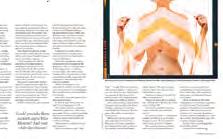
Auberon Waugh rages against the dying light


Willie Rushton by Barry Cryer
Richard Ingrams on Mr Toad
Peter Lewis on Laurence Olivier
John Craxton by John Hale
Gerald Scarfe on Yes, Minister


impasse was through Agatha Christie Limited (ACL), set up in 1955 to sort out her tax. Edmund proposed to Christie’s daughter Rosalind, a trustee, that ACL ‘buy the Bishop’s rights for £1,000. This would be enough to pay for the window and to pay the costs of the Bishop’s solicitors who are fussing about same in a most unspiritual fashion.’
His solution was effective – but capable of misinterpretation. The belief persisted in the congregation that the rights were snatched back because of the perception that the gift had been too generous. None of this frantic activity behind the scenes was evident when the window was installed in 1957 –without any indication of the donor, as Christie specified. After her death, Rosalind installed an explanatory plaque. In her autobiography, Christie concludes, ‘I am both proud and humble that I have been permitted to offer it with the proceeds of my work.’
All for JUST £6.95 including postage and packing
The Oldie November 2023 39
Christie’s window, Devon
128 pages of the best of The Oldie since 1992
TO ORDER: www.theoldie.co.uk/readers-corner/shop
A4 perfect bound HOT OFF THE PRESS Buy any Oldie book and get £2 o every subsequent book within that order
Sophia Waugh: School Days
An English GCSE changed a boy’s life
I have been very spoiled.
I’ve had a sneaky suspicion about this for a while, but this year has forced the fact to my attention. Since moving to this school, I’ve never not had a top set GCSE class. Some years, I’ve had two sets, and then it’s usually a top one and a set three.
This year, I have one and a half sets, and they are set three and four.
I’m not complaining; nor should I. Nevertheless, it’s a bit of a shock to the system. Where for years I’ve been chasing grades 7 (old style A) and above, for the next two years I’ll be praying for 4s and 5s. The potential grades of the students I teach this year and next range from 2 to 5, compared with my last Year 11, whose targets ranged from 5 to 8.
This year, my students don’t know the name of the Prime Minister, let alone the Latin for chicken. I wonder whether they even know what Latin is.
Maybe they have good reason; those facts aren’t going to help them much in life, but ignorance does lead to less good
conversation. Lessons are going to be more about the plot of Macbeth than questioning his existential difficulties.
We teachers love to list the pros and cons of having lower sets. On the positive side, they write much less so the marking is much lighter. On the negative side, behaviour is likely to be worse, so each lesson can be more of a struggle.


On the positive side, classes are much smaller. On the negative, they become even smaller as the children start to drift away, truanting or just missing more and more school for a variety of unconvincing reasons.
Above all, I’m going to have to work hard to enjoy these classes. I don’t by any means dread the classes, but they don’t engage my brain so much.
We are studying An Inspector Calls (as ever), and while they were suitably shocked and baffled by the denouement, they still struggle to remember who the characters are, never mind the difference between socialism and capitalism.
When I returned to school in September, I had half-made a lazy decision to treat this year, which is lower-school heavy (another first for me, I am usually given more older than younger classes), as a bit of a rest.
Do my best, but don’t kill myself, was my plan. Spend more time on the PhD I have started, on madness in Victorian fiction, and less on my students.
And yet. With the best will in the world (or the best lack of will), I don’t think I will manage to do this.
The first doubt about my ability to tread water for a year came when I told the students their projected grades. The disbelief and joy on the faces of boys told they should be able to get a 4 (‘But I’m rubbish at English, Miss. I’ll never pass!’) was a glorious sight to behold. And if they want to hit their target, I want to help them get there. It might prove hard, but it will be worth the struggle.
While I was vacillating between idleness and ambition, we had the Open Evening, where we parade ourselves in an attempt to charm and tempt the best of the future to come to our school next year. The last few years have been oversubscribed, and last year’s results were the best ever, so we probably don’t have to try too hard.
However, during this (very long) evening, I was approached by a parent.
‘You taught my older boy,’ he said, and named him.
Although he left at least three years ago, I remembered the boy, whose determination to pass English in the face of various difficulties had been admirable.
‘He’s in the army now,’ the father said. ‘He was the one who got his English GCSE and the rest are all having to resit it yet again. You changed his life. Thank you.’
And there it was. That old cliché of the recruitment advertisements: ‘Become a teacher. Change a life.’ It can happen. It does. And I’m going to bust a gut to do it again for my current crop of students.
40 The Oldie November 2023
‘Their feeding time should be in about 30 to 40 minutes’


Cavaliers and roundheads
Oldies like me born in the 1940s often reflect on changes they have seen.
Soft lavatory paper was an improvement on the hard Bronco, but you cannot fold it over a comb to make a harmonica. As for duvets, which we first met on European visits, we were sure they would never catch on at home.
Nail polish is almost universal now, whereas the headmistress of my sister’s school in Cambridge said that red nail polish was the first step towards prostitution. King George V called Wallis Simpson ‘a divorced American with painted nails’.
The attitude to smoking has utterly changed. And something else that seems to have gone out of fashion in my lifetime is circumcision.
I was born at home in 1945. It was before the National Health Service. The gynaecologist arrived in a Bentley and did the delivery himself. My mother asked if he would circumcise me.
This was then the general habit among middle-class families with boys, which I can confirm from the prep-school boys of the same age and class in the communal baths after games. The few who were not circumcised were called cavaliers, as opposed to the more prevalent roundheads – and were rather despised.
In his polemic Sad Little Men, the author Richard Beard made a similar observation about the boys at his prep school.
‘Amongst upper-class families, circumcision had been a health fad at the beginning of the 20th century, prompted by dusty Empire adventures in the Middle East, along with humidity issues nearer the tropics.’

He says that by the 1930s, two thirds of the boys at the leading public schools were circumcised.
Roderic Owen reinforces this in his confessional memoir Oh, What a Lovely Century. Of his first days at prep school in 1930, he writes, ‘My chief memory of boarding school (beyond the startling
discomfort) was that almost every boy, like me, was circumcised.’
George V, while objecting to nail polish, strongly supported the enthusiasm for circumcision among the virility-minded upper classes. He wrote in his diary, ‘I always knew it was necessary and now all the boys have no tops and look alike.’
I wondered how often circumcision had gone wrong with tragic consequences.
The late Lord Hailsham (1907-2001), the former Lord Chancellor, remembered how he was taken to the local surgery at the age of seven, before being packed off to prep school, to rectify a botched circumcision. ‘I was just flung across the doctor’s lap – and snip-snip! All I remember is the humiliation, the pain and all the blood.’
When I asked the young doctor looking after my son about circumcision, he looked at me as if I was mad and suggesting some kind of ritual genital mutilation.
I raised the question at a dinner party recently. Well, it was in that relaxed time when the ladies had withdrawn to stoke up the drawing-room fire and make the coffee. All the 11 elderly male guests had been circumcised.
At Harvard, I was in the undergraduate class of 1970. That’s where I learned that almost every American white middleclass male is circumcised – today’s figure is about 80 per cent. A Jewish classmate told me that in America doctors get paid to do it and it takes only a minute.
‘Where else can you make $500 in 60 seconds?’ he said. ‘And you get to keep the tip.’
42 The Oldie November 2023
When John de Bruyne was born in 1945, circumcision was all the rage – but now it’s got the chop
ALAMY
Final cut: The Circumcision by Parmigianino (1523)
The illiterate world of books
Literary festivals and book clubs have got little to do with reading a n wilson

Last summer, I was invited to the 40th anniversary of the Edinburgh Book Festival.
When I got there, my kind hosts told me I had attended the very first – making an appearance on stage with Martin Amis and John Updike, both now dead, alas.
I remember thinking, 40 years ago, how weird it was asking writers to sing for their suppers. Writing is an essentially solitary activity, and it is not realistic to expect that a writer – almost by definition an introvert – will be able to perform well on stage in front of an audience. Tolstoy never made a speech in his life.
Since then, literary festivals have mushroomed. There is scarcely a hamlet in the land that does not have one: and they clearly make money for the organisers, if not for the authors. (One seldom gets paid for performing.)
The format is nearly always the same, whether it is at one of the mega-festivals such as Hay or Cheltenham, or one of the more endearing tinpot equivalents. The author is asked to turn up an hour early for soundchecks etc. The audience, invariably oldies, shuffle in. The author holds forth, and afterwards signs the book being peddled.
The publisher usually reimburses the author for the train fare. The travel is going to cost at least 50 quid. I have never sold 50 books on such occasions, seldom as many as 20.
Of course, some authors manage to sell their wares. When I last went to the Buxton Lit Fest, selling about three copies of my latest book, I watched the queues forming of punters wanting a signature on Dr Lucy Worsley’s book about Jane Austen. She apparently sold 9,000 copies in one evening.
I would myself queue for as many hours as it took to possess Dr Lucy’s signature. I would crawl over broken glass for it. But she is the exception.
Clearly the publishers do not want us hacks to make these journeys for the sake of the money. You could not imagine any truly distinguished writer agreeing to appear at such an ‘event’. Try to imagine Jane Austen at such a gathering!
Dickens enacted his novels to huge audiences, but this was great theatre – something utterly different from the formula of the ‘literary festival’.
Some members of the audiences might be readers, but you don’t often get the sense that they are serious or obsessive readers, any more than you get the sense that the average Anglican congregation (often composed of the very same people, of course) is very religious.
Reading, like churchgoing, is on the way out. Most of the books I’ve sold at festivals have been signed as Christmas presents for unloved uncles or brothers-in-law (‘Can you put “For Ted”?’), and will go straight to the charity shop unread.
Far from being a sign that literature is alive and well, the proliferation of literary festivals is manifestly a symptom of the book’s decline. They differ totally from musical festivals, where the audiences are quite obviously engaged with music.
If you found your book as absorbing as a concert audience finds a quartet by Schubert, you would be at home, curled up on the sofa, munching an apple and rereading Mann’s The Magic Mountain, rather than paying to hear some ‘author’, untrained in public speaking, showing off about a book that is almost certainly of no merit.
Most get-togethers in the name of the book are non-literary. Book clubs are a case in point. Although there must be some such groups who actually read the book or at least make a stab at discussing it, that is not really the point of book clubs.
The point is for a group to get together over bottles of white wine to complain about their partners, or bitch about the absent ‘friend’ who happens not to be attending the meeting that month.
Literature courses at colleges are, for the most part, comparably unliterary. There’s a blazing row afoot at Bennington, Vermont, where the legendary Susan Cheever has been sacked after years of teaching creative writing. The programme director deplores the fact that the teachers on the course are ‘too old, too straight, too white’.
Cheever counters (she is suing for wrongful dismissal) by claiming that no one on these courses actually reads any more. ‘They’ve stopped reading. They talk about Joan Didion, but they haven’t read her.’
It is not just an American phenomenon. At a distinguished English university where I gave a talk recently, the professor told me that students can get a BA without reading anything at all ‘Most of my pupils opt for film,’ he explained.
Isn’t this only to be expected? As soon as you make the pleasurable recreation of reading into ‘work’, you somehow destroy it.
There are few more beautiful sights than the figure sitting on the bus and missing their stop because they are so absorbed in a book. You can be fairly sure that such a figure, especially if young, is not studying literature.
Nor would they ever dream of attending a literary festival.
Oldie Man of Letters
The professor told me that students can get a BA without reading anything at all
The Oldie November 2023 43
TV ghouls rush to Morocco earthquake
I looked with shocked disbelief at the live images of the Morocco earthquake broadcast on television.
I watch very little television – so I come to it as if from another planet. Days later, I still find myself querying the desirability of real (as opposed to fictional) disaster being used as entertainment.
What on earth were the camera crews doing, standing there filming close-ups of people who had been buried under rubble, sometimes for hours? Presumably their aim was to project the calamity and its accompanying heartbreak into people’s living rooms around the world.
But do these terrible disasters have to be on our screens for such great lengths of time? Do we need such details in our homes when we can give no practical or even moral support to those on site? And
does anyone give a thought to the people who may well not want the world to see them in their terrible pain and distress?
I know it is the duty of broadcasters to tell us what is going on, but I found myself wishing that at least some of the technicians who were actually there could have been seen helping to remove the debris or at least making tea for those hard at work amid the wreckage.
All this publicity generated immense sympathy and essential fundraising for the victims, which is wonderful. But there is a dark side to our fascination with such terrible misfortune. All too easily, we can start congratulating ourselves on our own safety. We then begin to ignore the horrors to which others are subjected. Forgetfulness and even boredom follow on all too quickly.
Years ago, I was stuck in an interminable traffic jam on the M4.
There had been a (minor) air crash, and people were flocking to the site to take a look. This ghoulishness was preventing the ambulances and rescue teams from getting through. Such voyeurism is plain immoral and does no good to anyone.
This sort of insensitivity is captured with succinctness and wisdom in Luke 16:21-31 – the parable of the rich man (Dives) and Lazarus. The rich man is very like some of the rest of us: there is nothing intrinsically evil about him. He just sees the misfortune of another in a vague sort of way and he doesn’t do anything to make things worse.
But neither does he put himself out to make things better when he certainly could do so. He is, perhaps, not very bright and with a poor grasp of cause and effect, as seen in the request from Hades that Abraham send Lazarus to warn his brothers. Too late, too late.
Memorial Service Andrew Edmunds (1943-2022)
A memorial service was held at St George’s, Hanover Square, for Andrew Edmunds, print expert and proprietor of Andrew Edmunds Restaurant and the Academy Club in Soho.

The staff of the Academy and the restaurant, alongside some of Soho’s finest surviving boulevardiers, bellowed out Jerusalem in his memory.
The Rev Roderick Leece took the service.
The wine merchant Matthew Jukes recalled his first visit to the Academy, founded by Auberon Waugh: ‘I was immediately struck by the shabbiness, the unique atmosphere, and the peacefulness of this beautiful building.
‘I loved the simple décor,
Andrew’s wonderful prints on the walls, his beautiful flowers and the quaint, dishevelled feel that permeated every inch of this tiny club.
‘It was heart-movingly honest, with a genuine and unforced sense of place, and, importantly, the food was sublime, seasonal, unfussy, emotionally charged and nostalgic, and the wine list was unrivalled in the value and provenance of its gems.
‘My first Academy long lunch ensued. It was dark when we left, and all I wanted to do was return as soon as possible – and Andrew and his troupe were the reason why.’
Sheila O’Connell, Curator of British Prints at the British Museum for 30 years, paid tribute to Edmunds’s scholarship as a
print-collector, dealer and connoisseur. Mark Cresswell, Edmunds’s godson, spoke of his skill with a fishing rod in the Hebrides, and his love and knowledge of wildlife.
Martin Gustavsson and Melissa Baker gave a tribute and a reading from Revelation 21.
Music by Handel included To Thee Cherubim and Seraphim, Funeral Anthem for Queen Caroline, the Nightingale Chorus from Solomon, Day by Day We Magnify Thee and the Hallelujah Chorus.
A painting by Hogarth, showing a riotous drinking scene similar to those enjoyed at the Academy Club, was shown in the service sheet.
Matthew Jukes reminded guests to raise a glass for Andrew Edmunds’s 80th birthday on the day after the memorial service.
JAMES HUGHES-ONSLOW
44 The Oldie November 2023
sister teresa
The Doctor’s Surgery Angels of death haunt the NHS

caring
Lucy Letby, Victorino Chua, Beverley Allitt: these are the names of nurses who, instead of caring for their patients, killed them.
Their motives were mysterious; no possible explanation seems adequate or satisfactory. We are forced back on that intellectual abdication, that they were simply born evil.
The same goes for Dr Harold Shipman, the infamous doctor who may have killed more than 200 of his patients. Only the feeblest of explanations of his conduct has ever been forthcoming, and he provided none himself. At what point, anyway, could we say, ‘Ah, now I understand’?
The doctor killers of the 19th century – for example, Dr William Palmer, known as the Prince of Poisoners – were less complex. They killed for money, which we can understand, even if we do not emulate.
There are millions of nurses and doctors in the world. It is inevitable that not all of them will be saints, and a few of them will be monsters. Having frequented criminals for much of my career, I came to think of human moral qualities as distributed round a mean, like natural qualities such as height.
Most of us on that distribution will be
within striking distance of the average; a bit better or a bit worse, perhaps, but, as we move further from the mean, both in the direction of good and that of evil, there will be fewer and fewer.
In other words, in any large population there will always be a few outliers, exceptionally good or exceptionally bad, saints or psychopaths. No conditions will eliminate evil altogether.
But does that mean we are helpless in the face of potential evil by our fellows?
I think it is possible for the whole distribution to move in favour of the good or the bad. The more it is moved in the direction of the bad, the more evil deeds will be done – but also fewer really good ones. It is possible for individuals to be vigilant against evil. Unfortunately, it is also possible for them to be hypervigilant – to denounce evil where no denunciation is deserved or justified.
This creates an atmosphere of distrust, which has its own deleterious effects. Patients need to be able to trust doctors and nurses; doctors and nurses also need to be able to trust patients.
When I look back over 50 years, I am glad to say that I met much more with exceptional good among my colleagues than exceptional bad – unless, of course,
the latter was successfully hidden from my eyes by the perpetrators of evil.
But everyone loves a villain, or at least a story about a villain, and so I will describe a consultant physician who, while not rising to the Shipmanian level of evil, was nevertheless very bad.
For one thing, he demanded payment from his National Health patients. They were mainly poor and they paid mostly in kind. You could tell the days of his clinics because there would be a succession of people arriving at the hospital with carrier bags of goods. I suppose that he, like Eurocrats, never had to pay for a meal himself. But the patients loved him.
He wasn’t even a good doctor. His junior doctor would tell his severely ill patients that they should go elsewhere if they wanted to survive, and he would put them in a taxi. But the worst was when I referred a patient to him because I had no one else available at the time. She returned with an account in her notes of what was a completely unnecessary vaginal examination. I was too young and uncertain to do anything about it.
It was easier to get away with such things in those days. On the other hand, I worked for superiors who were devoted to the welfare of their patients with a selfabnegation that is much rarer now.
Apparently, today’s our paper anniversary. Here’s the supplement
The Oldie November 2023 45
Lucy Letby isn’t the only monster in the
profession dr theodore dalrymple
The Oldie, 23–31 Great Titchfield Street, London, W1W 7PA letters@theoldie.co.uk
To sign up for our e-newsletter, go to www.theoldie.co.uk
Arresting Richard Harris
SIR: During the early 1970s, I was a Metropolitan Police sergeant, based at Kensington Police Station. It faced Holland Park, where Richard Harris lived in the famous Tower House, which has been the home of many celebrities.
We were often called, on night duty, to the nearby Kensington High Street where Richard could be found in his dressing gown, merrily directing traffic.
He was never charged with being drunk and incapable but was simply taken back to the station to sleep it off in one of the cells.
John Kenny, Acle, Norfolk
Robin Day v Nick Robinson

SIR: I read with interest the Old Un’s Notes in the October issue and the quote from Robin Day about interviewers: ‘I shudder to watch interviewers who think it is clever to be snide, supercilious and downright offensive.’
The previous morning, I had listened to Nick Robinson ‘interviewing’ the Prime Minister on Radio 4’s Today programme: the inimitable Robin Day would have shuddered to his boots.
Richard Coomber, Bexhill-on-Sea, East Sussex
Dad’s Salerno service
SIR: My father was at Salerno (‘Dad’s Salerno elegy’, October issue). The hospital ship on which he was serving with the RAMC was bombed and sunk.
It’s been suggested that American nurses on board in khaki uniforms led enemy planes to believe it was a troopship. In fact, there were POWs on board from both sides.
Returning to the UK, he reported the loss of his post-office book. The young counter clerk treated him with disdain. Her questions included ‘Do you know where it is?’
‘Yes,’ said my father. ‘It’s at the bottom of Salerno harbour.’
John Stringer, Harbury, Warwickshire
Brush up your Shakespeare
SIR: How good to read William Cook’s disenchanted review of the Globe’s As You Like It (October issue). We oldies who care about the Bard really do need to oppose the modern trend of directors rewriting our greatest dramatist.
I saw a production not so long ago of Antony and Cleopatra, in which Agrippa was played by a woman in the uniform of a high-ranking naval officer.
Historically the most masculine of men, a Roman of the old school – as Shakespeare would have known from his reading of Sir Thomas North’s translation of Plutarch – he is given in the play the utterly appropriate remark about the sexy Queen of the Nile ‘Royal wench! She made great Caesar lay his sword to bed;/ He ploughed her, and she cropped’. The production cut these lines completely, no doubt to suit the casting and modern sensibilities.
I suggest that, when a modern producer feels he or she has the right to wield the scalpel in this way, it is a case of putting their ego first and, in so doing, condescending to the audience. Such a person should consider Hamlet’s description of his uncle and realise who is Hyperion and who the satyr.
John Davie, Thurlestone, Devon
Mental rentals
SIR: In a recent article, Gyles Brandreth recalled watching TV from Rent a Set, a well-known company in the 1960s. It reminded me of a time when I was visiting Swindon and a couple of young assistants were dressed in what was the company ‘uniform’, a sort of overall.
One of them was a buxom lass and there, printed across her ample bosom, was the slogan Rent a Set. As I had my wife with me on that occasion, words failed me and I kept quiet. It seemed the safest thing to do.
Peter Harris, Norwich, Norfolk
Modest Stanley Matthews
SIR: The reference to Stanley Matthews’s gentlemanly qualities (Letters, October issue) reminded me of a sports day at the girls’ grammar school in Blackpool, which both I and Matthews’s daughter attended in the late 1940s/early ’50s. The fathers’ race consisted of dribbling a ball for 100 yards, and we all wondered what he would do. Sportingly he entered the race and sportingly he did not win it. He certainly was a ‘quiet, honest and modest man’ and greatly treasured locally.
Dorothy Woolley, Newark-on-Trent, Nottinghamshire
46 The Oldie November 2023
‘I’d hate to be a fly on the wall in that meeting’
Campbell in the soup
SIR: Duncan Campbell (‘London calling’, October issue) is mistaken about comparing This Is London to Down Your Way

The latter was a countrywide programme; the exclusively London version was In Town Tonight in which the ‘mighty roar of London traffic’ was stopped in order to interview ‘interesting people who are in town tonight’.
The interesting people were usually American film stars advertising their latest movie.
Who can forget the voice of the flowerseller offering ‘violets, lovely sweet violets’ for sale?
Tony Greatrex, Dinas Cross, Newport, Pembrokeshire
Byron’s poetic licence
SIR: The dog depicted in the painting as ‘Boatswain’ is not a Newfoundland breed of dog (Overlooked Britain, September issue). It may have been born in Newfoundland, but it is not at all like the other Newfoundland dogs described in the article as swimming with webbed feet, which sounds more like the true breed.
After the two dogs ferried Byron to the shore, what happened to the boat left in the middle of the lake? Rescued by a Newfoundland dog perhaps? Geoffrey Corfield, London, Canada
Extend your eyelashes
SIR: While I hesitate to contradict Mary Killen, she is wrong about eyelash extensions being a thing of the past.
My daughter-in-law has a business applying them and when recently she contracted Covid, at least two of her clients insisted on coming for their lash extensions anyway.
Katie Fforde, Stroud, Gloucestershire
Anthony Powell, wise owl
SIR: I was delighted to read Lady Antonia Fraser recalling Anthony Powell’s ‘care in getting things right’ (October issue).
Imagine, therefore, my disappointment when on page 25 of the Review of Books a picture of a barn owl is labelled as a tawny owl. You wouldn’t accompany a piece about Sir Bobby Charlton CBE with a photo of Sir Bobby Robson CBE on the basis that it’s close enough (both
‘Try turning everything off and then turning it back on again’
celebrated footballers from the northeast of England, who share the same first name).
Please take a leaf out of Anthony Powell’s book. Stephen Dean, Ipswich, Suffolk
Casting-couch memories
SIR: Madeline Smith (October issue) wrote that some producers ‘could make life unbearable for an actress unless she play footsie’ – a synonym for what we oldies knew as the casting couch.
While Madeline declined the advances of Richard Harris (who seemed genuine enough), there must have been scores of young, ambitious women prepared to do whatever in their bid for stardom, even if they were scared.
Therefore, this was a two-way ploy. So is it really necessary for those who think of themselves as victims to come forward and criminalise the male sex?
Why not let bygones be bygones? Molly Drinnan, Richmond TW9
Comforting A N Wilson

SIR: Of course A N Wilson has no reason to worry about his addiction to A Dance to the Music of Time (‘The strange decline of literary journalism’, October issue).
I have the same relationship with his
series, the Lampitt Chronicles, which I have enjoyed over many years and have recently finished rereading for the umpteenth time.
The characters are now like old friends, A N Wilson’s descriptions still make me laugh out loud, and the moments to ponder are still relevant today – the art of biographical writing, family, friendship and ever present religious and moral issues.
These novels have seen me through the best and worst of times, they are a go to self-help series, and in my old age I feel no shame at all in ‘basking in the familiar’.
Marjory Lumsden, Stirling, Scotland
The Oldie November 2023 47
‘I know I can’t
take
it with me, but can you arrange to hide it?’
I Once Met Joni Mitchell
It was the mid-1980s and I was in the Colston Hall (not a name to bandy about in these Black Lives Matter times) in Bristol, barely a stone’s throw from the statue of Edward Colston – in storage now after being dumped in the city docks.
I had come to see a concert by the Drummers of Burundi, then darlings of the world-music scene. The Drummers were brilliant but in the end their routines were repetitive … and my attention started to wander.
That was when I noticed a blonde woman in a dark beret sitting just in front of me, wreathed in cigarette smoke – in those days you could still smoke at gigs.
From behind, she was the spitting image of Joni Mitchell. But it couldn’t be, could it? What on earth would the doyenne of singer/songwriters be doing sitting on her own at a gig in Bristol?
Come the interval, I had to find out. There was a vacant seat next to her. And I climbed over and sat in it.
‘Er… are you Joni Mitchell?’ I asked –well, it was the best line I could come up with. Like many of us who lived through the sixties and seventies, the soundtrack of my life had included songs such as Joni’s Both Sides Now – and timeless bittersweet albums such as
Blue and Hejira. On 7th November, she will turn 80.
‘Yes,’ she said softly.
‘What are you doing here?’ I asked.
‘I came to see the concert.’
‘Have you seen them before?’
‘They played on my album The Hissing of Summer Lawns,’ she said.
I felt so stupid – it was the only Joni album that I hadn’t listened to.
‘Hejira is the one I play all the time,’ I said, honestly, and trying to change the subject. ‘But what are you doing here?’
‘I can only tell you if you don’t tell anyone else,’ she said.
I promised I wouldn’t tell. And she explained that she was in the UK with her then husband, Larry Klein, who
was doing some work at Peter Gabriel’s studio, near Bristol.
She said she didn’t have the necessary documentation to be working, but the implication seemed to be that she was doing so anyway.
She was matter-of-fact, charming and without superstar airs and graces. Because she was so natural, she seemed to remain almost invisible. Nobody else in the audience appeared to be aware of the icon in their midst.
The interval and our conversation were ended by the houselights going down. In the darkness, I said goodbye and climbed back to my seat.
When the concert was over, I had one last glimpse of Joni as she stood near the exit lighting yet another cigarette, while the crowd pushed past her. She seemed strangely diminutive and vulnerable.
I kept my promise not to reveal that she was working. But I can do that at last, because the story has now been told on Joni’s own website: of how, during that trip, she and Gabriel went into the studio to record a duet: the sublime – and perhaps aptly titled – My Secret Place.
Joni, who recently made a triumphant return to live performance, is still amazing. Happy 80th birthday!
 Nigel Summerley
Nigel Summerley
Cupid strikes in a jumbo-jet back row
shared liking for gin and tonic – and things started to look up.
My seat was at the very back of the Qantas 747 jumbo Sydney to London. So there was a good chance I would have a spare seat next to me.
Just as I was congratulating myself, I looked down the aisle and the last passenger to board was making his way towards me – bugger! He took his seat beside me, and I resigned myself to a cramped flight.
The clink of the drinks trolley gave us an opportunity to discover a
It takes a long time to cross the wide brown land that is Australia, but by the time we were flying over its northern reaches, we had covered a lot of conversational territory. He liked progressive rock. I didn’t. He didn’t like tracksuits. I wore a fetching blue one.
That trip from Sydney to London was under cover of darkness the whole way, which fosters intimacy and encourages revelations. As we resumed our seats for the Bangkok – London leg, it felt as though we had known each other for much longer.
I was beginning to fall for him. That cautious
voice reminding me of my existing relationship was silenced with the heady rush of feelings that signal romance. We talked, drank and smoked across India, the Middle East and shared our first kiss 35,000 feet above Cairo.
We came down to earth as we filed off that flight, bleary-eyed, into Terminal 4 in the dingy light of a wintry London dawn. We embraced passionately and vowed to meet again.
He did call and we spent a day in London, sightseeing replaced with gazing into each other’s eyes.
Naturally, there were complications, not least flying to Rome and ending my relationship with my
Italian boyfriend. His jealous rage was monumental. He emptied sugar into my new lover’s petrol tank. Sweet revenge indeed.
We married and had three children. He was the love of my life until I lost him early to cancer. Heart-breaking though it was to lose him so young, our happiness gave me solace. I never board a plane without remembering that flight and experiencing, however fleetingly, the thrill of our first encounter.
By Alison Cutler, Remuera, Auckland, New Zealand, who receives £50
Readers are invited to send in their own 400-word submissions about the past
48 The Oldie November 2023
Happy 80th, Joni!

Small World
Ideal present for Mother – a Dignitas brochure
Prone, but pain-free, Mother sits like a Bond villain in a bespoke electric lounge chair. Within her hi-tech but shadowy sitting room/villain’s lair, she whips out her orders.
‘Bring me a spoon,’ she shouts at Father. Moments later, she shouts, ‘The right spoon, not the wrong spoon.’
There is a minion in the corner of the sitting room. He came from social services to fit support rails some days earlier. He is now mending a Venetian blind for free.
He has a ‘Don’t ask’ glare when I approach him with an offer of tea, as if terrified to be noticed by the old gods who still have power in this strange place.
I approach Mother’s orbit. She swivels, with a whirring sound, to face me. It is all I can do to stifle a salute, such is the formality of her movement. It doesn’t help that she looks like Davros dressed by Damart.
I break the silence with a jaunty ‘Can I get you anything?’
She shoots that down: ‘You? What could you get me?’
‘Oh, I don’t know. Digestive? Portable fan? Dignitas brochure?’
She scoffs, quite correctly, ‘You’ll be dead before me from over-doctoring! Do you know when that pleasant French doctor came to the house, he had to be convinced I wasn’t you in drag, fiddling a home visit out of him.’
‘Not so pleasant, then,’ I said. I am currently embroiled in a psychological war with this Gallic gatekeeper of the good drugs.
This devilish Doctor D’Dordoyne makes a marked culturally Continental ‘pfft’ noise when I list my symptoms at the start of a consultation. The other doctors would at least pause for some seconds before they begin picking holes in my health history, but he denigrates from the get-go.
I recently demonstrated to him how my throat is aflame with strange, unconscious twitches, how tonally my voice has become croakier and inconstant. I normally sound like Nick Ross, I said, but I now sound
like Nick Cotton. Throughout, he ‘pfft’s almost continually, before chanting my name ‘Mr Clarke, Mr Clarke’ ever more firmly till I shut up.
Then he added, with effort-free ennui, ‘In all honestly, do you think that deep down what you are currently experiencing is simply a non-productive cough?’
Mishearing, I said, ‘Well I wouldn’t go so far as to call you a “cock”. But you are giving me strong non-productive vibes, yes.’
I thought of the great doctors I have loved, and what he could learn from them to be less cock-ish.
I said, ‘Take Dr Watkins. Always happy to investigate my symptoms. He couldn’t wait to shine his little lamp down my throat, even if it was an ankle sprain. Mind you, he was Welsh. So maybe it was just a mining thing.’
The doctor said nothing, turned round his laptop screen and beckoned me over to look at it. I noticed, as he spoke, that he may have picked up my illness. His voice was very dark and guttural, as if each word is more painful to say than the last: ‘Look at your medical record.
See on the screen how it goes on and on. Appointment after appointment, referral after referral, second, third, fourth opinions, all these words on and on. Do you understand why I am so frustrated?’
And now, suspiciously, some weeks later, he has put mother on heavy pain medication and has demanded she perform only the lightest of domestic duties.
I did ask him if he could meet me halfway and put her on medium pain meds so she could still perform moderate household tasks. He insisted that he was interested only in mitigating my mother’s pain and did not care ‘who folds and puts away your pullovers’.
I’ve googled the heck out of the Hippocratic oath. There is no pulloverfolding provision. But he can’t claim to ‘do no harm’ when he knows I’m going to look slovenly in the workplace once I’m in winter wear – if Mother is still more wheels than woman come Christmas.
Maybe that man from social services is still in the house – and is a dab hand at pullover-folding.

50 The Oldie November 2023
She may be in pain but surely she can still fold my pullovers?
jem clarke
STEVE WAY
‘If we have come to think that the nursery and the kitchen are the natural sphere of a woman, we have done so exactly as English children come to think that a cage is the natural sphere of a parrot: because they have never seen one anywhere else.’
That was Bernard Shaw setting out his feminist credentials in 1891. Shaw definitely meant well, and he even recognised that, often, the last thing women wanted was a man to do their speaking up for them.
Although he liked to think of himself as a challenger to John Stuart Mill in his support for women’s rights, he also boasted he was ‘as sound a Feminist as Mary Wollstonecraft’, the author of A Vindication of the Rights of Women (and the mother of Mary Shelley).
The historical novelist and historian Philippa Gregory would probably want to correct Shaw. In her new book, Normal Women, Gregory acknowledges how much women did ‘in the home’ in Shaw’s time and for hundreds of years before it. But her women’s history of England, from the Norman Conquest to the present day, also follows women in dozens of other settings, from ale wives to shipwrights, doctors to miners, with the odd queen thrown in for good measure.
Gregory subtitles her book 900 Years of Making History – and that, too, is arguing a case. For years, it was the great defence, particularly of (male) political historians, when confronted with the absence of women from their pages, that, sadly, the way society was organised in the past meant women didn’t very often ‘make’ history. With a shrug of resignation, they would argue that most of the time, history happened to women, not because of them.
That’s a very narrow view of what ‘making history’, even political history,

means. Yes, we are interested in the decisions people (mostly, in the past and still, men) took, but politics is about much more than that.
As Gregory points out, ‘one of the things [women] were almost all doing was rioting’. In particular, ‘poor women – women without names or a place in the record – were price-setting and rationing food’ when a bad harvest or suspected hoarding raised prices or reduced supply of vitals like grain.
The ‘moral economy’ – the idea that, particularly in the 18th century, common people were able to set the price of staple foods by their actions or threats of action – would never have existed without women. The historian who introduced the notion more than 50 years ago, E P Thompson, was well aware of the idea: ‘Initiators of the riots were, very often, the women’. Gregory focuses on it.
There has been a small flurry of popular women’s histories in recent years, from Jenni Murray’s History of Britain in 21 Women to Helen Lewis’s Difficult Women to the medievalist Janina Ramirez’s Femina.
It is seven years since the broadcast of Amanda Foreman’s series Ascent of Woman, of which the BBC might have made a bigger deal (it’s on iPlayer).
But there is still plenty of unexplored ground to cover. History thrives on returning and reinterpreting, on new arguments almost as much as new evidence. So it would be foolish to complain if some of the stories in Gregory’s book turn out to be familiar. Winston Churchill is pretty familiar, too, and that doesn’t stop books being published on him year after year.
Gregory’s book differs from many of the more recent examples of women’s history in the breadth of its gaze. It’s invigorating to read about 21 women, but women’s experience over time is the
experience of millions. As Gregory says, ‘The shortlists of women are too short.’
Some will disagree with Gregory’s overall argument. It broadly follows women dealing in various ways with a male-dominated society and it can lead her to some questionable judgements.
I don’t think it’s right to argue that the Bayeux Tapestry depicts the introduction of ‘allowable sexual violence arriving with the Normans’.

The Tapestry depicts sexual violence; but, since it was probably embroidered by women, it might actually be thought of as exposing those crimes.
As for Gregory’s remark that ‘the England [William] invaded was a subsistence economy with little use for coins’, most Anglo-Saxon historians, women or men, would surely disagree.
England in 1066 was one of the richest countries in Europe, with what one expert calls a ‘formidable currency’.
Any book of the scope and ambition of Gregory’s is bound to invite nit-pickers. But the stories it has to tell need to be told, and to be heard by as many of us as possible.
Normal Women: 900 Years of Making
History by Philippa Gregory (William Collins) is published on 26th October
The Oldie November 2023 51
A woman’s lot was not a happy one
Philippa Gregory’s new book is studded with revelations – and errors
FUNKYFOOD LONDONPAUL WILLIAMS / ALAMY STOCK PHOTO
david horspool
History
A stitch in time: the Bayeux Tapestry
Books






Drunk on fame
JONATHAN MEADES
Erotic Vagrancy: Everything about Richard Burton and Elizabeth Taylor
 By Roger Lewis Riverrun £30
By Roger Lewis Riverrun £30
According to Roger Lewis, Anthony Burgess ‘wrote millions of words to conceal the fact that he was no good as a writer’.


Lewis might have amended this formula to accommodate Richard Burton, who acted in dozens of straight-toSunday-afternoon-telly films to conceal the fact that he was no good as an actor.
He might have. But he didn’t, for he adores Burton. When, that is, he is not ticking him off for shopping like Croesus, drinking three bottles of vodka every day (‘I go mad on gin’) or slagging off Laurence Olivier (‘a shallow little man with a very mediocre intelligence’), Maria Callas (‘those tiny button eyes in that great arse of a face’) and John Huston (‘a simpleton’) and spouting racist antipathies, which were altogether conventional in the 1950s and ’60s: ‘I don’t like Negroes.’
Burton complained that the slaves in Cleopatra were not black enough. So they had to be painted blacker. ‘I don’t like Jews, nor Russians, nor Italians … the only people I do like are the Welsh.’
But when he takes Taylor in a Rolls-Royce to pick over his ‘roots’ in Pontrhydyfen, the sanitary facilities are found wanting. As Lewis has it in this glorious sentence, ‘The lavvy was a tidy step, so Taylor was handed a personal pisspot’ – which she undoubtedly needed after winning over the locals by knocking back pints at the Miners’ Arms.

She sportingly permitted the citizenry ‘to slap her flank and examine her teeth,

as if she were prize bloodstock’. No ‘as if’ about it. She was. She was also royalty. He was, too, but consort level.








Burton pursued and married Taylor because, as Truman Capote rightly bitched, ‘He wanted to be a movie star: money money, money.’ He threw away his talent (was it really that special?) to make a career in films that were invariably forgettable dogs.
But, given the chance, who wouldn’t swap the never-ending chore of theatre and its tired lore – having to call
Macbeth ‘the Scottish play’ at, say, the National beside the sewage-rich Thames – for dazzling seas, yachts, caviar by the cwt, gold and more gold (make it chunky), a gaudy caravan of flunkeys, medical orderlies, pockmark-fillers, wig-wranglers, depillators (‘with Welsh gallantry, Burton nicknamed her Monkey Nipples’), mixologists (as they were not yet called), shoppers, scent consultants, lawyers, dressers, dressers’ dressers and spontaneous quip-writers.
Then there were the dozens of villas,
GARY WING 52 The Oldie November 2023
Bottoms up: Richard Burton and Elizabeth Taylor
sprawling hotel suites, doffed hats, curtsies, secretarial horizontales, a distillery, cue cards (no need to learn lines – no doubt difficult for the lavishly bladdered) and an internally marinating liver.
They were greedy people, avaricious people. He was a scowling, morose drunk, a colliery Faustus. She was a hysterical junkie in a psychedelic onesie who craved excess, who was ‘constantly drinking from a champagne bottle’, whose dressing room was ‘a witch’s lair’. At one of her post-Burton weddings, her bridesmaid was Michael Jackson’s chimpanzee Bubbles.
She single-handedly supported the Swiss pharmaceutical industry. She almost certainly suffered Munchausen’s syndrome. There was – no matter how much doctors of countless specialisms might seek it – no cure for being Elizabeth Taylor; no cure for BurtonTayloring, a ’60s play on the high-street chain of gents’ outfitters.
These two imperially self-important exhibitionists fused to make a monster of anomie fit only for creepily fawning chat-show hosts such as Parkinson and startlingly over-budget vehicles to solace their wounded vanity.
‘They stood alone.’ Not entirely –she had to have her stomach pumped so often that the staff at a private hospital in Rome were ‘standing by with their hoses and nozzles aimed in permanent readiness’.
His subjects’ weakness for glut and superlatives occasionally infects Lewis. He writes that Burton’s Leamas in The Spy Who Came in from the Cold is ‘as great as any performance in the history of cinema’. Greater than Welles in Touch of Evil, Delon in Le Samouraï, Chaplin in Monsieur Verdoux, McCambridge in Johnny Guitar and Sellers in Dr Strangelove?
Unlike these actors, Burton was not ‘transformative’. He was at the other end of the spectrum from Alec Guinness. He was declamatory, unable to escape his oratorical refuge. His range was limited.
‘I can’t help the voice’ is a falsely modest boast which is equally an unwitting admission of failure, though the awed Parkinson didn’t see it that way and encouraged Burton to do a monumentally torpid party piece: Olivier as Richard III, which would no doubt have amused the boys in the valleys.
But then movie stars, unlike actors, are required to be rather than to do. Taylor was an exception. She was an actor and a movie star.
Burton was not a modern actor. He
was, astonishingly, a contemporary of Brando, Newman, Steiger and Curtis but he belonged to a different age.
As well as a whiff of Lady and Sir Bernard Docker, Diana Dors and Sabrina, he brought with him from the 1950s the ghosts of his precursors, a generation his senior, bellowing pre-war hams, of which the hammiest were Donald Wolfit, Robert Newton and Charles Laughton.
By the time he and Taylor became a brawling eye-scratching item during the chaotic shooting of Cleopatra, lumbering epics and stagy cinema were hopelessly vieux jeu and tiresomely risible: Truly this was the son of gawd.
Yet Burton was stuck in that multimillion-dollar, middlebrow milieu and would remain there in perpetuity, grand and arid; so grand that he declined an invitation from the comedian Stan Stennett to play Baron Hardup in Porthcawl’s panto. ‘Impossible, of course.’
Of course. Why of course, asks Lewis. He suggests, more or less persuasively, that by 1971 Burton was remote from any conception of the strolling player. His outgoings were so large that he claimed he couldn’t do Equus on stage in New York for $10,000 per week.
When the gilding is all attrited, you’re left with a cage. And that’s why his CV includes The VIPs, Where Eagles Dare, The Wild Geese, The Longest Day and a further selection of stinkers, in which late-middle-aged actors pretend, unconvincingly, to be gung-ho soldiers in their twenties: they are probably cases of appropriation.
Taylor fared better. But the clamorous
culmination of their conjoined art, Who’s Afraid of Virginia Woolf?, is mildly interesting for nothing other than the overlapping of the characters’ messy lives and those of the fraught players. Such appeal is paltry.
Roger Lewis is a terrific biographer. He doesn’t so much stretch the conventions of the form as ignore them. He is speculative, biased, subjective and prone to treat the famed couple in the manner of a sadistic puppet master. He does not go in for ‘responsible’ biography. He is not out to make friends. He is very funny indeed, cruel, exhilaratingly inhumane.
Were his trashy subjects alive, they’d bottle him.
Jonathan Meades trained at RADA
Le Carré’s dirty linen
JASPER REES
The Secret Life of John le Carré
By Adam Sisman
Profile Books £16.99
Halfway through Adam Sisman’s 2015 biography of John le Carré, something odd occurs. The book simply shuts up shop. You can all but hear the rattle of the roller shutter as if it’s half-day closing.
How did this happen?
The short answer is that David Cornwell (le Carré’s real name) got married again. Previously, at the fag end of his first marriage, he had been rambunctiously playing away with Susan Kennaway, the wife of his bosom friend James Kennaway. Both men got novels out of the ménage, and Sisman a lively chapter. Enter Jane, the second Mrs Cornwell.
In the biography, and now in The Secret Life of John le Carré, Sisman describes working on the archive at the novelist’s home near Land’s End (now up for sale), when he becomes aware of a shadow. It is David (as Sisman calls him), but it easily might have been Jane nervously proscribing all reference to her husband’s amours.
In the biography, it is as if le Carré never had any sex after 1972 outside the marital bed. It turns out some nonmarital sex was also had in said bed. Other sex was in a son’s bed. Or a safe house. Or abroad.

‘You know you’re getting old when you have to look at the clock to see if it’s late enough to go to bed’
A nanny once sensitively asked Jane if her husband’s many research trips were hard on the marriage. ‘Oh, no, no. That was all with Ann,’ she chirruped. (Ann was the first wife.) ‘He’s learned his lesson!’ Le Carré, 46,
The Oldie November 2023 53
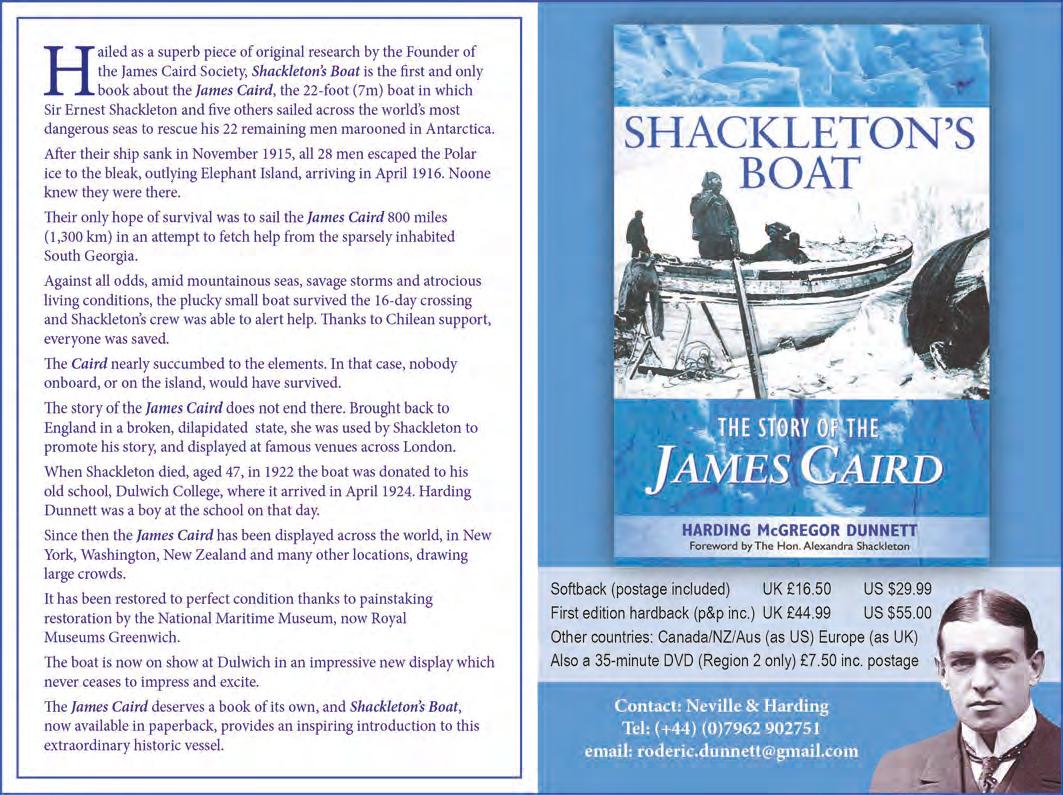

promptly took the nanny, 22, to Bruges and impregnated her.
This is a book – a vast appendix, in truth – about le Carré’s lies. A scintillating pamphlet on the vexed art of biography, it also reads as Sisman’s cold, dogged revenge for being gagged by a subject who in theory welcomed a warts-and-all life. Then, as his biographer conscientiously disinterred more and more skeletons, he disabled it by all manipulations at his disposal, including the threat of suicide.
‘Oh, God!’ le Carré groaned when Sisman told him he’d heard about Sue Dawson. The rest of us would hear about her when, semi-disguised as Suleika Dawson, she published a book about their affair.
Dawson unblushingly takes the reader between the sheets and makes all of us gawp at her Priapus’s mighty undercarriage. Sisman, who has interviewed her and five other women (two declined to talk; three others are dead), stays properly and politely outside the bedroom door.
His quest, rather than to re-enact the actual action, is to clarify how these women fetched up in the novels – and also to peer deeper into the dark labyrinthine hollows of a writer whose subject was betrayal.
A key le Carré left for unlocking the mystery was his roman-à-clef A Perfect Spy. ‘We betray to be loyal,’ reasons its (anti-)hero Marcus Pym. Le Carré’s gift for infidelity was rooted in childhood chaos: the absent mother who abandoned the young David; the crooked father who made lying look as easy as breathing. After such a start, how could any boy grow up to be faithful?
Le Carré even presented his biographer with a comprehensive list of reasons for his philandering (depression, no self-esteem, never-ending search for love, fury at convention etc).

Perhaps another motive went unspoken. Le Carré was in the habit of seducing other men’s wives, and two of those men were literary novelists who scorned spy fiction.
‘Oh yeah?’ le Carré’s unconscious seems to have said as, unbuttoning his flies, he struck a retaliatory blow on behalf of all genre writers.
He could sniff opportunity with fox-like cunning. Once a stalker groupie left her details in Cornwall while the Cornwells were away; he was soon drumming up an excuse to fly to Louisiana so he could romance her. ‘She was my ideal reader,’ he sighed.
Not all adulteries were so transactional.
Another American woman wrote that she was a fan. A sweet epistolary romance bloomed across a whole year before he engineered their one lone encounter. (Sisman learned of her only when le Carré’s letters, edited by his late son Tim Cornwell, were published in 2022.)
Meanwhile, the first marriage is not neglected. There was a dalliance with a married woman in Bonn when le Carré worked for MI6. In the biography, this was blamelessly unconsummated. Here, it isn’t.
Earlier, when at MI5, he seduced his engaged secretary Liz Tollinton, who never married and carried a torch for him to her grave. ‘It is to my infinite regret,’ seethed her mother, ‘that she wore your ring until she died.’
When he specifically warned his biographer against writing about this extramarital debut, he argued that it was to spare his sons. Sisman now reveals that it was to spare his own blushes.
Eventually the libido sagged and, besides, the spy writer came to be spied on as closely as any mark. ‘I live in a high-security household,’ he testily advised one ex. ‘I have no structure for independent movement.’
The marriage was a prison he couldn’t bear to escape. His jailer was not his muse – that was the job of the mistresses, whom he often thanked for putting lead back in his pencil.
Absent from the novels, his wife fulfilled the different but vital role of office manager. ‘You need a bourgeois woman like Jane,’ le Carré told a friend. ‘She’s the only woman I can write around.’
With all the others, he was too busy.
Jasper Rees wrote Let’s Do It: The Authorised Biography of Victoria Wood
Cry God for Harry
CHARLES SPENCER
Agincourt: Battle of the Scarred King
By Michael Livingston Osprey £20
The tale is a familiar one – of a beleaguered and outnumbered English army, led by the heroic Henry V, trouncing the ‘flower of French chivalry’ through bulldog tenacity and withering volleys of longbow arrows.
Shakespeare used this, the ultimate victory-against-the-odds, as the backbone of his Henry V. Winston Churchill encouraged Laurence Olivier to make a stirring film of the same, as a morale-booster in the Second World War. It was filmed during the months that saw D-Day blossom into the Allied invasion through Normandy. Agincourt is a story that has made the English proud, for more than 600 years.
There have been many excellent books on the battle. In recent times, Juliet Barker’s Agincourt and Bernard Cornwell’s fictional Azincourt have led the charge, while in 1976 John Keegan’s outstanding The Face of Battle looked at Agincourt (as well as Waterloo, and the Somme) in great detail.
While there doesn’t have to be a good reason to add to the canon, it certainly helps attract the reader if something novel is on offer.
Michael Livingston is an American who claims that his reading of contemporary sources – his study of manuscripts and battle plans from the archives – and his ability to understand landscape are what prompted his new book. It is also a follow-up to his wellregarded study of Crécy (he recounts that battle once again here, in a couple of pages of vivid distillation).
Livingston brings a particularly American freshness to these ancient tales of knights, men-at-arms and archers.
The site of Agincourt has never been established through archaeology, Livingston contends, before concluding that it was fought to the west of where the battle’s tourist trade takes you today.
If that’s correct, the cut-out archers punctuating the Agincourt landscape are standing in the wrong fields. This matters to Livingston because, he states, ‘I believe, truly and sincerely, that a battle is its ground.’
The author leavens his thesis with interesting snippets from this period. The subtitle of this book is Battle of the Scarred King. One of the earliest sections deals with the wound that
The Oldie November 2023 55
A most wanted man: John le Carré

scarred the future Henry V as a lad, 15 years before Agincourt, when he was felled at the Battle of Shrewsbury.
Ironically, given that they are the weapon and the combatant we most readily associate with his great victory, Henry was hit that day by an arrow drawn by a Chester bowman. The arrowhead snapped off and became embedded six inches into the prince’s skull. It had to be extracted if Henry’s life was to be saved.
John Bradmore, a London surgeon, spent many days teasing open the wound, keeping it clean with honey, conifer resin and wine, before successfully pulling the arrowhead out with cleverly constructed tools. This tale of medieval medical brilliance illuminates the early part of this book.
The rest of the work is an unusual mixture. The well-known historical facts are all here, from Henry V’s accession to the French throne in 1413, through the well-chronicled battle and into the remaining seven years of the victor’s life. The heroic king was snuffed out, while still a young man, not by a sword, arrow or lance, but by dysentery.
But if this book is a historical account, it is not a traditional one.
At its creakiest, it sometimes feels like one of those lower-budget historical documentaries you stumble across late at night, when flicking through the TV channels looking for something Hitleresque to watch. Medieval armour is tested out for its fallibility. The distance of the unleashed volleys is laid out in columns on the page. This is as much a scientific study of Agincourt as it is a non-fiction account of the battle.
The language used by the author has a similarly modern feel to it. Some of it works well: you feel the approaching doom of the ‘dismounted French men-at-arms … trudging forward through the mud. It would have already been exhausting work, but the cavalry ahead of them had churned the field into a pockmarked morass.’
There are less successful passages, such as when he describes the ransom the English sought, in exchange for the freedom of the captured Jean II of France:
‘We’re talking something in the order of $800,000,000 today.
‘That’s a lot of cash.’
Some readers will enjoy that sort of lightness and approachability. Others will find it jarring – perhaps even verging on crass.

The book might have benefited from a better copy-edit. There are words missing, and there are repetitions. When looking at Henry’s youthful arrow wound, we read, ‘It’s hard to imagine the agony,’ and ‘It is hard to imagine the trauma,’ alongside ‘a trauma that is hard to imagine’, all in the space of just over a page. Such carelessness can distract the reader.
That said, if you love your Henry V, and relish tales of medieval resilience, or the timeless aspect of the grimness of war, this is an original and fresh take on one of the great battles of European history.
Earl Spencer is author of The White Ship: Conquest, Anarchy and the Wrecking of Henry I’s Dream
Brothers in arms
WILLIAM STIRLING
2SAS: Bill Stirling and the Forgotten Special Forces Unit of World War II
By Gavin Mortimer Osprey £25
Bill Stirling was my beloved grandfather, who loved to rag around with my brother and me as kids at Keir, his Scottish estate.
Sadly, he died when I was just 16, before I had the wit to ask him about the war. So I was looking forward to Mortimer’s book about him and 2SAS Regiment, its teething troubles, failures, and successes in raiding behind enemy lines in the Second World War.
Formed in 1943, 2SAS was the younger brother of the SAS Regiment, which had been founded in 1941 by Bill’s
own younger brother David Stirling. Like the original unit, 2SAS lived off their wits, on missions where reaching their objectives was as dangerous as fighting the enemy, and where the penalty for failure was death. Not capture or death but capture and death, thanks to Hitler’s kill order regarding commando units.
If you wore a maroon beret and were parachuted tens of miles in front of an advance, you were treated as per the Geneva Convention. If you wore a beige beret with SAS insignia and parachuted 50-100 miles behind the lines, you were interrogated and summarily shot. In the desert, the Afrika Korps disregarded this order, but on mainland Europe it was effected without compunction.
Mortimer does justice to the men of 2SAS, and brings home the price of adventure as well as the thrill.
The major flaw undermining this book is that the author has got it into his head that Bill – not David – Stirling was the real founder of the SAS. Yes, Bill was in Cairo when David (my great-uncle) had the idea – or David and Jock Lewes had the idea.
No doubt David consulted Bill during the planning stage: Bill had been central to the development and training of the commandos, and the brothers were close. But by the time of the first SAS operation, Bill had left Egypt for Britain. Claiming that Bill was the real founder of the SAS does a huge disservice to both brothers. Bill would have been furious to be used as a stalking-horse to slander David.
I had hoped there would be far more detail about Bill, particularly the journey that took him to perhaps his bravest act of the war – his blazing row with General ‘Boy’ Browning about how 2SAS was to be used on D-Day. Browning ordered that the lightly-armed SAS – instead of being infiltrated deep behind enemy lines, as they were trained to operate – be sprinkled ahead of the invasion, in front of the enemy Panzer reserve.
Bill refused point-blank, on the grounds that it was both suicidal and futile. As a result, Bill was kicked out of the Army (‘bowler-hatted’), but he persuaded his officers to back his successor, Brian Franks, to make the same case. Franks succeeded, and the SAS were used on D-Day as their founders had intended, causing mayhem deep behind enemy lines. Bill’s personal sacrifice saved a lot of lives.
Bill’s role in the development and training of the early commandos is not pursued at all; nor is his role in SOE, nor the action he saw early in the war.
2SAS was born in late 1942 for
The Oldie November 2023 57
‘Fast lane? No, I live life in the “Closed for repairs” lane’

the Torch landings in Algeria (the Anglo-American pincer movement against the Afrika Korps). It was redesignated from 62 Commando, which Bill was then commanding.
The SAS was briefly nicknamed ‘Stirling and Stirling’ before David’s capture in January 1943. Bill faced all the struggles that David had in establishing his unit – a dearth of recruits and obstruction from Army HQ staff.
After the use of small boats in their early raids on islands near Sicily ahead of the Allied invasion, Bill soon reverted to the original infiltration method of the SAS, namely parachute (which David so mistrusted after the SAS’s disastrous first drop in 1941).
Bill himself, after taking command, did not go on operation: wise, considering his full-time planning role made him a walking encyclopedia of special-forces intelligence and tactics.
The book gets going describing 2SAS’s operations in Europe, showing the unit’s shape and spirit. There are too many characters (such as James ‘Big Jim’ Mackie and the maverick Roy Farran) to pull out here but, as in the original SAS, there was an attraction to this type of warfare for the unconventional.
This is not a biography of Bill Stirling, whom the author finds hard to penetrate. Bill never talked about his war, whereas David, much to his embarrassment, got a lot of publicity (despite his always stressing the collaborative nature of the SAS).
My advice is to treat every pronouncement about David (whom Mortimer regards, wrongly, as incompetent or worse) as false, but to enjoy this book as a record of 2SAS.
Keep on rockin’
DAVID HEPWORTH
Holding the Note: Writing on Music
By David Remnick
Picador £16.99
If there was ever an occupation that should be impossible to pursue into your senior years, that occupation is rock star.
And yet here they remain. Paul McCartney headlined Glastonbury last year at the age of 80. When Mick Jagger marked the same birthday recently, it was front-page news – as was the new Rolling Stones album, Hackney Diamonds

When I’m 64-plus: Paul McCartney, aged 80, Glastonbury, 2022. He played for more than two hours
It seems these people are as famous as they ever were. Not that they planned it that way.
‘Hope I die before I get old,’ was the way Pete Townshend put it 60 years ago on the Who’s My Generation. The Who are still going, albeit without two of their original members. Interestingly, Townshend is one of the few male stars of the Sixties who has been careless enough to lose his hair. Everybody else seems to have found a way of hanging on to theirs. Make of that what you will.
David Remnick is the editor of the New Yorker and a music enthusiast. This has put him in an ideal position to profile some of these lions in winter.
Holding the Note is a highly readable collection of pieces written for the magazine in the past 20 years.
This has been a time when many of these performers have enjoyed the lap of honour permitted to those careful enough to be living legends rather than the other kind. And why not? ‘The older you get, the older you wanna get,’ as Keith Richards sagely observed.
The accident of demographics means that most of them have been more celebrated in their later years than they were back in the noonday of their fame.
The kind of celebrity enjoyed by Bob Dylan, Aretha Franklin and Patti Smith seems to have an extra ingredient, having been won back in the day when you had to do quite a lot to earn it. It seems we never get tired of hearing them tell their old stories.
This is just as well: when the spotlight shines on them in their sixth or seventh
decade, it’s more likely to be as a result of an autobiography or a retrospective film than because they’ve written a hot new tune.
They are still visited by the blues from time to time; it’s just that they tend to be a better class of blues.
Late in life, Leonard Cohen went back on the road to earn back the money his business manager had purloined – and then liked it so much and made so much money from it that he prolonged his last waltz for years. Patti Smith had to be encouraged back on the road following the deaths of her husband and brother.
They are also musicians’ problems. Bluesman Buddy Guy complained that his wives didn’t like him being home when he wasn’t doing well and resented him being out on the road when he was. Musicians like the idea of a full date book more than anything else in their lives.
The truth about rock stars rarely emerges from their mouths. It’s far more likely to be gleaned from the details of the things they do, and Remnick’s book abounds with such observations.
Aretha Franklin collected her fee in dollars before beginning a performance, and the handbag containing the cash would remain on the piano in plain view as she sang. Franklin cut up rough when Beyoncé introduced Tina Turner as ‘the Queen’ because she felt that honorific was hers alone.
Dylan demanded to be on the cover of the New Yorker, probably because he knew such a thing was absolutely never done. Guy, who
The Oldie November 2023 59
William Stirling is a writer and a grandson of Bill Stirling


liked to be thought of as the last living blues man, had a Ferrari on his drive.
David Remnick was the first to notice that McCartney wears a very subtle and no doubt very expensive hearing aid. Remnick was also on the receiving end of a humiliating dressingdown from Cohen when there was an innocent misunderstanding about the time of a meeting.
When Vini Lopez was fired as the drummer of Bruce Springsteen’s early band, he asked for a second chance and was told by the bandleader who he thought was a friend that ‘there are no second chances’.
Fans like to think that were they to go for a drink with their rock-star heroes, they would get on like a house on fire. The truth is none of them got where they got by being easy-going. To remain at the top long enough to reach old age took something sterner.

David Hepworth is author of Abbey Road Studios at 90
Thrilling French letters
NICHOLAS LEZARD
The Letters of Gustave Flaubert
1830-1880
Edited and translated by Francis Steegmuller
NYRB Classics £23
I can remember where I was sitting when I first read these words, written by Gustave Flaubert to his mistress, Louise Colet: ‘Ever since we said we loved each other, you have wondered why I have never added the words “for ever”.
‘Why? Because I always sense the future, the antithesis of everything is always before my eyes. I have never seen a child without thinking it would grow old, nor a cradle without thinking of a grave. The sight of a naked woman makes me imagine her skeleton.’
I was in my room at university, and I was 19. Flaubert wasn’t really that much older. As a young man, I was deeply impressed by this worldliness. Now I am not a young man, I still am impressed, but in another way: when I see a cradle or, in vanishingly unlikely circumstances these days, a naked woman, I do not think of a grave, or a skeleton. I think of Flaubert thinking of a grave or a skeleton.
And I think this is what Flaubert might have wanted: for people to think of him thinking, to be aware of the literary artifice.
For that was always important to him. Towards the end of his life, he was revered by the self-described new generation of ‘Naturalists’: writers such as Huysman, de Maupassant and Mirbeau, who prided themselves on their realism, and took Flaubert as their inspiration.
He was wined and dined by them –dishes included potage purée Bovary, poulande truffée à la Saint Antoine, artichaut au coeur simple etc.
He wrote to Turgenev later, ‘Reality should be only a springboard. Our friends are convinced that in itself it constitutes all of art. Such progress! A bunch of jokesters, trying to delude themselves and us into believing that they discovered the Mediterranean.’
Flaubert (1821-80) did not himself make old bones, but he thought like an old man – the best kind of old man, that is. Writing to Colet, he said he much preferred it when their meetings were not too tempestuous: ‘It is like riding: there was a time when I loved to gallop; now I let my horse walk, and the reins lie loose. I am growing very old; every jolt upsets me, and feeling is as repugnant to me as action.’ Guess how old he was when he wrote that? Twenty-nine.
To go back to my undergraduate self: I wasn’t even studying French. I was studying English, but my director of studies told us that our degrees would be worthless unless we read Flaubert – and not in translation either, unless absolument nécessaire. We were allowed to read the letters in translation, though, and these came in the form of two large, unwieldy paperbacks, one pink, one blue; rather like, I thought at the time, the Beatles’ Red and Blue albums.
But, unlike those recordings, which went from youth to maturity, Flaubert’s
letters went from maturity to maturity. And the thing about his letters was that once you started reading them, it was very hard to put them down, even as an impatient student.
This is the same edition, now in one volume. The division is maintained, though, so halfway through the book we get the Appendices to Vol I. My favourite is Appendix II, called simply Flaubert and Syphilis
Oh yes, there was a lot of it about. He probably picked it up as a 17-year-old schoolboy in Rouen, and there followed a lifetime of ‘laxatives, purges, derivations [cupping or blistering], leeches, fever’ and, of course, mercury; the old joke had it that you spent one night in the arms of Venus and the rest of your life in the arms of Mercury
There is an incredible amount of salacious material in his accounts of his travels in Egypt. Yet these dirty bits are written with great good humour as well as a wicked desire to scandalise: boys, women, what you will – no holes barred.
He writes, ‘One admits one’s sodomy, and it is spoken of at table in the hotel. Sometimes you do a bit of denying, and then everybody teases you and you end up confessing.’
There is more to Flaubert than this, of course. This book contains more insights into literary art than many works of criticism – and it is art itself. It is perhaps the single most important collection of letters to be published, and this among strong competition.
It is an essential part of every civilised library, and I am delighted that NYRB has decided to reprint it.
Nicholas Lezard is author of It Gets Worse: Adventures in Love, Loss and Penury
The Oldie November 2023 61
‘Regarding my art collection, I know what I like’


I took my mother-in-law to Madame Tussaud’s Chamber of Horrors. One of the attendants said, ‘Keep her moving, sir. We’re stock-taking.’
Les Dawson



Brevity is the soul of lingerie, as the Petticoat said to the Chemise.
Dorothy Parker
How different, how very different from the home life of our own dear Queen! Said of Queen Victoria at a performance of Cleopatra by Sarah Bernhardt
Commonplace Corner
If it doesn’t look easy, it is that we have not tried hard enough yet.
Fred Astaire

A fan club is a group of people who tell an actor he’s not alone in the way he feels about himself.
Kenneth Williams
A good general rule is to state that the bouquet is better than the taste and vice versa.
Stephen Potter on wine-tasting
The House of Commons starts its proceedings with a prayer. The chaplain looks at the assembled members with their varied intelligence and then prays for the country.
Lord Denning


You mustn’t force sex to do the work of love or love to do the work of sex.
Mary McCarthy, 1962
All my friends started getting boyfriends, but I didn’t want a boyfriend, I wanted a 13-colour biro.
Victoria Wood
He may have hair upon his chest but, sister, so has Lassie.
Cole Porter
What will be one of the worst problems people will have in the millennium? It
relaxing swim? Forget it. Recently, at my local pool, a group of women, standing in the water, were having a nice chat, blocking the pool for swimmers. Nearby, a young couple were enthusiastically snogging in a swimming lane.
will probably be the tendency to gain weight! There will be such an abundance of food and drink that some people are very likely going to grow a little too fat.

Patricia Highsmith, People Who Knock on the Door (1983)
There is many a boy here today who looks on war as all glory but, boys, it is all hell.
General Sherman in a speech in Ohio after the American Civil War
King’s Moll Reno’d in Wolsey’s Home Town.
American newspaper headline after Wallis Simpson’s divorce in Ipswich
To betray, you must first belong.
Kim Philby, 1967
I wanted the simplest, dullest, plainest-sounding name I could find. James Bond was much better than something more interesting like ‘Peregrine Maltravers’. Exotic things would happen to and around him but he would be a neutral figure – an anonymous blunt instrument wielded by a government department.
Ian Fleming

Strategy is buying a bottle of fine wine when you take a lady out for dinner. Tactics is getting her to drink it.
Frank Muir
Swimming pools
Remember swimming pools years ago? They were fun and safe for swimmers and learners, because ever-watchful attendants with whistles warned us at the slightest misbehaviour and would throw us out if we continued.
Fast forward to today. Pools have increasingly become aquatic obstacle courses. Try to enjoy a
I fumed and stormed out of another one where lots of hyped-up lads were throwing one another across the pool. In a third venue, I didn’t dare swim as I would risk a whiplash injury or worse, if young ‘swimmers’ surfaced right underneath me after plunging underwater.
Where are all the displayed rules to stop this sel sh conduct? True, many pools do have such notices, such as ‘No diving or jumping in’. However, I once spotted an excited girl repeatedly
leaping in from the side while Mummy, sitting next to a board displaying rules, smiled proudly. Did she think the rules didn’t apply to them? I’d had enough of this – I had words with her. No apology, but at least the jumping stopped.
A new board appeared at another facility, with no nasty rules and the surprise heading ‘Swimming Etiquette’. Was



SMALL DELIGHTS
When the previous user of your sports locker leaves a £1 coin in the slot.
 DAVID HOLME, ACCRINGTON
DAVID HOLME, ACCRINGTON

Email small delights to editorial@theoldie.co.uk

this an improvement? Not for everyone. This was now just a request for swimmers to swim nicely in the swimming lanes, but nothing about politeness in the rest of the pool.
I’m not a grumpy killjoy. I like to see people having fun, but I’m sick of regularly having to battle through bodies. Why doesn’t every pool have more e ective safety measures, such as the presence of trained lifeguards, always on duty to enforce rules?
These should become compulsory requirements, so everyone can enjoy the aquatic experience. Then swimming wouldn’t be the chaotic free-for-all it often is now.
CAROLYN WHITEHEAD
TOM PLANT
INC /
EVERETT COLLECTION
ALAMY STOCK PHOTO
The Oldie November 2023 63
Perfectionist: Fred Astaire (1899-1987) made it look easy
Arts



FILM HARRY MOUNT
A LIFE ON THE FARM (12A)

If you enjoyed Clarkson’s Farm about Jeremy Clarkson’s agricultural adventures, you’ll love Carson’s farm.
Charles Carson (1927-2008) was an eccentric farmer who reared cattle at Coombe End Farm in Huish Champflower, a remote corner of Somerset.
So far, so unremarkable. But the odd thing about Carson was his obsessive recording of his life in quirky little videos. He would have been lost to history – except that he gave some of those videos to a neighbour.
That neighbour’s grandson, film director Oscar Harding, stumbled upon cinema gold when he went through his grandfather’s effects. The resulting documentary – on limited cinema release but available on Curzon Home Cinema –is a mini-classic.
Carson’s videos give an even more direct view of farming than Jeremy Clarkson – who has been praised for not sugarcoating the backbreaking, economically disastrous nature of British farming.

Unlike Clarkson, who is happy to rely on vets and his sidekick Kaleb Cooper, Carson does everything himself. He delivers a calf and holds the huge placenta up to the camera. He operates that camera himself – so you see him walking back to it to turn it off. Carson’s amateurishness, delivered with a bewitching West Country accent, is his charm.
And then the film takes a macabre turn. Carson films his dead cat, stiff with rigor mortis, with a poppy round its neck for Remembrance Sunday. He buries the cat, and gets his surviving cats to gather round the grave; very touching – until you see Carson spooning cat food onto the burial mound to attract them.
However sad the scene, Carson retains
a jolly air. ‘That’s life on a farm,’ he declares as he says goodbye to the cat. When he introduces his mother, Millie Carson, in her 90s, he cheerily says, ‘She’s registered blind. She’s getting a lot better.’







She isn’t. Shortly afterwards, in 1994, his mother dies. We know this because Charles photographs her dead body, sitting in her wheelchair. He then wheels her out into a field to say goodbye to her beloved cows. A neighbour sees her in the field for three days and thinks she’s just taking in the country air.
The utterly bonkers scene is intensified by Carson’s adding, as a soundtrack, There’s No One Quite Like Grandma, the 1980 Christmas chart-topping single by the St Winifred’s School Choir.
Charles does the same with his father, Stan, who dies in 1987, aged 89. With the deceased Stan, Charles props him up for a photo holding a glass of whisky.
This would all be worryingly dark but for Charles’s overwhelming affection for





his parents – and his brother, Frank, whose funeral he turns into a film shoot, demanding that the pall-bearers do a second take. As Thomas Lynch, the American undertaker and writer, says, this sort of closeness to the dead was the norm until 150 years or so ago.

Once the director has set the scene at its most bizarre, he cleverly unpicks Charles Carson’s story.
Carson’s mother bought the family farm in 1943 and farmed it for years, while he led a conventional life. For 30 years, he taught agriculture at Kirkley Hall agricultural college in Northumberland. He married and had either one or two children. The film isn’t clear, and any surviving children don’t appear.
When his parents grew old, Charles came home. And then, it seems, some fracture developed in the family. It’s agonisingly tantalising that we’re never told why; the director perhaps doesn’t know or is too sensitive to say.
Charles remained married – and devoted – to his wife, Helen, but she was often absent from the farm and rarely appears in his films. She says of Charles, ‘His mother ruined my marriage.’ But when Helen dies, aged 57, in 1995, Charles is bereft – though of course he photographs himself at the funeral.
And he goes on filming his hopeless dramas, with cardboard skeletons driving tractors, cutting tree trunks and parading around fields, strapped to a cow.
Why did Charles Carson do this incessant filming? Yes, he’s an egomaniac – but a decent one. He delivered different director’s cuts of his films to his neighbours and wins a family photography TV competition, judged by Koo Stark. But otherwise, he seeks no fame.
The films, it seems, are to keep lonely misery – produced by a once close, now mysteriously broken family – at bay.
You long to know why. But even without knowing the answer, you’re gripped.



64 The Oldie November 2023
Charles Carson, farmer and lm director
THEATRE WILLIAM COOK FRANK AND PERCY
The Other Palace, London, until 17th December
Can wizened singletons find new lovers in the autumn of their lives?

This is one of the crucial questions of our times. Fewer people are getting married, more are getting divorced, and most of us are living longer. Hence, what we see today (far more than in former ages) is a large and growing pool of oldies looking for romance – with or without the sex.
How do we find our significant other? Can we be bothered? Can we still handle the highs and lows of courtship? Or are we too set in our ways?
The theatre is the ideal forum for scrutinising these shifting social mores, and Ben Weatherill’s new play (transferred to London’s West End, after a successful première in Windsor this summer) tackles this important issue with great insight.
Frank is a retired schoolteacher in his sixties, recently widowed. Percy is an academic in his seventies, gay and single. They meet walking their dogs on Hampstead Heath. Frank was happily married (his late wife was a nurse) and he has no history of homosexuality. So when their friendship becomes something deeper, it comes as a shock to him – though not to Percy.
Watching their love affair develop, I feared this might become a dreary right-on diatribe about how all of us are bisexual really, and how we’d all be so much happier if we ‘explored our sexuality’ (yuck!) and let it all hang out.
Thankfully, Weatherill is smart enough to resist such facile solutions, and so his thoughtful drama follows a far more interesting course. Superficially, Frank and Percy is about a heterosexual man who embarks on a homosexual relationship, but fundamentally it’s about what happens when two people fall in love relatively late in life. With a certain amount of cutting, it could quite easily be played by a man and a woman – or two women, for that matter.
Weatherill’s play confirms something most of us know from experience: that coming out as gay doesn’t always mean adopting a gay lifestyle, and that homosexual men – and women – are often very conventional.
Frank and Percy are both gruff, nononsense Yorkshiremen with orthodox opinions about most matters, from food to fashion; one scene is set in M&S.
Percy is ‘cancelled’ by a trendy university for daring to raise doubts about net zero. He’s actually the more repressed character, even though Frank is the one in the closet.
Frank and Percy are the only characters – sadly, neither of their dogs makes an appearance – and with the play’s running time being over two hours (a long time for a two-hander) I was worried the action might flag. That it doesn’t is due to deft plotting, a series of short, sharp scenes, some crisp directing (by Sean Mathias), and a pair of virtuoso performances by Roger Allam as Frank and Sir Ian McKellen as Percy.
At the grand old age of 84, McKellen seems sprightlier than ever – almost impish. It’s a treat to watch him up close and personal, in such an intimate theatre. His acting is refreshingly oldfashioned, reminiscent of classical actors such as Olivier, a throwback to a better age.
Allam’s face will be familiar to anyone who owns a TV (I loved him in The Thick of It), but although he’s a brilliant actor, and clearly much in demand, he hasn’t enjoyed the same level of acclaim as McKellen. So it’s good to see him going toe to toe with our greatest living stage actor. He more than holds his own.
McKellen is more mannered and theatrical, while Allam is more naturalistic, and their contrasting performance styles complement each other perfectly. At times, they seem like an old-time double act, doing a front-ofcurtain turn. It feels as if they’ve been playing these two parts for years.
Both performances are an absolute pleasure – you believe in their characters completely – yet the true star is Weatherill’s lucid, perceptive script, which elucidates the constrictions of mature romance, and its tender consolations. Having never seen anything by him before, I assumed this wise and witty play must have been written by a grizzled old hand, with a lifetime’s experience to draw on.
I was amazed to learn that Weatherill is only 31.
RADIO VALERIE GROVE
The lunch table was full of enthusiasm. ‘John Major – such a nice man!’ gushed my daughter. ‘The Oscar Wilde trials – what an amazing story that was!’ agreed two 40-somethings.
What had prompted these bursts of appreciation about (to me) familiar subjects?
Podcasts: The Rest Is Politics and The Rest Is History, purveyors of revelation to the under-informed.
Podcasts now get mentioned to me more often than radio programmes (apart from The Life Scientific, Desert Island Discs and Fi and Jane on Times Radio). Even fellow oldies are now listening less in real time.
There’s a new series of talks called Canon – as in the canon of literature, knowledge etc. The first was on Paradise Lost. ‘My generation,’ said my son-inlaw, ‘realise they don’t know anything. So they love lectures.’
GARY SMITH
The Oldie November 2023 65
Old stagers: Percy (Ian McKellen) and Frank (Roger Allam)
It’s no surprise that a gigantic hoo-ha was made of the 1,000th pisode of Lord Bragg’s In Our Time (Radio 4). He and three articulate academics dissected Ingmar Bergman in 45 rewarding minutes.
In an interview, Bragg pointed out that Gary Lineker earns 27 times his stipend from the BBC – and Bragg gets two million adoring listeners. The Today programme got various luminaries, including Michael Morpurgo, to hymn Bragg’s ‘genius’. The programme was his brilliant idea – with limitless potential.
‘Next week – plankton,’ Bragg announces – and we chorus, ‘Oh, goody, plankton! Just what we wanted to know about.’ That is his genius.
Up popped an unsurprisingly witless podcast called The Girls Bathroom –aimed at morons; no apostrophe – in which subscribers were invited to ‘tell us your first fart story with your man –we’ve all been there! It’s a landmark!’
I hit delete and seized on the inaugural podcast of Prospect magazine, Media Confidential. I didn’t think we needed another current-affairs pod conducted by two blokes. Yet another, with Nick Robinson and Amol Rajan, arrives this week.
But this one stars Alan Rusbridger and Lionel Barber, editors for, respectively, 20 years at the Guardian and 14 years at the FT. Two intelligent voices, eloquent and courteous; nobody whooping or saying, ‘Wow.’ Hooray.
The subject was Rupert Murdoch’s succession. Interviewees included Malcolm Turnbull, the ex-PM of Australia, and Michael Wolff, author of The Fall, the new Murdoch book.
Malcolm Turnbull was an excellent guest, with plenty to say on Murdoch’s dark legacy and deadly impact, ‘leaving the US more divided than since the Civil War’.
Rusbridger turned psychologist on Murdoch: ‘I suspect Murdoch hates this country. I suspect that was Oxford. He came here in the 1950s as a raw Australian, and I can imagine he was patronised and looked down on by toffee-nosed undergraduates.’
There is a bonus to Media Confidential: listeners get a transcript of the discussion. You can catch out these highly educated chaps as fallible in their grammar. ‘You can expect plenty of insider analysis from Alan and I,’ declared Barber.
And you can tell that a young person (or a machine?) was given the task of transcribing the conversation. Here’s Barber on Murdoch: ‘I think
the move to whopping was very important.’ Rusbridger: ‘Probably, for our younger listeners, we just have to explain what whopping, the shorthand whopping, means.’
If I were the editor of Prospect, putting out a transcript of its inaugural podcast, I would cast a sub’s eye over it first. But then Rusbridger was at the Grauniad before…
TELEVISION FRANCES WILSON
I worry about Nadiya Hussain MBE. Not since Byron woke up to find himself famous have we seen such instant celebrity. Her take-off after Bake Off has been vertical and, thus far, not a single thing has gone wrong. Nor did a single thing go wrong for Nadiya in the 2015 final of The Great British Bake Off, when she produced those perfect raspberry millefeuilles and that jewel-encrusted, triple-tiered lemondrizzle wedding cake. Nadiya had never heard of a millefeuille before
she was watched by 13.4 million people making one, nor had she ever travelled in a taxi, train or tube without her husband, or been away from home without her children.
The four-foot-11 mother of three, with her hijab, arranged marriage and Luton accent, is now the symbol of modern Britain and as such has done more for British-Muslim relations than any government in the last 20 years.
Nadiya’s new show, Nadiya’s Simple Spices (BBC2), follows swiftly on from Nadiya’s Everyday Baking, Nadiya’s Fast Flavours, Nadiya’s American Adventure, Nadiya’s British Food Adventure, Nadiya’s Asian Odyssey, The Chronicles of Nadiya and Nadiya Bakes. She has, in addition to non-stop filming, produced 16 books in the past eight years, including four for children and a memoir of sorts called Finding My Voice, about her Bengali-British identity.
‘I am their human,’ Nadiya says of her parents, ‘their child, their daughter.’ It’s gnomic, but I get what she means. Even if you don’t want the recipe for brown dahl (‘a hug in a bowl’),

PA IMAGES / ALAMY
66 The Oldie November 2023
Nadiya Hussain cooks up a storm
paneer-and-chilli loaf or aubergine pizza, Nadiya’s Simple Spices is worth watching in order to see how she is getting on. Does she look a tad tired? Is she losing her marbles? Is she getting above herself?
Not a bit of it. She wields her mixer with the same modesty that endeared her to us in the first place, while chatting away about her ‘eight essential spices’ – cardamom, fennel, cinnamon, turmeric, cumin, chilli, bay leaves and curry powder.
The camera lingers on photographs of Nadiya with her husband, Abdal, her children and her father – but can this really be the Hussains’ actual home? According to Google, they live in Milton Keynes, but this gaff is on the shores of what looks like an estuary, replete with bobbing fishing boats. It’s strange that cooking programmes are so fake when we are otherwise deluged with reality TV.
I also worry about Tyson Fury, the undefeated heavyweight champion of the world, who retired this year on his 34th birthday. ‘Bon voyage,’ he said in his statement.
So what’s he going to do with the next 50 years, his wife, Paris, wants to know? She is referring to the fact that Fury, who suffers from bipolar disorder and ADHD, is addicted to the ring, the crowds and the fame.
The first thing he did was to invite Netflix to make a docusoap about how he is coping. The result, At Home with the Furys, is TV heaven. The house, which the family really do live in, is decked out like Versailles; they have chandeliers in the kitchen and the fixtures and fittings seem to be made of solid gold.
Tyson’s younger brother, Tommy, is engaged to Molly-Mae Hague, whom he met on Love Island. His dad, John, recently served four years at His Majesty’s Pleasure for gouging a man’s eye out. His daughters are called Venezuela, Valencia and Athena, and his three sons are all called Prince.
‘I’m a king,’ Fury explains, ‘and they’re princes until they earn their rightful name.’
The show begins three weeks into his retirement, with the oncoming storm of his depression being staved off by his wife and father. While Tyson paces around getting on everyone’s nerves, Paris does the cooking, cleaning, washing, and childcare. The kids have themed birthday parties, Tyson picks up the dog poo and Paris goes out one night with her friend.
In travelling culture (Paris and Tyson
are Irish ‘gypsies’), the children leave school aged 12 in order to learn the crafts of their parents. So Venezuela, who is ‘is 12 going on 20’, is currently learning to be a wife and mother. I wish I’d had lessons from Paris, who talks to the camera dressed in a Roman toga and reminds Venezuela, ‘You’ve got the world at your oyster.’
Will Netflix please make a docusoap called At Home with Nadiya, so we can see how Abdal responds to his wife bringing home, as well as baking, the bread – and how Nadiya likes having the world at her oyster?

MUSIC
RICHARD OSBORNE
FESTIVAL BLUES
‘Where Do We Go from Here: Chaos or Community?’ was the headline theme of this year’s Edinburgh International Festival, the first to be curated by Nicola Benedetti.
It comes from the title of Martin Luther King’s last book. After Edinburgh’s graphic designers had finished with it, it was reduced to the rather more open-ended ‘Where Do We Go from Here?’ – a question any UK arts organisation might currently be tempted to ask.
Edinburgh is unique in that it hosts not one festival each August, but eight. These include the International, Fringe, and Film festivals founded in 1947, the Tattoo dating from 1950 and the Book Festival from 1984.
All depend on private sponsorship, the International Festival especially so, given that local funding – what Bernard Levin called ‘Edinburgh’s annual grudging of the money’ – can no longer sustain a three-week programme of internationally sourced classical music, theatre and dance. Yet at a time when state funding is in ever shorter supply, private sponsors find themselves caught up in guerrilla wars with single-issue activists.
Greta Thunberg’s strategic no-show at this year’s Edinburgh Book Festival triggered a call from around 100 authors for the proscribing of Edinburgh’s lead donor, Baillie Gifford, the Edinburghbased investment firm that’s been supporting arts in the city since before the Great War.
That said, Thunberg’s stance is one with which many of those currently running our arts establishments tacitly agree. There’s no doubt that environmentalism has caused a shifting of the tectonic plates.
Any festival founded by arts-loving visionaries and international conciliators in a semi-bankrupt country in the wake of a debilitating global conflict was bound to upset the locals. But they learn to rub along. Hotels fill to capacity, local businesses thrive. And since many city-dwellers are on vacation in August, there has rarely been a problem over accommodation.
Until now, that is, and the backlash against globe-trotting tourists by communities that find themselves hollowed out by holiday rentals and Airbnb. To what extent, this is true of Edinburgh, I’ve no idea but, in
© EDINBURGH INTERNATIONAL FESTIVAL © ANDREW PERRY
The Oldie November 2023 67
Flowers of Scotland: First Minister, Humza Yousaf, and Nicola Benedetti
July 2022, the Scottish government declared the city a ‘short-term-let control area’. The full impact is yet to be felt –the deadline for licence applications was 1st October – but the enforcers have estimated a possible fall of up to 80 per cent of available accommodation in 2024.
As Edinburgh’s outgoing festival director, Fergus Linehan, warned, we may well be moving into an age in which parochialism rules, rather than the internationalism which we so-called baby boomers have long taken as read.
Meanwhile, festival managements appear to be as preoccupied with sustainability and net-zero as with the immediate needs of their audiences.
Saving money on printed programmes was a ruse dreamt up during lockdown. Now it’s the ‘paperless society’ that’s driving the policy. At Edinburgh this year there were printed programmes for some events, online notes only for others (to be memorised in advance, presumably, since tablets and mobile phones have to be switched off during performances) and, on occasion, nothing at all.
The Queen’s Hall morning recitals escaped the cull. Happily so, given that something like the skilfully devised recital of piano music by Schubert and György Kurtág would have been impossible to follow without a printed programme.
On the other hand, I could find nothing, online or in the theatre, for an hour-long Sunday-afternoon doublebill featuring Benjamin Britten’s late cantata Phaedra and a memorable new dance piece that imagines Bacchus’s coming to the abandoned Ariadne after the slaying of the Minotaur.
This was spellbinding stuff, not least Bacchus’s perilous descent down the palace wall before his courting of Ariadne. The whole episode was played against the mesmerisingly beautiful yet catastrophe-laden slow movement of Schubert’s penultimate piano sonata.
Some may have been left wondering what the link is between Phaedra and Ariadne. Or who created Minotaur and who were the performers. Details were available in Edinburgh’s spring prospectus, though not to patrons who had turned up for the performance.
And while we’re enquiring, why in Phaedra was the solo voice accompanied by a piano (a Steinway grand sharing the stage with the slaughtered Minotaur), rather than the precisely imagined, percussion-led ensemble with which Britten – himself now mortally ill –underwrote the death throes of this guiltridden woman, defeated in love?
GOLDEN OLDIES RACHEL JOHNSON HACKNEY DIAMONDS
The Rolling Stones have been together for longer than I’ve been on this earth, but they don’t seem remotely interested in Guinness World Records about longevity. They care only about their 24th album, out on 20th October.

It’s called Hackney Diamonds (the slang for what results after your windscreen or shop window is smashed into a million glinting shards of glass in the East End). It was announced by a small display advertisement for a fake glass-repair company ‘est 1962’ – the year the band was founded by Brian Jones – in the Hackney Gazette.
The album was launched with considerably more tarantara at the Hackney Empire. Mick, Ronnie and Keef in black skinnywear joined host Jimmy Fallon on the stage, with plush red velvet curtains swagged around the flaming hot-lips mascot of the band. The event was live-streamed all over the world.
They had a bit of a chat, and then the video of the first track, Angry, was played – and it was good. It has a thumping riff, as energetic as Start Me Up.
The album also has a bit of the late Charlie Watts and star turns from Stevie Wonder and Lady Gaga, who, Mick said, ‘swings real sweet on Sounds of Heaven Sweet Sounds of Heaven. It’s more like a gospel song.’ At this point, Keith Richards scoffed, ‘You’ve never been to church in your life.’
Heaven indeed. It’s a dozen tracks of new compositions by the greatest rock’n’roll band still standing. And, as Ronnie Wood indicated, it’s making albums and touring that’s keeping them alive (as opposed to money, sex, fame, young women, going to Versailles to a state dinner with the King, or anything like that).
‘Making music is the holy grail,’ said Keef. ‘And touring is another holy grail.’ Then he paused and remembered, ‘But there are other holy grails…’
Ronnie agreed. ‘You’ve got to keep your fingers moving when you get to my age – everything moving,’ he sniggered.
There are ballads, love songs, rock’n’roll, gospel, soul (but no country for old men – geddit?). The band seem happy, which is what counts. It’s their best album since Some Girls
As the Stones said, they wouldn’t have put the album out unless they really liked it.
And, if they like it – the original and best band, who haven’t released an album for 18 years (‘We were lazy,’ Mick grinned) – well, then it must be really good.
PA IMAGES / ALAMY STOCK PHOTO
Edinburgh can take pride in being the most affordable of the big international festivals but this kind of cost-cutting undermines its credibility.
68 The Oldie November 2023
Diamond geezers: Ronnie Wood, Mick Jagger & Keith Richards launch the album
EXHIBITIONS
HUON MALLALIEU
QUENTIN BLAKE: INK


Hastings Contemporary, to 12th November
Sir Quentin Blake will always be associated with Roald Dahl, just as John Tenniel, the first illustrator to be knighted (in 1893), was always linked with Lewis Carroll. In fact, they both did a lot beyond the Carroll and Dahl books in their long careers.
In December, Blake will be 91, and he is still working to secure the future of the great project he founded as the House of Illustration in 2002. Having overrun, this should reopen as the Quentin Blake Centre for Illustration in 2025. It will be housed in the splendid 18th-century New River Head pump house behind Sadler’s Wells in Clerkenwell. As part of a very successful fundraising campaign, Blake has so far held two auctions of specially-drawn work at Bonhams. At the time of writing, another, with 140 lots, is underway online.
Blake, who is Artist Patron of Hastings Contemporary Gallery, has amplified the title of this exhibition: ‘For 50 years of my professional life, I stood at the lightbox making drawings, many of them commissioned, with a scratchy pen and a bottle of black ink. More recently, I have been exploring the artistic possibilities of a ballpoint pen.
‘However, after 4,000 imaginary portraits and many other drawings, I thought it was time to go back to scratch.’ Ballpoints have many uses, but pen and ink bring the hand of the artist closer to us.
Blake is actively involved with Roald Dahl’s Marvellous Children’s Charity, which helps with rare blood or brain conditions, Farms for City Children, and Survival International, which ‘gives a voice to threatened tribes and peoples across the globe’. His work here reflects these. There are three sets of drawings: ‘High Places and Lofty Structures’, inhabited by bearded sages and vultures; ‘ VTT’ –‘les vélos tout terrain’ – of his own invention; and ‘Imaginary Portraits’. Without preaching and in his inimitable spiky style, they address such topical, locally resonant subjects as migration and mental health. They are perhaps more etiolated

and sometimes melancholy than in the past, but they are still full of movement and fun.
This is not the only Blake exhibition on the south coast. Until 26th January, ‘Quentin Blake: Illustrating Verse’ is at the Lighthouse, Poole Centre for the Arts. Also, until the end of October there is a show of his book covers at the Ballyroan Library, South Dublin.

XXXX
The Oldie November 2023 69
Left and above centre: from ‘High Places and Lofty Structures’. Top: from ‘Imaginary Portraits’. Bottom: from ‘VTT’

Pursuits



GARDENING DAVID WHEELER
THE KINDEST MONTH FOR TREES
November is my preferred tree-planting month. The soil is moist and relatively warm, warm enough to encourage the development of new roots before the onset of winter gales that can unsteady the youngsters, however well-secured. Deciduous varieties allow the wind to pass through bare limbs during winter; evergreens (including most conifers) keep a leafy sail, prone to a tempest’s blow.
I’m frequently asked about a tree’s eventual size: how tall or wide will it grow; will roots infiltrate foundations if planted too close to the house; what if its branches reach over a neighbour’s property, robbing them of cherished sunlight? Each is a valid query, especially if you’re furnishing a small garden where the close proximity of wall, fences and the bods next door must be considered.

Fortuitously, several books deal with these important matters. A newcomer to the shelf, The Essential Tree Selection Guide by Henrik Sjöman, scientific curator at the Gothenburg Botanical Garden (a place I long to revisit), and gold-medallist garden designer Arit Anderson, answers just about every arboreal question you could possibly ask.
Published in association with the Royal Botanic Gardens, Kew, it’s a hefty tome and probably not worth £50 if you’re only chasing a couple of trees.
Instead try nagging your local library to buy it, although I doubt any available funds would be spent thus these days.
I’ve been growing acers from seed this year and they’re ready now to be transplanted into open ground.
No garden-owner will refuse you a few seeds if you ask politely. Several of mine, sown in March from fecund, decorative,
Japanese kinds taken a year ago from the gardens at nearby Picton Castle and Aberglasney in south-west Wales, have made sturdy little plants. They might not come true to their parents, as each was growing among similar sorts and could well have hybridised. Who knows? My babes might even be superior!
The most vigorous of this year’s cache came from seeds of a lusty, 40ft-tall specimen growing beside a public road on what appeared to be common ground. No permission required. For several autumns, I’ve admired this individual’s spectacular autumn foliage, flaring up in long-lasting shades of orange and red. Its boughs weighed heavy with easy-toreach samaras – the twin-winged seeds of all maples, akin to those helicoptering from our indigenous sycamores.
I have raised half a dozen sturdy saplings since they germinated. They are already three feet high. As early as mid-September, they began to reveal their desired Technicolor livery. With a stretch of meadow to site them, they can grow as they please, pleasing me at the same time.
In the garden proper, in an ornamental area I’m making in a former orchard closer to the house, I’m planting smaller trees – Sorbus. We’re all familiar with the red-berried mountain ash or rowan (Sorbus aucuparia, meaning a




tendency to attract birds), around whose tasty young stems Sjöman and Anderson advise the placing of temporary treeguards against marauding rabbits and other gnawing critters.








Fancier rowans exist. There’s the whitebeam (Sorbus aria) but it doesn’t sing, and its autumn foliage is dull, although its emerging silvery leaves in April are easily mistaken for magnolia flowers. And there’s Sorbus ‘Joseph Rock’ – a trophy, with amber-coloured berries; and glorious ‘Eastern Promise’, with pink fruits following June’s corymbs of fluffy white flowers loved by bees.
Perhaps the most flamboyant of them all is the fastigiate, none-too-high autumn firecracker ‘Olympic Flame’.






These last three are among a throng of easily grown sorbus, casting summer shade over my hydrangeas. They are outrageously showy in their autumn garb.
KITCHEN GARDEN SIMON COURTAULD APPLES
We have had a good crop of cooking apples this year, but the eating varieties have been a bit disappointing –particularly the Spartan tree, popular with the grandchildren, which usually yields a large harvest. However, I have heard of branches weighed down by huge quantities of apples elsewhere.
The early Discovery was ripening in July in southern England and, according to the keepers of the National Fruit Collection at Brogdale in Kent, apples have ripened two to three weeks earlier this year. So, did the supermarkets offer more English apples for sale in early autumn? Of course they didn’t.
From my survey of three local supermarkets in the first week of September, I found only one English
The Oldie November 2023 71
Ace: acers in autumn
apple – Bramley – for sale, and, in each of the three shops, five or six carbonfootprinted varieties from South Africa. I saw one apple from Poland, one from Italy and one from France.
South Africa may be able to provide the quantity, size and uniformity of apple required by the British market, with the shiny skin which customers apparently like. But the apple is Britain’s national fruit, for heaven’s sake, and the Brogdale orchards grow more than 2,000 varieties.
If name recognition is also important – South Africa produces Braeburn, Gala, Golden Delicious and Granny Smith – all these varieties can be successfully grown in Britain. The trees are available from late November and should cost around £25. Brogdale will give advice on cordons, the most suitable rootstock and cross-pollination.
Among the old varieties grown at Brogdale are the interestingly named Bloody Ploughman, originally from Scotland, Pig’s Nose Pippin, and Chorister Boy. The apple variety Eden claims that the flesh does not turn brown when cut, making it suitable for salads and for juicing.
With our ‘cookers’, we have been making apple chutney (with green tomatoes), apple sauce, apple charlotte and plenty of crumbles. As November 5th approaches, Constance Spry’s wartime recipe for Apple Bonfire appeals to me. The cored centres of baked apples are filled with apricot jam and chopped nuts, then doused with rum and set alight.
COOKERY ELISABETH LUARD IN GRANNY'S FOOTSTEPS
Aside from the cricket, Pakistan isn’t usually in the news for peaceful reasons.
That makes food-writer Sumayya Usmani’s Andaza, a memoir with (just a few) recipes, of rather more than culinary interest.
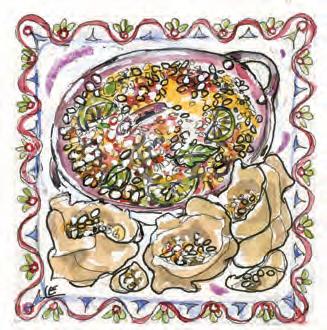
Her earlier, much-praised cookbook, Summers Under the Tamarind Tree, defined a culinary tradition already well known from the ‘Indian’ curry houses in every British high street.
So what’s the difference? Meat-eating, most obviously, since Pakistan is Muslim, and India, being predominantly Hindu, is vegetarian by orientation, even if not in practice. In other words, it’s complicated.
Sumayya’s early life was peripatetic, spent mostly on the high seas on a merchant ship captained by her father.
Her mother prepared delicious dishes for the family on a one-ring stove, with
very limited ingredients, which taught her daughter to cook with her senses rather than follow a recipe. Hence the book’s title: Andaza. In essence, it means ‘understanding achieved through the language of the senses’.
A law degree from Glasgow University, followed by a marriage that didn’t last, led Sumayya to return to her roots on the outskirts of Karachi. There, migrants from Hyderabad, whose cuisine is said to be the richest and most sophisticated in all India, settled after Partition.
Among her most poignant memories are of her beloved grandmother cooking a non-denominational vegetarian pulao.
It was ladled into brown-paper bags for distribution to the poor at the gates of the Sufi shrine where the family gathered to pay their respects to their ancestors.
Grandmother Nani’s preserved lemon pulao
A one-pot dish suitable for Bonfire Night, Halloween or any other gathering where spirits wander among the living. Make double quantities, wrap the pot in a blanket to keep it warm and share it with the hungry, whoever they may be.
Serves 4-5
350g basmati rice
1 preserved lemon
4 tbsp sunflower oil
½ tsp black peppercorns
1 cinnamon stick
5 or 6 cloves
1 tbsp brown mustard seeds
½ tbsp coriander seeds
1 tsp cumin seeds
5 or 6 fresh curry leaves
2 or 3 dried red chillis
1 large red onion, thinly sliced
1 tbsp grated ginger
4 or 5 garlic cloves, thinly sliced
2 tbsp full-fat Greek-style yoghurt
Salt
To finish
Mint leaves and toasted cashew nuts
Rinse the rice, then soak in fresh water in a bowl for 30 minutes and
drain. Slice the lemon finely, de-pip and reserve. Meanwhile, heat the oil in a heavy saucepan and fry the dry spices over a medium heat for 10 to 15 seconds till fragrant but not burnt. Add the curry leaves and chilli – stand back as they pop! – then stir in the sliced onion and keep stirring till the onion browns. Add the ginger and garlic and cook till it no longer smells raw. Add the yoghurt and salt and continue to stir till the yoghurt thickens – 3 to 5 minutes.
Stir in the (drained) rice and mix everything together. Place the lemon slices on top and add 150 to 200ml water, depending on the pan. Bubble up, turn down the heat, cover and leave to cook gently for 7 minutes. Check to see the water has all been absorbed and the grains are tender. If not, give it another few minutes. Finish with shredded mint leaves and a handful of cashew nuts.
RESTAURANTS JAMES PEMBROKE THE GUEST FROM HELL
I had the best of news this month.
I discovered that Alle Due Corti, set at the junction of two narrow streets in Lecce, Puglia, reopened its doors in May.
Their three-year lockdown was finally over. The founder, Rosalba, was back at her table by the door. Her husband, Danilo, took the payments. Her daughter, Marinella, greeted us on both our visits within five days. And her son, Giorgio, served God’s own dishes. Even her grandson popped in, complete with crash helmet.
The menu is largely in the Leccese dialect: taiedda (instead of riso con patate e cozze), and fave nette cu le cicureddhe (instead of fave con cicoria). Rosalba’s signature dish is ciceri e tria, a delicious mixture of fried and boiled tagliatelle with chickpeas. And a litre of their delicious vino della casa is just €9.50. Our first dinner cost just €30 a head, a price not seen in trendy Puglia for a decade.
All was joy until, halfway through our main course, a large, bearded man joined a party of relatively discreet Australian women at a long table in the centre of the restaurant. His voice echoed around the low ceilings. I now know who or what you get if you mate Brian Blessed with Crocodile Dundee, before inviting Falstaff to be godfather.
The Pugliese are far too gentle and polite to make a fuss. So, what was I to do? Approach his table with the humblest of suggestions that he might turn it
ELISABETH LUARD
72 The Oldie November 2023
down? Only to find he was Australia’s wrestling hopeful in the 2024 Olympics?
Rosalba’s punters were fleeing their tables, as he embarked on his Great Anecdote about his first encounter with cime di rapa, often described as turnip tops, and always served with orecchiette pasta. He was killing all our evenings. I couldn’t just stand idly by – but, like all us Billy Liars, standing idly by is exactly what I did.
I asked three old friends what they would have done, over dinner at the helpfully named 64 Goodge Street. This is a new much-praised addition to the Woodhead Group, which brought us Portland and Clipstone. All three are handily sited near The Oldie’s office in Fitzrovia.
It has been described in the press as a bistro. Well, I am a sucker for that word – first heard in post-Waterloo Paris when Russian officers shouted ‘bystro’ (meaning ‘quick’) to the waiters. I am returned at once to the seventies, spent by me in Bistro Vino and Bistro Bistingo. All I could picture was little tables in a crammed, thin dining room, lit by candles dripping onto old bottles of Côtes du Rhône. The food would be the sort of classics found at Bouchon Racine or Poule au Pot.
Well, not quite. I’d love to tell you that it’s worth paying £135 a head for three courses and a bottle of Corbières, but I just can’t go the distance.
It was delicious and fun – but what would my Australian nemesis from Lecce have said? Would he have channelled Sir Les Patterson and told them where to put their soupe au pistou (£14) and squab pigeon, Lyonnaise sausage and beetroot (£36)?
I think he would. He would have raised the roof. The old model of guesstimating the cost of dinner by multiplying the price of the main course by three is obsolete.
We must now multiply by four.
DRINK BILL KNOTT CANAL DESIRE
Travellers to the waterways of south-west France might recognise the scene.
I was gliding serenely on a narrowboat, sunshine blazing on the canal, as I toyed with a few oysters, a tranche of terrine and some crusty bread, a glass of something chilly and pink at hand to toast envious strangers on the towpath.
And then London Zoo hove into view: to be precise, the Snowdon Aviary (now repurposed for the use of monkeys, apparently; I spotted neither avian nor simian).
I was not on the Canal du Midi, but on the Regent’s Canal, having lunch aboard the good ship Prince Regent The nice folk who do the marketing for the Languedoc AOP, the appellation once known as Côteaux de Languedoc that covers a vast swathe of vineyards and wineries from the Spanish border as far as Nîmes, had decided to recreate –for one lunchtime only – the Canal du Midi between Paddington Basin and Camden Lock.
It was early autumn, and the sun didn’t exactly blaze on the canal – it was more of a watery dapple – but the rest is true. And the Regent’s Canal has certain advantages over the Canal du Midi, which boasts 91 locks. We shied away from the lock at Camden, opened another few bottles and headed back to Paddington, unperturbed by shifting water levels.
The chilly pink of choice was Domaine Costeplane Rosé ‘Arboussède’ 2022 (£19, forestwines.com), and the food was from the London Shell Co, who offer a cruise and set menu from £75 a head.
We feasted on scallops with salsify, croquettes de brandade, lamb with anchovy and courgette – for which the brambly, firm-tannined Clos des Nines ‘L’Orée’ 2020 (£23 davywine.co.uk) was a fine match – and a tarte au citron that was absolutely comme il faut. I have never had much luck with restaurants that float, but the London Shell Co is a notable exception.
While the Languedoc produces many delightful, good-value whites and rosés that chime happily with summery, slowpaced canal jaunts, it is also huge and versatile enough to embrace wines for more autumnal conditions.
If I see Château Capitoul (around £9) at my local Co-op, for instance, I clear the shelf. I suggest you do the same (although please spare the Shepherd’s Bush branch). A blend of Syrah, Grenache and Carignan, from vineyards between Narbonne and the coast, it has a velvety smokiness and bags of ripe fruit.
As ever, the Wine Society (thewinesociety.com) offers a plethora of Languedoc reds at fair prices: their own-label Corbières (£8.95), for instance, which shows what Carignan can do when properly handled, or their Minervois La Livinière Cuvée Cantilène, Château Sainte Eulalie 2019 (£16), a great mouthful of a wine as well as a name.
This month’s case from DBM contains a couple of fine reds, too, as well as a crisp white, just in case the summer turns out to be Indian after all.
This month’s Oldie wine offer, in conjunction with DBM Wines, is a 12-bottle case comprising four bottles each of three wines from the Languedoc: a benevolently priced white from the Étang de Thau; a similarly good value Malbec that is drinking very nicely now; and a terrific Faugères that would go very well with roast beef. Or you can buy cases of each individual wine.
Piquepoule-Terret
‘Pique & Mixe’, Vignerons de Florensac, Côtes de Thau 2022, o er price £9.70, case price £116.40




Crisp, citrus-edged white made from Piquepoule (aka Picpoul, from nearby Pinet) and the once widely planted Terret. Great value.
Malbec ‘Chants du Closeau’ 2021, Pays d’Oc, o er price £8.49, case price £101.88

Leafy blackcurrant fruit and soft tannins: savoury, with a nice length, and at its peak now.
Faugères Rouge, Mas Olivier 2021, o er price £14.00, case price £168.00 Spicy, juicy red from the foothills of the Massif Central: complex, with a hint of acidity that makes it a great food wine.

Mixed case price £128.76 – a saving of £38.11 (including free delivery)
HOW
www.dbmwines. co.uk/promo_OLD
NB O er closes 18th December 2023
TO ORDER Call 0117 370 9930
Mon-Fri, 9am-6pm; or email info@dbmwines.co.uk Quote OLDIE to get your special price. Free delivery to UK mainland. For details visit
The Oldie November 2023 73
Wine
SPORT JIM WHITE
THE JOY OF STATS
One of the real joys of being a fan of sport is losing yourself in its minutiae.
Wallowing in past achievement, treasuring history, diving into previously unvisited corners: nothing delivers quite the room for nerdery that sport does. This is what draws so many of us to games: losing ourselves in their nooks and crannies.
But, like much of modern life, the very essence of sporting nerdery is changing. And not for the better. Data is taking over the reporting of sport. Like many a new trend, this one hails from America. In every pursuit now, interpretation of the action comes smothered by statistics –not old-school stats, like batting averages or numbers of sets won.
This is a peculiar new insistence – data used to analyse what should have happened, not what actually did. Delivered in exclusive jargon (in football, we now have the ‘5-3-2 block’, ‘second-phase pressure’, ‘vertical passes’), it operates to obfuscate rather than illuminate.
Take Expected Goals, the most fashionable bit of data these days, much favoured by media outlets such as The Athletic. This is a football metric designed to measure the probability of a shot resulting in a goal. This ignores the obvious fact that the only metric that counts is whether it does or not.
The good news is that if you want to know what genuine sporting nerdery looks like, help is at hand. James Harkin and Anna Ptaszynski, two of the brilliant cohort of researching elves at QI, have come up with a sporting tome called Everything to Play For. This is a work of high-end diligence, exploring the detail of sporting history to tell you things of which you were unaware. Moreover, things that actually help your understanding of sport today.
There are many extraordinary sporting details in the book that I didn’t know. Such as the fact that David Attenborough was involved in the development of yellow tennis balls.
Or that, despite the legend, Eddie ‘the Eagle’ Edwards didn’t finish last in the Calgary Games ski jump because another competitor was disqualified.
Then there is the tale of the first –back in Victorian times – cricket tour of England by an Australian XI, made by a team made up entirely of Aboriginal players. The book delivers an unhappy coda. The visitors were coached by a man who later became actively involved in an attack on the Gayiri people in Queensland,
in which at least 400 indigenous Australians were slaughtered.
But it is not all grim. Far from it. Rather, it is magnificently eclectic. I did not know that the manner in which sound is recorded at live events for broadcast has a significant effect on the way we respond to televised sport. Hush was a vital component of upping the tension during the Centre Court battle between Rafa Nadal and Roger Federer in 2008. And it was achieved by the sound engineer’s fading down the crowd noise at critical junctures. As he dialled down the noise, he dialled up the tension.
And what most distinguishes this book from the modern profusion of po-faced, self-important data is its sense of humour. Unlike the XG experts, these obsessives do not take themselves seriously. For the writers, ultimately sport is a laugh. And their book is packed with lovely touches – for example, in the tale of how Billy Jean King’s lover outed her at the height of the player’s prowess. As the story unfolds, there is an asterisk next to Marilyn Barnett’s surname. In the footnotes, it reads, ‘Barnett, living up to her name, was a hair stylist.’
That is what you call proper nerdery.
MOTORING ALAN JUDD 1948, A GOLDEN YEAR FOR CARS
This year, we celebrate five 75th birthdays of significance to the British motor industry (as was).
In 1948, wartime rationing was increased by the Labour government. Steel was strictly rationed and carmakers were compelled to export. Factories that had been turned over to military production were worn out, and the few new cars available were mostly upgraded versions of pre-war models.
But some minds conceived change rather than continuation. One was that of a 20-year-old engineering student, Colin Chapman, whose girlfriend’s dad let him do up an old Austin 7 in an empty garage. This car, re-bodied, later became the Mark 1 Lotus.
Improved versions followed, and within two years of founding the Lotus company, Chapman’s cars were competing at Le Mans. Despite periods when Lotus was said to stand for Lots Of Trouble Usually Serious, the company thrives and – now owned by Chinese giant Geely – still adheres to Chapman’s founding engineering principle: to go faster, ‘add lightness’.
Three newcomers stood out at London’s
1948 Motor Show. Most sensational was Jaguar’s XK120 sports car, a curvaceous beauty which could also perform –stripped out, it hit 120mph at a time when many cars were flagging at half that.
It was the result of wartime Jaguar staff’s having to spend a night a week on fire-watch duty at the factory. William Lyons, Jaguar’s owner, put these sessions to use by conducting design seminars, resulting in Jaguar’s famous XK engine, produced until 1992.
Lyons himself had an unfailing eye and under his stewardship every Jaguar from the XK on had something of beauty. To my eye, the XK120 and its XK140 and XK150 siblings were the most appealing sports cars ever, more so even than the E-Type that followed.
Almost as sensational was a small family car which became part of the postwar British landscape – the humble Morris Minor. Developed under the design supervision of Alec Issigonis (who went on to design the Mini), it was an understated revolution in saloon design, let down only by its pre-war engine.
Issigonis wanted a modern engine, but that was a step too far for Morris’s management. However, in 1952 it inherited Austin’s A-series engine and from then the Morris Minor wormed its way into our national self-perception. Since ceasing production in 1971, it has spawned a replacement industry producing modernised versions, with better parts supply than many contemporaries.
Also at the show was a manufacturer called David Brown. The year before, he had bought a carmaker with no models, called Aston Martin. He insisted it produce something for the show, a sleek sports tourer that was to become known as DB1.
Only 15 were made, but the DB Astons that followed are the reason the company survives. But always at a price. When a friend asked Brown to sell him one at cost rather than showroom price, Brown sent him to the showroom, saying, ‘You couldn’t possibly afford it at cost.’
And, finally, Land Rover, a sell-out at the 1948 Amsterdam show. Brainchild of Rover design chief Maurice Wilks and intended as a stop-gap, it is said to have been sketched in the sand by Wilks on an Anglesey beach. Within a year, it was Rover’s bestseller, and its direct successors continued until 2016.
Now the new Defender has forsaken the original’s utilitarian roots – to my mind, a strategic error.
But it sells well – and the progenitors of all five of these ground-breakers were forward-looking, unlike me. Maybe their successors, too, are right.
74 The Oldie November 2023

Matthew Webster: Digital Life
Let us pray for the death of the password
The 1980s produced personal computers. The 1990s spawned the internet. The 2000s improved connectivity between our devices. The 2010s brought the rise of big data (the analysis of impossibly large amounts of information). And the 2020s have witnessed the refinement of all this into artificial intelligence.
The sixth stage is beyond my imagination, but all my instincts tell me that it’s not far away. So, given this astonishing progress, why are we still having to mess around with passwords?
Login headaches have been the bane of our digital lives for as long as we’ve been using the internet, and the situation has barely improved in the past 30 years.
One of my tests for any business is: how hard do they make it for me to give
Webwatch
For my latest tips and free newsletter, go to www.askwebster.co.uk
haveibeenpwned.com
Check whether your email address has appeared in a data breach.
https://tinyurl.com/webster432
The Parliamentary Archives’ story of Guy Fawkes – with many contemporaneous documents. Britannica.com/event/ Gunpowder-Plot is good, too.
I will happily try to solve your basic computer and internet problems. Go to www.askwebster.co.uk or email me at webster@theoldie.co.uk
them my money? We wouldn’t – or shouldn’t – put up with a long queue or an incompetent assistant at a real shop. But, somehow, we are forced to suspend this irritation if we are fighting to access a website that may even eventually lock us out. What impertinence.
The trouble is that I probably want the impossible. I want it to be very easy for me to use my online banking, but I don’t want it to be too easy for anyone else. In fact, I don’t even want it to be difficult for them. I want it to be impossible. The same goes for theatres, airlines, local councils and all the other organisations that would much rather we engaged with them online than in person.
I certainly want my bank to keep my money safe, yet I become irritated when it asks me to confirm, yet again, who I am, even though I have done this only a moment ago.
Passwords go back a long way. Ali Baba’s ‘Open Sesame’ must have been one of the earliest. The modern computer passwords started to be used in about 1961, when Professor Fernando Corbató of Massachusetts Institute of Technology devised them.
The professor thought that passwords were a good idea at the time. But, in retirement, he suggested the system was underdeveloped and had become unwieldy. He was right – and that was well over 40 years ago, yet we are still stuck with them.
It’s not as if they even work well. Even when scoundrels haven’t managed to steal a list of passwords (even the Electoral Commission was hacked recently), breaking into websites has
become mechanised. Robots will try millions of variations in seconds, in the hope of coming up with the right one by brute force – and they often do.
And don’t think that those irritating tests where you must decide which of the nine pictures have a bicycle in them will save you. Recent research has shown computers can do them too, faster and more accurately than humans.
There have been some modest developments. My laptop has a fingerprint-recognition gadget that I hope works only for me. But the problem is that if my finger is even a little sweaty or too dry, it fails.
So what advice can I offer? First, if you must write them down, it is safer to use a notebook than a document on your computer. Second, please use a password-manager. All the main browsers have their own version. They are all free and secure, and won’t store them in your computer.
Finally, please don’t use 12345678 or ‘password’. That is like leaving the safe door open.
Margaret
National Savings and Investments (NS&I) tops the best-buy savings tables.
That is not a headline you see very often – and it might not still be true by the time you read this, because the highstreet banks are fighting back. But at last there is good news for savers.
NS&I was, until 1969, the Post Office Savings Bank. It split with the Post Office and became a government
‘If we could only train them to stop abusing our fountain! I think it's gross’

Dibben: Money Matters Saving ’s graces
department called the National Savings Bank, renamed National Savings and Investments in 2002. Its sole purpose is to attract money for the Government to spend.
Usually, the rates from National Savings are middling, as the Government does not like to use its weight to disrupt the wider savings market. That changed this year. The Chancellor of the
Exchequer and the Financial Conduct Authority had already criticised – even threatened – the high-street banks for being quick to raise mortgage rates but slow to improve savers’ returns as base rates shot up. NS&I’s attack gave the banks the push they needed.
That wasn’t NS&I’s only motive. Each year, the Government tells National Savings how much it must take in from
76 The Oldie November 2023
savers over the following 12 months. The current target is £7.5bn, which is 25 per cent more than last year. This has come at a time when the cost-of-living crisis is forcing savers to take money out, rather than put more in. So NS&I needed to make an eye-catching move.
In the early autumn, it topped the poll with its one-year guaranteed growth bond paying 6.2 per cent, the highest level since it was launched in 2008. The banks quickly improved their returns – though not to NS&I’s level – for comparable accounts.
NS&I has the further advantage that every penny you deposit is safe. You could put a million in NS&I accounts and sleep easy. High-street banks
can guarantee only a maximum of £85,000 through the Financial Services Compensation Scheme.
NS&I also improved the returns on its other variable-rate accounts, including the guaranteed income bond and the green savings bond. The return on premium bonds is now the highest this century.
In a separate significant move, it has changed the terms of its oldest accounts – the index-linked and the fixed-interest savings certificates. These have not been on sale since 2011, but existing certificate holders can renew. Customers used to be able to take money out early by losing 90 days’ interest; now no withdrawals are allowed until the end of the term.
A word of warning: earning better interest on your savings makes it more likely that you will have to pay income tax. Low earners can earn up to £5,000 interest before paying tax. Basic-rate taxpayers have a £1,000 personal savings allowance, which is £500 for higherrate taxpayers and zero for those on the 45-per-cent additional tax rate.
Interest rates might go higher, but there is no reason to delay switching your savings. Just read the terms carefully, because the best-paying bank accounts have catches, such as being on sale for only a short period or dropping to a lower rate after, say, one year. Rates are still not high enough to beat inflation, but savers are at least being better paid.
Peloponnese:
Menelaus

Monday 20th May – Monemvasia
Museums in Greece are closed on Mondays, so this is an excellent opportunity to visit this beautiful town on a rock, accessible only by a causeway. Lunch at Matoula, which has stunning views.
Tuesday 21st May – Tiryns and Argos
Greece in the spring is at its best. The Oldie’s editor, Harry Mount, author of Odyssey: Ancient Greece in the Footsteps of Odysseus, has devised his dream tour of the Peloponnese. For the first four nights, we will be staying in Nafplio, at the Amymone Guesthouse (www.amymone. gr). From here, we will strike out to Agamemnon’s hilltop kingdom of Mycenae. Then to Epidaurus, home to the greatest theatre in ancient Greece. We will then swing down to Monemvasia, the beautiful Byzantine town set on a rock. We will then use the Mystras Grand Palace (www. mystraspalace.com) as our base to explore both deserted Mystra and Sparta, seat of Menelaus. And, for our finale, en route to Kalamata Airport, we will stop for lunch in Kardamyli, home to Patrick Leigh Fermor. For lunch and dinner, we will be exploring hand-picked tavernas. In depth.
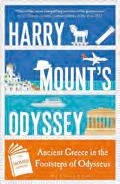

Friday 17th May – Nafplio
Depart Heathrow at 12.15 with Aegean Airlines, landing in Athens at 5.50pm. Transfer to Nafplio.
Saturday 18th May – Corinth
A tour of the ancient site where Bellerophon captured Pegasus. Lunch followed by a tour of the canal, which was opened in 1893.
Sunday 19th May – Epidaurus and Mycenae
After a tour of Archaia Epidaurus with its fabulous theatre, we’ll have lunch at the beachside Athina Tavern. From there we can swim to the sunken parts of the ancient city, 20 feet from the shoreline. Then to the citadel of Agamemnon, with its white marble temples and theatres. Homer called it ‘rich in gold’, as Schliemann discovered when he found the famous gold face mask in 1876.
Morning tour of nearby Tiryns, which dates from the 13th or 14th century BC. Homer noted its amazing walls, which we can walk around as we visit the fortified Mycenaean palace. After lunch at Aigli, in Argos, Sparta’s great rival, we will visit the ruins and Larissa Castle. Transfer to the Mystras Grand Palace, near Mystra.
Wednesday 22nd May – Sparta and Mystra
Morning tour of Menelaus’s city and its acropolis; lunch followed by an afternoon tour of the old city of Mystra, largely deserted, renowned for its extraordinary Byzantine churches and views of the plain. Early supper at Chromata.
Thursday 23rd May – Kardamyli
Shopping in Kardamyli followed by lunch at I Dioskouroi, overlooking the island around which Patrick Leigh Fermor swam every day. Depart for Kalamata Airport to catch the 1755 BA0645 flight, arriving at Heathrow at 1935.
HOW TO BOOK: Call 01225 427311 or please email Katherine at reservations@theoldie.co.uk. Price per person: £2,250, which includes all meals, wine with meals, transport and entrances. You need to book and pay for your own flights. Single supplement: £300. A non-refundable deposit of £750 will be required, with the full balance due on 1st February 2024.
The Oldie November 2023 77
The
in the footsteps of Agamemnon and
with Harry Mount 17th to 23rd May 2024
LANDSCAPE:
/
Left: the village of Epidaurus. Right: funerary mask of Agamemnon
CONSTANTINOS ILIOPOULOS
ALAMY; MASK: PRISMA ARCHIVO / ALAMY
The Shoveler
by john mcewen illustrated by carry akroyd
Only 1,000 pairs of the shoveler breed in the British Isles.

That is a quarter of the number of mandarin-duck pairs. The winter ‘influx’ of 19,000 birds (a fifth of the north-western European population) is dwarfed by wintering teal (430,000), wigeon (445,000) and mallard (665,000).
Globally, shovelers are widespread and numerous (5.9 million). But to see some – usually in passage, on an urban lake – is always an event. This is because of the thrillingly conspicuous drake, its long scapular feathers worthy of adorning the helmet of an imperial governor.
Its colours are the same as those of the shelduck. One of its colloquial names is ‘sheldrake’, ‘shel’ meaning ‘variegated plumage’, from Middle Dutch schillede. No less noticeable is the spatulate bill. Thus its name Spatula clypeata –‘spoon-shaped’/ ‘shield-bearing’. It’s also called Anas [duck] clypeata
At four inches, the bill is a fifth of a shoveler’s length, and spoon-shaped, like that of the spoonbill. In Norfolk, the shoveler was also called a ‘spoon bill’ – misleading because spoonbills are a heron species.
In his career as a conservationist, Sir Peter Scott (1909-89) let his artistic talent serve the unemotional demands of science. It contrasted with his pre-war artistic heyday, when his paintings were filled with the lonesome and twilit romance of wildfowling. Shovelers Rising Above Reeds (1934) was an early success.
The shoveler drake’s plumage also provides one of the most decorative of the measured drawings of dead-bird specimens in Tunnicliffe’s Birds by Charles Tunnicliffe (1901-79).
The shoveler’s bill is principally a filter as, head extended, the bird weaves its way, dabbling from side to side, along the surface of shallow water, often in
large flocks comically circling in this way to stir up food. But it will also shovel for food – and is notably carnivorous for a dabbling duck.
The flesh is considered to have a muddy taste, so in Britain the shoveler has been largely disdained as a sporting bird. This is not the case in the United States. The US Fish and Wildlife Service allocates how many of each licensed bird species a hunter can shoot in a season. In 2019-21, nearly half a million shovelers were shot.
The bird’s courtship ritual involves a similar procedure to its filter-feeding. It is described by John Guille Millais (1865-1931), artist, author, wildfowler, naturalist, seventh and youngest child of the Pre-Raphaelite Sir John Millais Bt
(1829-96): ‘He [the drake] swims slowly up to her, uttering a low guttural croak … konk konk … elevating his head and neck and jerking his bill upwards. The female then bows in recognition and both proceed to swim slowly round in circles, one behind the other, with the water running through their bills.’
The time I have seen most shovelers was on a spring voyage down the Nile, where, at regular intervals, rafts of them were distantly viewable. It seems they are not depicted in the ancient tombs and have no place among the Egyptian gods.
The 2024 Oldie Bird of the Month calendar is now available from carryakroyd.co.uk
78 The Oldie November 2023
CARRY
AKROYD


The ghost of Lucrezia Borgia
Charlotte Eagar ventures into Rome’s secret corners, haunted by the most lethal family in papal history
Iwent to Rome to look for Lucrezia Borgia and met her ghost at the Vatican in the Sala dei Sibilli.
Lucrezia’s blue eyes, framed by blonde ringlets, gaze down, in the guise of multiple Sybils, from every wall of this room in the Vatican’s Borgia Tower.
I was looking for Lucrezia (1480-1519) because I’m writing a book.
A Renaissance beauty with golden hair, a brilliant mind and a truly appalling family, Lucrezia was the daughter of Pope Alexander VI, Rodrigo Borgia, one of the most reviled Popes in history, synonymous with poison, corruption and even a hint of incest.
Lucrezia has been tarred, almost certainly wrongly, with the same brush.
I’ve been commissioned to write a novella about Lucrezia for the Garden of Ninfa Foundation because, in early 1500, Lucrezia briefly owned Ninfa, a ruined medieval town south of Rome, now a legendarily beautiful garden.
I’ve spent much of the last six months trapped with Lucrezia in the Sala dei
Sibilli in my book. She spent August 1500 as good as besieged in the room with her husband, Alfonso, after he’d been severely wounded by Cesare’s assassins.

We’d rented an Airbnb flat ten minutes’ walk from the Vatican; a building that would have been old when Lucrezia was alive, near the Piazza Navona, one of Rome’s most fabulous squares, where the architect Gian Lorenzo Bernini’s Four Rivers Fountain writhes before the Baroque bulges of Borromini’s church of Sant’Agnese in Agone. The flat was on Via Governo Vecchio, a narrow, cobbled street snaking through Rome’s Centro Storico, which grew organically from the imperial city’s ruins.
Lucrezia herself probably walked our street. It’s on the way to the Vatican from her childhood home, three minutes away, in the Piazza Sforza Cesarini, next to Da Luigi, which serves a splendid lobster linguine.
Da Luigi’s owner, sweeping his terrace in the February sun, pointed to a Gothicwindowed palazzo, four doors down:
‘Lucrezia lived just there, when she was a little girl.’
The Borgias have inspired more literature than any Pope since St Peter. They were the model for the Corleone crime dynasty in Mario Puzo’s The Godfather Machiavelli based The Prince on Lucrezia’s brother, Cesare. As for Lucrezia, authors from Jean Plaidy to Victor Hugo have tried to understand her. Donizetti wrote an opera about her.
And they inspired Harry Lime’s brilliant speech in The Third Man, improvised by Orson Welles:
‘In Italy, for 30 years under the Borgias, they had warfare, terror, murder and bloodshed, but they produced Michelangelo, Leonardo da Vinci and the Renaissance. In Switzerland, they had brotherly love, they had 500 years of democracy and peace, and what did that produce? The cuckoo clock.’

Not entirely true. The Swiss don’t make cuckoo clocks.
There were two Borgia popes: Callixtus III (1455–1458) and Alexander VI (1492–1503). Yet it’s surprisingly hard to find the Borgias in Rome because Baroque Rome has overlaid the Renaissance. And the Borgias’ papal successors so loathed these Spanish interlopers that they eradicated as many traces of them as they could.
I wandered towards St Peter’s Basilica past the gesticulating angels of the Ponte
80 The Oldie November 2023
Travel
Lucrezia as St Catherine of Alexandria, by Pinturicchio
Sant’Angelo, added by Bernini; past the grim bulk of the Castel Sant’Angelo, once the tomb of the Emperor Hadrian, repurposed as the Popes’ answer to the Tower of London, topped by Bernini’s avenging St Michael.
Little here would be recognisable to Lucrezia: Michelangelo’s floating dome and St Peter’s magnificent façade were built after her death – although the dismal cells of Castel Sant’Angelo would have been only too familiar to the Borgias’ enemies.

Armed with an early-17th-century print, I found Lucrezia’s home, where she lived with Alfonso: Palazzo Santa Maria in Portico, squeezed between St Peter’s and the Papal Palace. Thanks to Baroque remodelling and Bernini’s all-embracing colonnade, just the upper storey and the top corner tower can be seen.
The splendid Borgia mausoleum Lucrezia’s father plonked in the centre of St Peter’s Square was demolished in 1586, replaced by the obelisk that stands today. Pope Alexander’s bones spent 400 years in a cupboard in the Spanish church, Santa Maria in Monserrato, until found by chance in the 19th century
Lucrezia’s mother, Vanozza, a highclass courtesan with a chain of successful
pubs, paid for an elaborate side chapel in S Maria del Popolo, for her and her son Juan, Duke of Gandia (a spoilt drunk, almost certainly murdered by Cesare in a fit of fraternal envy).
After a largely horizontal career, Vanozza was obsessed by her fate in the afterlife. Despite her dying highly respected, in her seventies, and being buried with great pomp, Vanozza and Juan’s tombs were also broken up, the side chapel repurposed for a less controversial family. No one knows what happened to their bones; Vanozza’s plaque was found about 70 years ago, and moved to a church just opposite the Campodoglio.
But in the Sala dei Sibilli, I met the Borgias themselves. Most tourists don’t bother with the Torre Borgia, built by Alexander shortly after he became Pope.
By the time they’ve trodden the Vatican tourist one-way treadmill to the sign ’Sistine Chapel, Café and Exit left; Borgia Apartments right’, exhausted by two hours of visual splendour, they head straight to Michelangelo’s megastars and a large gelato

Today, the Borgia apartments house a collection of religious modern art, including Gauguin, Chagall, Francis Bacon’s 1954 take on Velasquez’s Pope
Baroque Rome hides the Borgias’ haunts: Bernini’s Four Rivers Fountain (1651) and Borromini’s Sant’Agnese in Agone (1653), Piazza Navona

Innocent X (which looks like his ghost being taken screaming to hell) and a Van Gogh Pietà
But I was far more interested in the frescoed walls: Pinturicchio painted the whole family through this suite of six rooms, in which the Pope (and often his children) lived during his reign.
In the Sala dei Santi, Lucrezia (pictured, opposite)debates with the Emperor Maxentius as St Catherine of Alexandria, flanked by her brothers Cesare, Juan and little Joffre, married to Alfonso’s sister, Sancia.
In the Sala dei Misteri, the Borgias’ family sitting room, Pope Alexander prays in front of the risen Christ’s empty tomb. Behind him is the earliest depiction of Native Americans in Western Art, painted shortly after Columbus’s return. The picture of Alexander’s mistress, la bella Giulia Farnese, as the Madonna, dandling Christ on her knee, was hacked off in the 17th century by Pope Alexander VII, who kept some of the fragments.
Alexander’s successors, in their antiBorgia paranoia, had the rooms closed off – they were not reopened until the late-19th century, and have never been lived in again.
It was here that the Vatican guard, intrigued by my nerdy photography and measuring, whispered sheepishly, ‘You know this room is haunted!’ By Lucrezia? ‘No, by her brother, Cesare.’ He hadn’t seen him, he said, but ‘the nightwatchmen see and hear things’. No wonder Cesare’s nemesis and Alexander’s successor, Pope Julius II, shut these rooms up. Cesare Borgia would be a very unrestful ghost.
Charlotte Eagar is writing a novella about Lucrezia Borgia, The Queening
The Oldie November 2023 81
KIRK
/
FISHER
ALAMY
THE THIRD MAN ©WARNERS/ LANDMARK MEDIA / ALAMY
INGE JOHNSSON / ALAMY STOCK PHOTO
‘Warfare, terror, murder and ... the Renaissance’: Orson Welles on the Borgias in The Third Man (1949). Right: St Peter’s
Overlooked Britain
An American corner of Buckinghamshire
 lucinda lambton
lucinda lambton
William Penn, the Quaker founder of Pennsylvania and Philadelphia, is buried at Jordans Friends Meeting House

What a joyful surprise it is to realise that William Penn (1644-1718), one of the first Quakers and a great and glorious hero to boot, is buried but a mile or two from where I live in Buckinghamshire.
Never, ever will I forget searching for proof of his burial place in Philadelphia, where he had planned ‘a greene Countrie Towne which will never be burnt and always be wholesome’. There, so great was his importance, it had been decreed that he should be honoured on high; higher than any building in sight, with nothing allowed, whatever it was, built higher than his hat.
And what about the five-acre grandeur of the City Hall on Penn Square with its wild wealth of decoration – all designed by Scots-born Alexander Milne Calder? Despite its gargantuan
proportions, this too proudly displays the great man on its highest point. With its caryatids, bas-reliefs, mansard roofs and statues galore, it soars skywards, with Penn holding forth atop its multiplicity of decorative delights.
To return to England, most particularly to Jordans, where the enchanting-to-this-day little brick Meeting House has survived since 1688. There, among the many gravestones, beneath a wealth of apple trees and
NORTH WIND PICTURE ARCHIVES / ALAMY CHRIS LOFTY / ALAMY
82 The Oldie November 2023
Above: Jordans Friends Meeting House, Bucks, first built in 1688. Below: Penn’s Treaty with the Indians by Benjamin West, 1772
beside the pretty-as-a-picture little building, is a small group of Penn family graves. Here is William Penn’s modest representation, alongside ten of his children and his wife, Gulielma Springett. After such a magisterial progress though the great American city that he had founded, what sheer magic it was to find his grave in England, beneath the apple trees. Also there are his two wives, in such modest surroundings.
The gravestone of the founder of Pennsylvania is in long, green, English grass, in the shadow of a meeting house in the English home counties. His had been not just another colony, but a ‘Holy Experiment founded on Quaker values of freedom and toleration and peaceful approaches to conflict’.
What he did in Pennsylvania was what he would have liked to have seen happen in his home country, but which had seemed impossible at the time. Aspects of Pennsylvania later influenced governance in many other US states and indeed in the US constitution itself.
What a tale and a half to spring forth from a gentle wood in Buckinghamshire. As for the 385 burials between 1671 and 1845 that were embraced by these turfs, the details of their names’ survivals make the most heart-stirring reading.
Here lies John Giggler, a mealman from Eton. Springett Penn was the ‘pious son of William and Gulielma Penn, who died in Lewis’. Joseph Rule who died in 1770 sounds a good man, celebrated as ‘the White Quaker’. John Wesley says that he was ‘a calm, loving sensible man and much devoted to God’.

Another character worth knowing was John Smith, who died in 1684. He was a labourer from Farnham Common who was imprisoned in Aylesbury jail for ‘simply attending a Friends meeting near Woburn and sealed his testimony with his blood in prison’.
William Penn had been first imprisoned for his Quaker beliefs in 1668, when he was 24. He had published a religious work without getting the obligatory approval from the Bishop of London. He was charged with blasphemy and dispatched to the Tower of London for seven months.
While there, he wrote No Cross, No Crown, one of his best-known works which explains the sacrifices he and others had made when they became Friends.
In 1670, he was in court again, along with another Friend, William Mead. They were on trial for preaching outside a Quaker Meeting House in Gracechurch Street in the City of London.
This contravened the Conventicle
Act, which forbade religious gatherings of more than five people, apart from services in the Church of England. Penn defended himself so ably that the jury refused to find him guilty. This was a landmark case in English law, which established the independence of the jury.
Three cheers for William Penn! His religious and political ideas continued to develop as he struggled forth with religious toleration and freedom of conscience, until he decided to emigrate to the New World. There he felt that he would find the answers and the freedoms that he sought.

The true founder of Quakerism was in fact George Fox, a charismatic and revered friend of William Penn. He had long hair hanging in ringlets and ‘always had to wear a hat of the largest size’. His features were most glowingly shown off in his journal at Jordans.
At Jordans, this most magical building still has a quantity of the original furniture, including deal benches and three most moving coathanging pegs of ancient lineage.
Stirring to say, it is still used, with regular meetings throughout the week, as befits such a remarkable survival.
SKYLINE: MINDAUGAS DULINSKAS / ALAMY; CEMETERY: DAVID ROSS / ALAMY
The Oldie November 2023 83
Left: Penn’s grave in the grounds of Jordans. Below: Penn’s 36ft-statue by Alexander Milne Calder atop City Hall, Philadelphia
After such a magisterial progress through the great American city he founded, what magic to find his grave in England, beneath the apple trees

Taking a Walk
If you go down in the woods tonight...
 patrick barkham
patrick barkham
Like Plop, the owl who was afraid of the dark in Jill Tomlinson’s book, we need to be reminded of the joys of spending time outdoors when night falls.
I cling to the comfort blanket of electric light as much as anyone. It took an invitation from Kim and Nick Hoare to join one of their full-moon walks to get me taking a stroll in that most foreign of lands: the night.
Samuel Taylor Coleridge and Dorothy and William Wordsworth pioneered walking for pleasure at night in the summer of 1797. But night strolling is the highly questionable behaviour of burglars, poachers and other deviants. The old Romantics were watched with consternation by government spies convinced it was a revolutionary plot.
So joining a friendly walking group is as much about not alarming others as about not being scared. Our decidedly unthreatening band of 12 set off from a lay-by beside Dunwich Heath in Suffolk at dusk. The moon had not yet risen and we were unlikely to see it anyway, given the low firmament of thick, grey cloud.
It was a cool evening and our path through the bracken weaved around scores of small puffballs, mostly in pairs like mystic eggs. When Kim and Nick began their walks a decade ago, they were strict: no dogs, no torches and not much talking – it was a meditation with the moon. They’ve become more laid-back and the group chattered as we walked. Torches remained off, enabling our night vision to sharpen as the colour leached from the land.
As we entered a black-and-white film, we also entered an older state of being human, less reliant on sight and more attuned to other senses. I felt the ground with my feet as I went, and registered smells and sounds more keenly. The sickly scent of honey fungus hung in the air; 30 jackdaws wheeled in the sky, a final act before the roost.
Abruptly, there was a high-pitched ‘wah’ and then a crashing stampede through the woods around us: 15 red deer on the run.
The trees gave way to heath and the pale, sandy path glowed in the gloaming. Ahead, a bright patch of orange above the cloudy horizon. A late sunset? The lights of Southwold? No, this was the rise of the blue supermoon (‘blue’ because it was the second moon of the month; super because it was unusually large in the sky). Sadly, it couldn’t burst through the clouds; the orange flash was as good as it got.
Suddenly, a churring echoed across the heath: a nightjar. Kim waved a white hankie and these strange birds flew closer, believing they were closing in on a tasty moth, swooping low over our heads like giant bats.
Pursued by the menacing whine of mosquitoes, we headed on to the shingle beach. The gravel scrunched, Southwold lighthouse threw its light over the waves and, on the seaward horizon, the lights atop distant wind turbines flashed in unison like cheap Christmas decorations.
The air was salty on the beach and when we turned into Minsmere, it became scented by damp reeds, where geese chuntered.
People like to talk on walks, but there
is something particularly confiding about a night walk. Strangers open up when they can’t really see each other, and so life stories unspooled.
The walk became more dreamlike. The track through the woods completely disappeared for the first and only time and we walked through blackness. Cobwebs trailed across our faces. People became simply voices.
Then the blackness lessened, tracing the limbs of fabulous old oaks above us. A ‘ker-wick’ sounded from immediately overhead, with an answering ‘woo’ from the field beyond.
The chatter of people gave way to the conversation of owls. I have never before heard so many owls in one place, a veritable family of Plops. Like him, we were no longer afraid of the dark.
We set off from the lay-by outside Minsmere national nature reserve, walking north across Dunwich Heath before returning via the beach and reserve (with RSPB Minsmere’s permission). You can join Kim and Nick Hoare’s moonlight walks via www.ivygrangefarm.co.uk

GARY WING The Oldie November 2023 85




On the Road
Guys, dolls and Stephen Sondheim
Julia McKenzie, 82, tells Louise Flind about coming out of retirement to salute her mentor

Do you travel light?
Generally, yes, but because I’m away from home for seven weeks this time, I’ve overpacked. But, as it’s all rehearsal for Stephen Sondheim’s Old Friends, [which McKenzie is co-directing] I hope nobody asks me out anywhere posh. I haven’t brought anything posh with me.
What’s your favourite destination?
I come to London for holidays now, as I live on the south coast.
What are your earliest childhood holiday memories?
Money wasn’t running around too much back then, so I think the biggest thing was the Isle of Wight. That was exotic for us.
Did you always want to be on the stage?
I did, but I didn’t know it really. I was extremely fortunate. I had a voice when I was a kid, so I used to get solos. There was a night that changed my life. I was singing the solo at a school concert and a county music adviser came round afterwards and said, ‘I will give you a scholarship for four years to study opera at Guildhall.’ I didn’t know anything about music – I couldn’t read it – and I was hoping to be a French teacher.
Did you come from a musical theatrical background?
Not at all. My dad was an office manager and my mother worked in various shops – but she had a voice, an absolutely glorious voice, and when she put the vacuum cleaner on, she would sing, and I would sit on the stairs and just listen.
What happened after the Guildhall?
Operetta, and then I worked my way into musical theatre. The big moment was hearing Stephen Sondheim. He’s made me a much better performer.
What was Stephen Sondheim like? He was a lovely chap. I loved him.
What was your first big break?
I was not a star overnight. I suppose the
first thing was a touring production of Rosemary in the mid-1960s and I was cast as the second understudy. I looked at the show a couple of times and, blow me, Rosemary was off, her first understudy was off and I was thrust on and I thought, ‘Whoopee, I’ve made it!’ I was just a working actor, really, until my friends Millicent Martin and David Kernan decided they’d put a little evening together called Side by Side by Sondheim. We were all in other shows, but we put on this review on Sunday evenings at various places.
Cameron Mackintosh came along and decided this had something, and put us for six weeks into the Mermaid Theatre. Then it transferred into Wyndham’s Theatre – but not with us. We’d gone to New York to open it.
Who’s been your favourite director?
I would be a fool if I didn’t say my current director, Matthew Bourne. He’s working in conjunction with Stephen Mear on the choreography. It’s a wonderful team to work with.
Do you prefer theatre to television and film?
Vastly – yes, it’s alive. Film and television are nice, but there’s a lot of sitting about.
What was it like being on Broadway in the 1970s?
Incredible. I was terribly nervous, though, because we were taking American material to New York.
What’s the most exotic place you’ve ever filmed in?
We did an episode of Marple in Cape Town, trying to pretend it was the West Indies.
And the least exotic?
Hammersmith. Whenever I did anything and there was a choice of two
places, I would always go to Hammersmith. Somebody else would go to Pakistan… The furthest I’ve been is New Zealand, where my husband and I went because I said, ‘Look, I’m going to be 70. I want to get as far away from that as I possibly can.’ It didn’t make me forget my age because the phone call to play Marple came through while we were there …
Where were the Marples generally made?
Always about an hour’s drive from central London. You’d be picked up at 5.30am and arrive at 6.30.
Where do you live now?
In Devon, by the sea, and I often have people down with their families, and grown men will run along the front holding their arms out shouting, ‘Gangster Granny, Gangster Granny …’
What’s your favourite musical?
Anything by Sondheim, really, particularly Pacific Overtures.
You were a hit in Guys and Dolls, now back on stage. What is your favourite song?
The duet with Bob Hoskins, Sue Me
Will you go on working for ever?
I’ve come out of retirement for this… If you’ve got to retire, have a fantastic scene, hear the applause, close the door and that’s it. I think most of us would like that – but I retired seven years ago when my husband got ill and, you know, I’m very happy.
Where did you go on your honeymoon?
I don’t think we had one. I got married when I was in Company in London. The corny statement is our whole marriage was a honeymoon.
Stephen Sondheim’s Old Friends is at the Gielgud Theatre until 6th January
The Oldie November 2023 87
PA IMAGES / ALAMY STOCK PHOTO

Across
1 Most of monarchy exclude this means of leverage (7)
5 This may be cooked when older? (7)
9 Question left by confused girl (5)
10 Fruit product of bakery wrapped in fancy parcel (4,5)
11 Basic uniform on guard heading off (5-5)
12 Curry favour from supporter hugging wife (4)
14 Shared habit of Boris and pals? (3,6,3)
18 Take power away from a captain and cite changes (12)
21 Young player left in bed? (4)
22 Thinking of millions imported by broken state (10)
25 The last word on broken blade subject to change (9)
26 Power resting in a concealed pest (5)
27 Grass stained bags with no tears (3-4)
28 Little rod needed for pond life? (7)
Genius crossword 432 el sereno
Down
1 Report of impressive ring for bird (6)
2 Old buccaneer with no source of recreational drug (6)
3 Poor entries resulting from failure of corporation? (5-5)
4 Church supporting play area survey (5)
5 Charge for barrel of fruit recently stolen? (9)
6 Humiliation? Mostly a pretence (4)
7 Setter’s tense, absorbed in designs for false teeth (8)
8 Drink of inexperienced volunteers full of energy (5,3)
13 The consequence of ignoring duty? (10)
15 Gave in to source of contagion in rising mucus on base (9)
16 Cut up tough fish (8)
17 One who rows? Yes, in room by kitchen (8)
19 Okay seaside resort - apart from the outskirts (6)
20 Tense over northern border (2,4)
23 Useless writer held up by Italian (5)
24 Energy drink gets youth initially nervous (4)
How to enter Please scan or otherwise copy this page and email it to comps@theoldie.co.uk. Deadline: 15th November 2023. We do not sell or share your data with third parties.
First prize is The Chambers Dictionary and £25. Two runners-up will receive £15.
NB: Hodder & Stoughton and Bookpoint Ltd will be sent the addresses of the winners because they process the prizes.
Moron crossword 432



Across
1 Grab hold of (5)
4 Equus caballus (5)
10 Look at face to face (7)
11 Vegetable matter for beds (5)
12 Relish, zest (5)
13 Stuck to (7)
15 Crystalline compound formed in liver (4)
17 Rodeo rope (5)
19 Cunning ruses (5)
22 Loud report (4)
25 Dampen (7)
27 Small area of market (5)
29 Asparagus unit (5)
30 Hug (7)
31 Nitwit (5)
32 Intended (5)
Down
2 Pitchers (5)
3 Enthusiastic, committed (7)
5 Get-up-and-go (5)
6 Binge (7)
7 Pretend (5)
8 Seaweeds (5)
9 Hue; ghost (5)
14 First light (4)
16 Gown (4)
18 Die sane (anag) (7)
20 Dishonourable; base (7)
21 Huge hit (5)
23 Wrath (5)
24 Precious stone (5)
26 The trunk (5)
28 Shackle (5)
Genius 430 solution
Winner: Frances Williams, Alresford, Hampshire
Runners-up: Michael Chalmers, Alton, Hampshire; Mike Hadley, Goole, East Yorkshire
Moron
430 answers: Across: 1 Mince, 4 Horse (Mint sauce), 8 UFO, 9 Rubber-stamp, 10 Suppose, 12 Troth, 13 Trowel, 14 Quaint, 17 Roots, 19 Ashamed, 21 Emotionless, 23 Din, 24 Telly, 25 Earns. Down: 1 Mores, 2 Nub, 3 Eyesore, 4 Hostel, 5 Roast, 6 Euphonium, 7 Potshot, 11 Proponent, 13 Torpedo, 15 Unhinge, 16 Parity, 18 Shoal, 20 Doses, 22 Err.
The Oldie November 2023 89

I much enjoyed my afternoon at the House of Lords, almost a year ago, to watch the annual Lords-Commons match. Naturally, it was not an error-free event, but there was a common thread to several of the mistakes: failure to bid a second suit. This was Board 12 (of 24).
Competition
TESSA CASTRO
IN COMPETITION No 298 you were invited to write a poem called Luggage It was a large and enjoyable postbag. I laughed at Fiona Clark’s muffled train announcement of a capybara, which turned out to be a café-bar. But she remembered to keep her luggage with her at all times. Ian Nalder recalled luggage before the war ‘made of heavy leather / Bound with metal clasps and belting which milord or lady never / Actually had to carry!’ Con Connell artfully made the overweight piece of hand baggage his narrator. David Silverman gave us Luggage as Cargoes: ‘Stately leather steamer trunk from Louis Vuitton’. Robert Major mischievously rhymed upgrades and Hades. Commiserations to them and to Dorothy Pope, Peter Hollindale, Ann Drysdale, I White, Daphne Lester, Jenny Jones, Paul Holland, Katie Mallett and Sue Smalley, and congratulations to those printed below, each of whom wins £25, with the bonus prize of The Chambers Dictionary going to Terry Baldock.
They dug me free from landslides of luggage; I was lost and buried, but now am found.
David Thompson
I saw them on the platform at Honiton, And envied them their little suitcases, The large brown labels round their necks –All of us being sent away from one danger Or another. I, bound for Grandma’s With a bag of penny buns and no label, felt Cheated, somehow. Less important. A train drew alongside going South, and they all Got in, making for the windows. Nobody waved. Later I was told it must have been A great adventure, all the way from Feltham
West leads the king of clubs and a hopeful second club. You ruff, draw trumps (the 4-0 split causing you little pain) and cross to the king-queen of diamonds; you’d be fine if East began with knave-low-low-low, as your ace-ten would now form a marked finesse position. However, the suit splits 3-2 and you are soon chalking up 12 tricks. Well bid, Michael Mates and Robin Squire of the Commons.
The very last board, with but a fag paper between the two teams, was
Opener: ♠ A 10 7 6 5 2 ♥ A 8 ♦ A Q 8 6 ♣5 facing Responder: ♠ J 4 ♥ K 9 4
♦ K 5 4 3 2 ♣ 10 7 2.
It’s an excellent Four Spades, but all four pairs bid 1 ♠ – 1NT – 2 ♠ – end. It’s better for opener to rebid 2 ♦, showing nine of his cards.
Responder likes his hand more and raises to 3 ♦. Opener now bids 3 ♠, to show his decent 6 ♠ – 4 ♦, and responder raises to 4 ♠, making Four. If either Commons pair had bid and made 4 ♠, they’d have won the match. As it was, the Lords won it by a minuscule 2 imps.
ROBSON
They were the Windrush generation. Smart suits, shoes, ties, and hats. Looking more like bureaucrats. Anxious smiles, expectant faces. Carrying small suitcases.
Much needed talents, useful skills. Welcome hugs, open arms. Then work in factories, or on farms. Arriving here from far flung places, Carrying small suitcases.
Some with excellent qualifications, Given jobs on buses or trains. Barely enough to tax their brains. Worried about how they’d cope. Carrying small suitcases
Filled with hope.
Terry Baldock
They dug me free from landslides of luggage;
I was lost and buried, but now am found, Collar and lead snagged on bits of baggage.
They dug me free from landslides of luggage:
Rucksacks, flight bags, golf clubs, skis, a bird cage –Easy amid such mounds to lose a hound.
In the guard’s van, changing trains at Didcot, Finding out we’d lost the engine! But I didn’t remember that. All I remembered Was the line of faces, silent, as their train Slid past, above the large brown labels. Bill
Holloway
The girl has a case with airport stickers From JFK to Kuala Lumpur Stuffed with holiday shirts and knickers And a well-loved threadbare Shetland jumper.
The businessman in his pinstriped suit Dumps a briefcase on the table. When he moves there’s more than a hint of Brut
And, what’s worse, he looks unstable.
The student’s bag is by his side, He dons John Lennon glasses; Takes out his book and starts to write His notes on John Dos Passos.
The white-haired lady dressed in black Sits with them yet seems quite apart. Her luggage weighs the most of all –She holds it quietly in her heart.
Alastair Carmichael
COMPETITION No 300 A poem, please called Three Tons, in any sense. Maximum 16 lines. Please send entries by email (comps@theoldie.co.uk – don’t forget to include your own postal address), marked ‘Competition No 300’, by Thursday 16th November.
The Oldie November 2023 91
ANDREW
North ♠ K 9 2 ♥ A J 9 3 2 ♦ K Q 9 ♣ 9 7 West ♠ 8 7 4 3 ♥ K 10 8 ♦ J 2 ♣ K Q 6 3 South ♠ A Q J 10 6 5 ♥ 7 ♦ A 10 7 5 3 ♣ 8 Dealer South North-South Vulnerable East ♠ –♥ Q 6 5 4 ♦ 8 6 4 ♣ A J 10 5 4 2
South West North East 1 ♠ Pass 2 ♥ Pass 2 ♠ Pass 4 ♠ end
The Bidding at Table One
South West North East 1 ♠ Pass 2 ♥ Pass 3 ♦ Pass 5 ♠ Pass 6 ♠ end
The Bidding at Table Two

92 The Oldie November 2023 Mobility
To advertise, contact Monty on 0203 8597093 or via email MontyZakheim@theoldie.co.uk








scc rate £45+vat. The copy deadline for our next issue is 30th October 2023


UK Travel


The Oldie November 2023 93
Overseas Travel
Overseas Travel
OLD POSTCARDS WANTED by private collector. Contact Grenville Collins. Tel: 020 7834 1852. Email: grenvillejcollins@gmail.com











PETITE ORIENTAL BEAUTY Stunning Young Slim Classy Elegant and Friendly Lady. 2 mins from South Kensington. Call 020 7581 2144 IN/OUT calls.
UNDERSTANDING ATTRACTIVE CONTINENTAL LADY Offers memorable massage to discerning gentlemen in discreet Marylebone surroundings. 07932644459
94 The Oldie November 2023
Books & Publishing
Mobility
Courses Wanted Wild Gardening
Video
Clothes & Bedding
Health
To advertise, contact Monty on 0203 8597093 or via email MontyZakheim@theoldie.co.uk

scc rate £45+vat. The copy deadline for our next issue is 30th October 2023
Legacy
The Oldie November 2023 95
Food



Wanted

Societies
Genealogy
Retired school inspector, Cambridge history graduate, genealogist for 40 years, researches and writes your family’s history. No task too big or small. Phone 01730 812232 for brochure, sample report and free estimate.






Gifts

96 The Oldie November 2023
Health
UK Travel
Food
YOUR ANCESTORS FOUND Gifts
To advertise, contact Monty on 0203 8597093 or via email MontyZakheim@theoldie.co.uk scc rate £45+vat. The copy deadline for our next issue is 30th October 2023



The Oldie November 2023 97
Home
Charities Education
How can I shut him up?
QI’ve got an old schoolfriend and I’ve always liked her husband, though he has always been talkative. She now has mobility problems and is confined to the house, so we can’t go out to lunch à deux as we used to. The last two times I’ve seen her, he has provided a light lunch – and proceeded to talk and talk and talk. Last time, I don’t think either she or I said more than about 50 words between us. They live quite far away and, to be honest, I now dread going over there. Is is there anything I can do?
M James, Reading
AConversation is a two- (or in this case three-) way thing. Unless there is a real drama or you have begged someone to talk because they are so fabulously interesting or funny, monopolising the conversation like this is intolerably rude. I have come away from similar occasions feeling bullied, ignored and beaten down. In future, either suggest you have only Zoom meetings or, when you’re asked over, ask him if you can have a little time on your own with your friend because you have so much to talk about that wouldn’t interest him. Say you’ll bring the lunch, too. If the worst comes to the worst, put your hand on his arm, sit close to him, then take his hand and say, ‘Darling, you know we all love you dearly, but could we be allowed to get a word in edgeways?’
Deep feline feelings
QI’m 80 years old and I’ve had cats all my life. I live alone, and my last cat was a great comfort to me. She died last week – I had been expecting it and she was in great pain,
Ask Virginia
virginia ironside
so I could cope. My son is very keen for me to get another cat, because he worries I’ll be lonely. Although I have cancer, it has been in remission for years and I feel very fit – so do you think it would be irresponsible? I have a garden and lots of love to give an animal, but I worry that the cat will be left on its own if I die. My son swears he will take care of it – but will he? What do you think?
Pauline V, Horsham
AYou’ll have to grill your son a bit more to get the truth, I feel. When he says he’ll ‘take care of it’, does he mean that he’ll act like a Mafia mobster boss and sink its feet in concrete, or that he’ll give it a happy home until it’s time for it to go? Whatever, I’d get an elderly cat from a rescue centre such as the Mayhew (themayhew.org) so the chances are that it will die before you.
Parkinson’s terror
QI have Parkinson’s and it is very debilitating. Although I look normal and control my shaking hands with medication, I find it hard to get out of bed (which I have to do three times a night these days), I can’t tie my own shoelaces and I walk with a stoop. It is not going to get any better and I sometimes dread the future. But two separate friends refuse to believe I have it. I’m not a fraud and I feel very upset that they disbelieve me.
G Workman,
by email
ASo many people believe that the only symptom of Parkinson’s disease is shaking! But there are multiple other symptoms visible only to the sufferer. I would tell your friends that you have been diagnosed by a consultant at a specific hospital. Or you could say,
‘It’s very flattering that you don’t believe me! It shows I’m controlling it very successfully!’ But, remember, they may well be ‘in denial’, that catch-all phrase that excuses so much bad behaviour.

I suspect they are terrified of ageing, disease and, of course, death, and don’t want to think one of their own is already being affected. Try to shrug it off in the knowledge that soon they, too, will probably start to suffer the ailments of old age. And then don’t gloat, but be as compassionate to them as you wish they were to you now. It must be very hurtful to have them being so dismissive of such a condition. By the way, remember that Parkinson’s UK is there to help with any problems (parkinsons.org.uk).
Do I pay grandchildren?
QI’ve got four grandchildren of different ages and I’m always very generous to them on their birthdays. But two of them have left university now and are in full-time work (the other two are still at school). I feel it would be unfair to stop giving the working two birthday money. But it does seem silly when they probably have more money than I do!
Name and address supplied
ABe adaptable. After they’re 18, or 21, or whenever you like, continue to give the younger two generous gifts, and take the older two out for birthday dinners each year. If you still feel guilty, you can explain the situation to them. They will surely understand.
Please email me your problems at problempage@theoldie.co.uk. I will answer every email – and let me know if you’d like your dilemma to be confidential.
98 The Oldie November
2023
The Oldie is published by Oldie Publications Ltd, Moray House, 23/31 Great Titchfield Street, London W1W 7PA ISSN 0965-2507. Printed in England by Walstead Group. Distributed by Seymour Distribution Ltd, 2 East Poultry Avenue, London EC1A 9PT; www.seymour.co.uk To order a print subscription, email theoldie@subscription.co.uk, or call 01858 438791, or write to The Oldie, Tower House, Sovereign Park, Market Harborough LE16 9EF. Print subscription rates for 12 issues: UK £49.50; Europe/Eire £58; USA/Canada £70; rest of world £69. To buy a digital subscription for £29.99 or a single issue for £2.99, go to the App Store on your tablet or mobile and search for ‘The Oldie’. All rights of reproduction are reserved in respect of all articles, drawings, sketches etc published in The Oldie in all parts of the world. Reproduction or imitation of any of these without the express prior written consent of the publisher is forbidden. The Oldie is available in audio and e-text format for the benefit of blind and partially sighted readers through RNIB Newsagent. Telephone 0303 123 9999 or visit www.rnib. org.uk/newsagent for further details.


Gift Guide 2023













A Child’s Christmas in Northern Ireland - Mary Killen




Rowan Williams - Virginia McKenna - Melvyn Bragg




































Presents Books Music Quiz Eating Drinking
Win a Partridges Christmas Treats Hamper


























November 2023 | www.theoldie.co.uk
Christmas

Welcome to our Christmas Gift Guide! There are some great ideas for giving in these pages, but don’t forget that a subscription to The Oldie is the best present of all (see below).
Published by The Oldie magazine, Moray House, 23/31 Great Titch eld Street, London W1W 7PA
Editor: Charlotte Metcalf

Sub-editor: Nigel Summerley
Design: Christina Richmond
Advertising: Paul Pryde, Jasper Gibbons, Monty Martin-Zakheim


Publisher: James Pembroke
Christmas Gift Guide 2023
4 Gifts galore Original ideas for presents from Emily Bearn

8 Books Lucy Lethbridge has reading suggestions for all ages

14 Charitable donations Appeals from Melvyn Bragg, Mary Beard, Gyles Brandreth and other famous names
18 Travel Sara Wheeler’s winter sunshine getaways
20 Food Elisabeth Luard
23 Family fun Nigel Summerley on seasonal entertainment
Give The Oldie for Christmas!
Give 12-issue subscriptions to The Oldie from £2.75 an issue. And earn yourself up to three FREE books.
It’s the perfect Christmas present – a regular reminder of your generosity and good taste
ONE gift subscription for £43, saving £20 plus a FREE Oldie Annual 2024 worth £6.95.
TWO subscriptions for only £79, saving £47, plus a FREE Oldie Annual 2024 ANDan Oldie cartoon book, worth £15.90.


THREE for £99 – BEST DEAL – saving £90, plus a FREE Oldie Annual 2024, an Oldie cartoon book AND The Oldie Travel Omnibus, worth £21.85.

25 DVDs Roger Lewis’s round-up of great movies to watch
26 Childhood memories Mary Killen looks back to innocent times

28 Drink Bill Knott raises a glass or two
31 Gifts for gardeners David Wheeler
32 Classical music Richard Osborne

34 Popular music Mark Ellen
38 Christmas Quiz with Marcus Berkmann – Win a Partridges Christmas Treats Hamper


SAVE UP TO £90
ORDER NOW
OR Complete and return the form below with your payment to:
HURRY! O er closes
24th November 2023


*FOR OVERSEAS SUBSCRIPTIONS, simply add £5 per subscription to the above rates. Example: One UK sub, one Europe sub and one Australian sub will cost you just £109 **This o er is only applicable to recipients who have not subscribed for six months or more.


FREEPOST RUER-BEKE-ZAXE Oldie Publications Ltd, Tower House, Sovereign Park, Market Harborough LE16 9EF (no stamp required within the UK) OR CALL 01858 438 791 NOW using o er code: PXG23 NAME OF DONOR

I would like to give a subscription(s) to The Oldie Please send the free books to me, the donor
Please choose a start issue: January (on-sale 13th Dec – reply by 24th Nov to guarantee delivery of this issue) OR February (on sale 10th Jan 2024 – reply by 15th Dec)
*The Oldie is published 13 times a year, which means a 12-issue subscription runs for 48 weeks. The Oldie collects your data so that we can ful l your subscription. We may also, from time to time, send you details of Oldie o ers, events and competitions, but you always have a choice and can opt out by emailing us at help@subscribe.theoldie.co.uk. Please tick here if you’d prefer not to receive such o ers by Phone ❑ by Post ❑ by Email ❑. We do not share with (or sell) your data to third parties. Details you share with us will be managed as described in our Privacy Policy here: https://www.theoldie.co.uk/about-us/privacy
The Oldie October 2016
AT www.oldiegiftsubs.co.uk
ADDRESS POSTCODE
PHONE: RECIPIENT
ADDRESS POSTCODE EMAIL PHONE RECIPIENT NAME 2 ADDRESS POSTCODE EMAIL PHONE RECIPIENT NAME
POSTCODE EMAIL PHONE
EMAIL
NAME1
3 ADDRESS
DETAILS
Cover illustration by Bob Wilson
DETAILS - choose one of two ways to pay 1. BY CHEQUE: I ENCLOSE MY CHEQUE FOR £________ PAYABLE TO OLDIE PUBLICATIONS LTD OR 2. BY CREDIT OR DEBIT CARD: PLEASE CHARGE MY VISA MASTERCARD WITH £ CARD NO: START DATE EXPIRY DATE SIGNATURE DATE PXG23
PAYMENT
YES!
The joy of giving
EMILY BEARN ’s guide to finding the perfect Christmas present


High time

When asked what she would do if she were made Mayor of London, Jane Birkin said that she would give everyone a free balloon ride. Sadiq Khan might take some persuading – but for those with money to burn, Experience Days offers trips starting at £172 for a solo passenger – departing at dawn or dusk at locations from Cornwall to Perthshire. There is no maximum age restriction, but participants must be able ‘to climb in and out of the basket’.

experiencedays.co.uk
A cut above
The keen gardener can never have too many clippers, and a pair of personalised Burgon & Ball National Trust secateurs with brass rivets will raise the tone of any garden shed. For the ultimate in horticultural glamour, accompany with a pair of Bradleys Tannery leather gardening gloves with a suede cuff. Secateurs £24, including engraving; gloves £52.
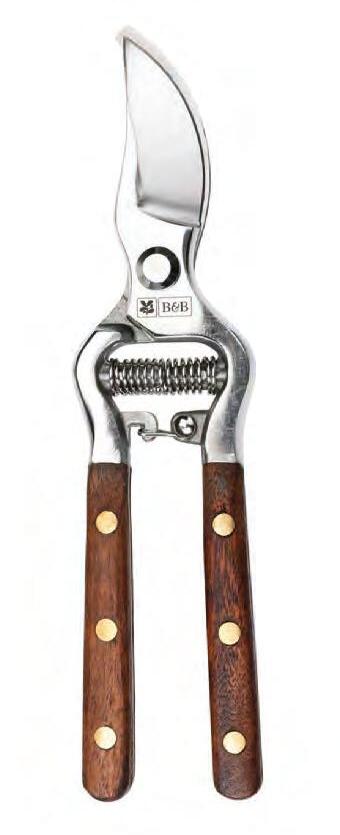
farrar-tanner.co.uk
Dust buster
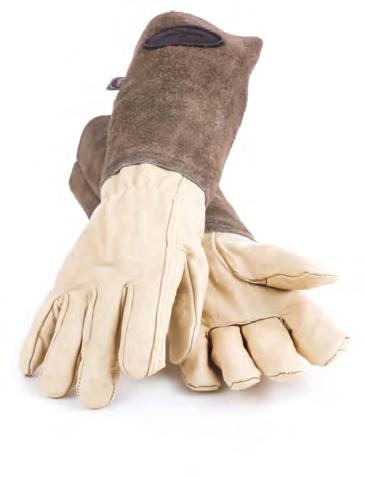
It is one of those problems many of us assume we will never solve: how do you clean that unsightly dust from your car’s ventilation slots? The solution lies in this handy and malleable Colorcoral Cleaning Gel which can be kneaded into a ball and pressed into the air vent. Promising to remove 95 per cent of a car’s dirt, this would be the ideal present for a child to give to a car-proud grandparent. £9.99.

amazon.co.uk
Hot tip
Making a big impact in gardens this year is the thermal weeder. Designed to deliver a heat shock of 70C to a weed’s roots, this lethal yet ecofriendly device causes a plant’s cells to burst, destroying it within seconds. The Hozelock version comes with a firelighter function, so can double up as a handy barbecue lighter. £70.

argos.co.uk
Advanced nostalgia
We all have a glut of photographs on our phones – but no digital image compares with the romance of a grainy Polaroid, printed the moment it’s shot. In recent years these retro cameras have had a resurgence in popularity, and the Instax SQUARE SQ1 is consistently voted among the best performers. With automatic exposure and nostalgic square film, this 1980s-looking model is deceptively advanced, even stretching to a built-in selfie lens. £119.99.

johnlewis.com
Winter warmer
Handwarmers used to have a somewhat frumpy image, associated with damp weather and chilblains. But thanks to some upbeat technology, this cosy gadget has become one of the season’s musthave fashion accessories. The sleek Ocoopa model is battery powered, comes with three heat settings, and can even charge a mobile phone. £29.99.
amazon.co.uk

4 The Oldie Christmas Gift Guide 2023
A. ASTES / ALAMY STOCK PHOTO
Instant co ee
Many readers will remember the nostalgic tinkle of a Teasmade, which had its heyday in the 1970s and is now almost extinct. But the spirit of this iconic gadget lives on in Lavazza’s A Modo Mio Voicy coffee machine with a built-in Alexa – which can be ordered to make you a flat white, while updating you on the news and weather. Drinks can also be remotely customised via the Piacere Lavazza App. Just don’t ask it for a humble cup of tea. £99.
lavazza.co.uk

Rhythm sticks
Sweeping statement
There comes a time in one’s life when vacuuming the house can feel akin to climbing a mountain. But this most arduous of household chores can now be delegated to the Eufy RoboVac G30, a vacuum cleaner that operates via a remote control or voice recognition. With a height of less than 3cm, it’s small enough to navigate under sofas and cupboards – and however hard you work it, it will never answer back. £300.

argos.co.uk
Private lights
Nightly squabbles over when to turn out the bedside light have put many a relationship under strain. But there will be no such tension with Vekkia’s 7 LED clip-on reading light, which creates a private illuminated space, allowing one partner to sleep while the other reaches the end of the chapter. With adjustable brightness and colour temperature, the device is also ideal for the nocturnal knitter. £13.99.
amazon.co.uk
Some of us might dread the day we will need a walking stick but, thanks to some innovative new designs, this functional item is actually cutting quite a dash. Cool Crutches offers a range of vibrant, bespoke walking sticks, decorated with everything from family photographs to glitter; and offers a Disco Walking Stick for revellers wishing to command attention on the dance floor. Each stick comes with a left- or right-hand option. Prices start at £50.

coolcrutches.com

Movie magic
Negative to positive
Haunted by boxes of negatives that you’ve been meaning to sort out for years? Are they boring old landscapes or could they be those treasured photographs of the family holiday to the Isle of Wight circa 1981? Thanks to Kodak’s Slide N Scan negative scanner, you can finally see them clearly and convert them to digital files. The scanner comes with a large, 5in LCD screen and also performs basic editing. £169.99.
amazon.co.uk

Loss leader

Nothing raises the blood pressure quite like a mislaid wallet. But a Tile Tracker will hunt down the errant item in seconds, even when it is miles away. Small enough to slip unobtrusively inside the wallet, the Slim Tile version can be telephoned when it is within Bluetooth range, or located on the Tile App when farther afield.
‘Darling, I’ve lost my wallet – could you give it a call?’ £29.99.
tile.com


Many of us have a library of video clips languishing half-forgotten on our devices. Hence a projector, enabling families to watch their home-movie footage on a 100in DIY screen, could be the perfect gift to enliven Christmas gatherings. With the Nebula Apollo Smart Portable Projector, your cinema screen can be created using anything from a bedroom wall to a darkened window, and the device comes with a built in six-watt speaker. £399.99.



johnlewis.com

The Oldie Christmas Gift Guide 2023 5
within
Record number
With vinyl records continuing their comeback, traditional turntables are set to be one of this Christmas’s most popular presents. ORCC’s 10-in-1 Record Player may look like something from a bygone age, but it is discreetly equipped with all the latest technology, including built-in Bluetooth, and also has a cassette player (remember those?) hidden in the back. £129.99. amazon.co.uk


Class monitor
You are (almost) never too old to improve your fitness, and a good activity tracker might be the inspiration that more senior athletes need to get started. Fitbit is the Rolls-Royce of the range, and its much-loved Inspire 3 model comes with heart rate tracking and even includes daily scores to show how well you are managing stress. £84.

Game changer
Croquet is reportedly in such decline that it risks being extinct within 20 years. All the more reason to buy one of Jacques of London’s exquisite handmade croquet sets. Prices start at £219.99 for a Sussex set for four players; for those with deeper pockets the £4,499.99 Balmoral includes a gold-topped winning peg.

jaqueslondon.co.uk

Fresh idea
Many an hour has been wasted attempting to retrieve garlic cloves from the depths of a vegetable drawer. But such frustrations will be a thing of the past with the Mason Cash Original Garlic Store. This elegant receptacle includes air vents to keep garlic fresh; and the lid incorporates a nifty underside grater. £12.09.

wayfair.co.uk


Immersion heater
What does the person to whom money is no object give to the person who has everything? The answer lies in a Swedish wood-fired hot tub, the rich person’s toy which has become more fashionable than a shepherd’s hut. Skargards’ newly improved Regal model is heated by an integrated wood-burner with a cast-iron door, and seats up to seven people, with optional underwater lighting. Just don’t tell the Joneses. From £3,590.
skargards.com
Going to press
The pleasure of watching one’s apples ripen on the tree can turn to nagging guilt when the fallen fruit lies uncollected. But there need be no more wastage with this 18-litre press, suitable for use with anything from apples to loganberries. With a double-handed system designed to reduce shoulder strain and an appearance worthy of Laurie Lee, this juicer shows that you are never too old to start making cider. £114.99.

primrose.co.uk
Cool for cooks
No Christmas is complete without a Lakeland gadget, and this ingenious cooling rolling pin would be the perfect present for anyone who has suffered the frustration of trying to roll out sticky pastry. The pin can be filled with ice or cold water to keep pastry chilled; and even contains a perforated cavity for flour, enabling you to re-dust the worktop with a single shake of the pin, and avoid having to fumble in the flour bag with doughy hands. £14.99.
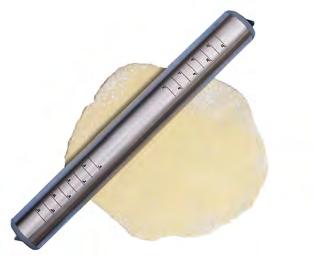
6 The Oldie Christmas Gift Guide 2023


Treats for bookworms
LETHBRIDGE picks
How to Survive a Classic Crime
Novel by Kate Jackson (British Library, £12.99) is for those with groaning shelves of golden-age crime novels. Kate Jackson has plundered the works of Ngaio Marsh, Margery Allingham and others to give tips on how the reader might survive a murder mystery: and what reader hasn’t sometimes given that some thought? Red herrings, hidden identities and police interrogations, all the clues are contained within.

And on that subject, GT Karber’s Murdle: More Killer Puzzles: 100 Fiendishly Foul Murder Mystery Logic Puzzles will test the wits of the armchair sleuth with a follow-up to the bestselling and addictive 100 Devilishly Devious Murder Mystery Logic Puzzles (both Souvenir Press, £14.99).
Little Toller books are always beautiful – inside and out. Among its recent volumes is All Round the Year by Michael Morpurgo, the diary of a year on Morpurgo’s Devon farm. It contains words by the Morpurgos’ Devon neighbour, the late Ted Hughes, and is illustrated by the lovely black and white photographs of James Ravilious, who captures rural Britain in images just as haunting as his father Eric’s, (£16).
And for those whose green pleasures come in smaller spaces, there is Little Toller’s reprint of the classic The Allotment by Colin
Ward and David Crouch. From the 17th-century Diggers to today, the allotment stubbornly survives in the face of an increasingly urban landscape. Irresistible (£16).

Graham Linehan, creator of peerless television comedies such as

Father Ted, The IT Crowd and Black Books, has written an account not only of a life in comedy but of a particularly contemporary rise and fall. Bloodied not bowed, he has survived brickbats and cancellation to write a memoir full of humour and of courage. No wonder fellow comedian Richard Ayoade said that Linehan’s prose ‘is equal in brilliance to his brilliance as a screenwriter’. Tough Crowd: How I Made and Lost a Career in Comedy (Eye Books, £19.99: from dan@eye-books.com).

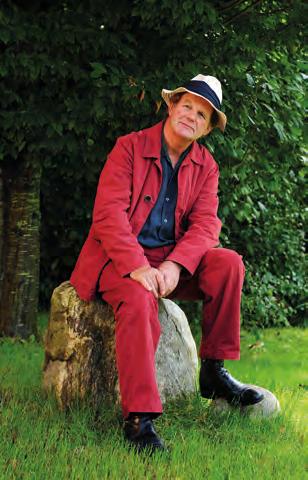
The late Dame Hilary Mantel was most famous for her extraordinary trilogy of novels about Thomas Cromwell. Devotees of Wolf Hall and its descendants will thrill to Memoir of My Former Self: A Life in Writing, published posthumously, a collection of her journalism, reviews and other writings that demonstrate the range of a consummate storyteller (John Murray, £25).
On the subject of writing, American essayist Jo Ann Beard will be less familiar to British readers but her recently published Collected Works is a delight. ‘The literary
8 The Oldie Christmas Gift Guide 2023
LUCY
the best reads for all ages this Christmas
Recording a year on his Devon farm: Michael Morpurgo
Extraordinary: Wolf Hall’s Thomas Cromwell played by Mark Rylance
WOLF HALL: © BBC WORLDWIDE. MICHAEL MORPURGO: JIM WILEMAN / ALAMY STOCK PHOTO



world’s best kept secret,’ said the reviewer in the Times. Beard writes from her own life, but as with all really great writing, her essays contain worlds within them (Carcanet, £17.99).
There’s a delicious new edition from Renard Press of Jane Austen’s Love and Freindship (and unlike the very enjoyable film, they’ve kept the original spelling). It was written in 1790 when Austen was in her teens and is an exuberant parody of the cult of sensibility which she was later to send up so excellently in her adult novels. As a bonus it has reprinted with it an introduction by G K Chesterton (Renard Press, £5).


The Running Grave by Robert Galbraith is the seventh in Galbraith’s series starring the attractively difficult private investigator Cormoran Strike. A worried father has been in touch to ask if Strike and his business partner, Robin (will this be the novel when they finally get together on the romantic front?), will rescue his son from a religious cult operating in rural Norfolk (Sphere, £25).

Great Uncle Harry: A Tale of War and Empire by Michael Palin (Hutchinson Heinemann, £22). At 80, Sir Michael shows no sign of slowing down – though his most recent book is a journey through the history of his own family rather than an ocean-going adventure. Palin only

recently discovered that he had an uncle Harry, his grandfather’s brother, who died in the First World War. His uncle’s life turned out to be more poignant and gripping than Palin could have imagined – and Harry re-emerges into the light in his account.
Cooks of all ages will enjoy the latest vegetarian cookbook by Anna Jones, One: Pot, Pan, Planet with its pleasingly William Scott-like cover (Fourth Estate, £28). If you are looking for ways to feast without meat then Jones’s mastery of a chickpea braise will be an inspiration.
Bee Wilson’s The Secret of Cooking: Recipes for an Easier Life in the Kitchen (Fourth Estate, £28) is the perfect present for the student or anyone setting up home for the first time.
Takes the Mastercheffy mystique out of everyday cooking, suggesting skills and hacks for a lifetime.
Old-school gluttons may prefer the ever-charming Stanley Tucci’s account of his love affair with the Italian food of his childhood, Taste: My Life Through Food (Fig Tree, £9.99) or the irresistibly greedy and hedonistic AJ Liebling’s Between Meals: An Appetite for Paris, his glorious account of gourmandising in 1920s France. Newly minted as a Penguin modern classic (£10.99).
Middle-earth completists will adore the new Letters of J RR Tolkien. Edited by his son
Christopher and Inklings expert Humphrey Carpenter among others, the new collection is a revised and expanded edition of previous collections and includes a summary of the entire plot of Lord of the Rings. Phew! (Harper Collins, £30).

The reliably interesting Handheld Press has produced a short biography Hilda Matheson: A Life of Secrets and Broadcasts (£13.99). Michael Carney and Kate Murphy draw a vivid portrait of a charismatic woman, a figure to be reckoned with in the cultural life of Britain between the wars, who ‘transformed the BBC into a broadcaster for the people’. Everyone you’ve ever heard of pops up in the life of this influential networker.
Good-oh, another Julia Donaldson book for the under-fives. Always a cause for celebration and this one is just out in paperback. Wonderfully illustrated as ever by Donaldson’s trusty collaborator, Axel Scheffler, The Baddies tells the story of a little girl who routs a gang of nasty meanies, a ghost, a witch and a troll. (Alison Green Books, £7.99).

The Oldie Christmas Gift Guide 2023 11
Attractively di icult: Cormoran Strike, as portrayed by Tom Burke
BBC
Family journey: Michael Palin
ONE / ALBUM
EDD WESTMACOTT / ALAMY STOCK PHOTO
Jane Austen
Impossible Creatures by Katherine Rundell (Bloomsbury, £14.99) is another corker from the acclaimed author of Rooftoppers In this one, a boy called Christopher slips through a portal into a strange archipelago inhabited by creatures that humans have always thought mythical: centaurs, griffins, phoenixes and sphinxes. Ideal for eight- to 12-year-olds.
The Unsung Folk Art of England and Wales (Chatto & Windus, £20) is a lovely look at a not-quitevanishing craft that lies, literally, below our knees. Church kneelers are little miracles of dedication, creativity and skill, valiantly staving off the twin foes of stackable chairs and shopbought kneeler kits. Bingham, a leading authority and practitioner on the subject, has produced a lavishly illustrated guide to some of the most inventive and interesting kneelers in the country.
Elizabeth Gould (1804-1840) was the painter of thousands of birds from all over the world, and 600 of her spectacular but meticulous and extraordinarily accurate paintings are collected in a sumptuous book published by Prestel. Ideal for art-loving ornithologists and anyone interested in the history of women in science: Birds of the World: the Art of Elizabeth Gould by Andrea Hart and Ann Datta (Prestel/Natural History Museum, £55).

Artist’s-eye view: sumptuous bird painting by Elizabeth Gould
A surprising bestseller is always intriguing. Notebooks of a Wandering Monk is what social media types would call ‘a palate cleanser’ amid all the froth and pointlessness. Matthieu Ricard’s memoir of his life’s journey from molecular biologist to Buddhist monk (translated from the French by Jesse Browner) has already sold millions of copies in the United States and has now arrived in hardback in this country in time to provide a possible moment of contemplation and serenity for someone at Christmas (MIT Press, £36).

Elizabeth Bingham’s Kneelers:
Peter Frankopan’s boldly allencompassing panorama, The Silk Roads: A New History of the World, was a hit when it was first published by Bloomsbury in 2015. Now the Folio Society has produced a special gift edition, cloth-bound and boxed in two volumes – and it’s gorgeous (£250).

Isabella Tree and her husband, Charlie Burrell, are surely the patron saints of British re-wilding. Having wilded their former dairy farm at Knepp in Sussex

with extraordinary success (species returning after what was sometimes centuries away), Isabella’s account, Wilding, was a runaway success.
Now they have collaborated on a guide to wilding for everyone –including those with small urban gardens or even just window boxes: The Book of Wilding: A Practical Guide to Re-Wilding Big and Small (Bloomsbury, £35).
Quoted prices are subject to change

12 The Oldie Christmas Gift Guide 2023
VIVIEN KENT /
ALAMY STOCK PHOTO
Wild and wonderful: Hammer Pond at Knepp
Monk’s progress: Matthieu Ricard (left)
TCD/PROD.DB / ALAMY STOCK PHOTO




The season of goodwill
Geoff Hurst: Sue Ryder
In 2010, my late daughter, Claire, was cared for at a peaceful Sue Ryder hospice. The nurses and care teams made Claire as comfortable as possible, giving us precious time together as a family and allowing us to go back to being Claire’s parents. The expert, compassionate palliative care and bereavement support given by this charity meant an awful lot to me and my family. sueryder.org
Mary Beard: Wintercomfort for the Homeless
Since the early 1990s, my local Wintercomfort has been supporting the homeless in Cambridge, with everything from housing, accessing dental treatment and writing a CV to helping homeless migrants with English lessons. Last year
Wintercomfort generously accepted my surplus-to-requirements turkey for its Christmas cook-up, but it prefers cash to keep on doing what it’s doing – which sadly is very necessary, even in deceptively leafy Cambridge.
wintercomfort.org.uk

Christopher Biggins: HOPE HOPE, set up by Maureen Forrest in Dublin, looks after Indian children on the streets of Kolkata. We house them, educate them and help them medically. indiahope.org
Melvyn Bragg: Mind
As a teenager, I had what nowadays are called ‘mental health issues’ and would have welcomed an organisation like Mind. Later, I became president of it for 15 years and saw the healing and supportive role it plays up and down the country. mind.org.uk
Gyles Brandreth: The Queen’s Reading Room
This new charity is the first to carry Queen Camilla’s name and encourages and celebrates reading. Research shows that reading for
even a few minutes a day promotes mental health and long-term happiness. Since she fell in love with Anna Sewell’s 1877 classic, Black Beauty, as a girl, the King’s consort has been an avid reader and believes there’s no friend as reliable as a good book, whatever your age.
thequeensreadingroom.co.uk
Craig Brown: The Teenage Cancer Trust and Ian Jack Memorial Fund for Waverley
The phrase ‘teenage cancer’ should be an oxymoron but, alas, it isn’t. The Teenage Cancer Trust provides specialist teenage units in NHS hospitals. On a cheerier note, Ian Jack’s Memorial Fund for the Waverley was set up by the great journalist’s widow and children to ensure the survival of the world’s last seagoing paddle steamer. I travelled from Southend to Tower Bridge on it with Ian ten years ago; it would be awful if future generations were to be denied this deep and magical pleasure.
teenagecancertrust.org
waverleyexcursions.co.uk/supportingwaverley/donate-to-waverley-inmemory-of-ian-jack/
Joanna David: National Brain Appeal
Thirty years ago, I was operated on for a rare condition, and the surgeon and his team at the National Hospital for Neurology and Neurosurgery saved my life. I have been involved with the National Brain Appeal ever since.
It raises vital funds for the National Hospital which transforms people’s lives by diagnosing and treating conditions such as strokes, multiple sclerosis, brain tumours, epilepsy, Parkinson’s disease and dementia.
nationalbrainappeal.org
Edward Fox: Unicorn Theatre
Live theatre is so important for children, and the Unicorn is the UK’s leading professional theatre producing inspiring and invigorating work for children aged two to 13. It’s so uplifting seeing the passion they
bring to live theatre away from the screen world. The Unicorn offers subsidies to groups and creatively collaborates with children in schools and communities.
unicorntheatre.com
Henry Dimbleby: Chefs in Schools
My favourite charity is Chefs in Schools. Though I chair it, it’s the baby of the two amazing women who run it: Nicole Pisani, who used to be head chef at Ottolenghi’s NOPI restaurant, and Naomi Duncan. They help state schools in deprived areas recruit chefs and retrain teams to cook proper food for the children and teach them how to cook. Their aim is to transform 5,000 schools, a fifth of all English schools, over five years, which could have a huge effect on the country’s health, wealth and happiness.
chefsinschools.org.uk
Michael Dobbs: Graham Layton Trust
Fifty-three million – that’s the number, young and old, with blindness or failing sight that the Graham Layton Trust has already helped – and all for free, in Pakistan. While the headlines scream chaos, for years GLT has been quietly saving sight, saving lives, restoring hope.
glt.org.uk
Julian Glover: Actor’s Children’s Trust (ACT)
In 1896 Sir Henry Irving founded the Actor’s Children’s Trust to support actors’ children with activities, childcare (the most expensive in Europe), illness, disabilities and special needs. Noël Coward and Richard Attenborough were devotees. The Trust depends on donations to ensure that parents can continue to have professional acting lives.
actorschildren.org
Simon Heffer: War Memorials Trust
The War Memorials Trust ensures that the Glorious Dead, who made
14 The Oldie Christmas Gift Guide 2023
We asked some famous names to nominate their favourite charities.
Here are their suggestions for giving to others this Christmas
sacrifices most of us can’t even imagine being asked to make, continue to be remembered. That we live in a free country is in no small part down to them, and the more time that passes, the more it is society’s duty to preserve these monuments. Patriotism may have become unfashionable, but it should never be unfashionable to preserve the memories of those motivated by it to fight for our freedom.
warmemorialstrust.org
Christopher Howse: Church in Need


Aid to Church in Need might sound
sectarian, but I’ve found it astonishingly universal, bringing help to persecuted Christian communities and promoting reconciliation. In the late 1940s it helped refugees from defeated Germany. From the 1950s, it worked behind the Iron Curtain. More recently it’s helped Christian communities who’d lived in Iraq for centuries to stay there.
churchinneed.org
Mary Killen: Orbis


One billion people live with 90 per cent avoidable vision loss but Orbis redresses the lack of

ophthalmologists in low- and middle-income countries with its Flying Eye Hospital and clinics. Since 2014 there have been 490,000 training sessions for the next generation of eye-care professionals, while volunteer ophthalmologists and nurses have helped deliver more than 500,000 eye surgeries. Cataracts can be treated for as little as £48 for both eyes.
orbis.org


Giles Wood:

Wetlands International Reading Michael McCarthy’s The Moth Snowstorm, I learnt that

WENN RIGHTS LTD / ALAMY STOCK PHOTO
Clockwise from top left: Melvyn Bragg; Mary Beard; Edward Fox; the Waverley paddle steamer, nominated by Craig Brown; Henry Dimbleby; Christopher Biggins; Giles Wood and Mary Killen.
MICHELLE SALEN
STEVEN
MAY / ALAMY STOCK PHOTO
PAUL BROWN / ALAMY STOCK PHOTO
the land reclamation of an estuary in Saemangeum, South Korea, has ‘done more damage to shore bird habitat than any comparable project in history’. Wetlands cover a small percentage of the Earth’s surface yet are its arteries, acting as water sources, purifiers and shoreprotectors, and are the planet’s greatest natural carbon stores. Current projects include mangrove regeneration and replanting. Vital forests are under threat from climate change-caused sea-level rise, urbanisation and agricultural expansion. wetlands.org
Rowley Leigh: StreetSmart
Charity may not begin at home but on the streets of London.
StreetSmart is an umbrella charity that funds various small charities and hostels looking after, housing and feeding London’s homeless. It’s mainly funded by London restaurants but needs all our help more than ever, especially at Christmas.
streetsmart.org.uk

Roger McGough: KIND Liverpool
Founded by Stephen Yip in 1975, KIND has made a huge difference to disadvantaged children and families in and around Merseyside, providing up to 3,500 with education and classes promoting confidence and creativity through the arts.
In 2008, it transformed a derelict inner-city site into the Seed Centre, an eco-friendly, multi-purpose education and community resource. kind.org.uk
Virginia McKenna: Born Free Foundation

Co-founded with my late husband, Bill Travers, and my eldest son, Will, Born Free responds to the needs of one: one suffering wild animal; one threatened species; one marginalised human community; one fragile habitat. And it takes one donor’s kindness to make a positive difference. bornfree.org.uk
Griff Rhys Jones: East Anglia’s Children’s Hospices (EACH) EACH provides dedicated care to dying children and their heartbroken parents near Ipswich, Norwich and Cambridge. I never knew before how courageous people can be. I can’t think of a more direct charity than this. You give. They

Clockwise from top left: Griff Rhys Jones, Tim Rice, Jeremy Paxman and Virginia McKenna
help. And it’s not about death, it’s about making the most of life. Our show on 4th December, with stars including Joanna Lumley, Dara O’Briain, Omid Djalili and Rob Brydon, will be a tiny help. each.org.uk
Jeremy Paxman: Surfers Against Sewage (SAS)
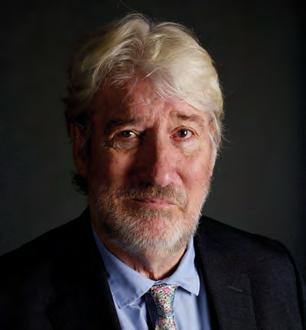
I’m doubtless too old to surf, but I have a huge regard for SAS, which wages a ceaseless campaign to keep our rivers and seashore clean. The water companies are bastards. sas.org.uk
Sir Tim Rice: Foundation of Light

Although a softy southerner, I have been a supporter of Sunderland football club since the mid-1950s and have long been a trustee of the Foundation of Light, which uses the power of football to inspire and tackle the social and educational problems of the North-East. It’s done wonderfully well. foundationoflight.co.uk
Sarah Sands: The British Heart Foundation
This year, my brother, Kit HeskethHarvey, died of extreme heart disease. The coroner’s report said that his heart was working at less than 20 per cent capacity and yet he was at full creative ferocity, doing three panto performances a day, finishing an opera, writing a Radio 4 drama, performing in cabaret and, his very last act, writing an anthem
for a processional cross at the former Archbishop of Canterbury’s request. A doctor said that Kit would have felt absolute exhaustion but, as far as Kit was concerned, the show had to go on, whatever the cost.
bhf.org.uk
Anthony Seldon: DrugFAM
This small charity was founded by Elizabeth Burton-Phillips, who lost one of her twin sons to drugs. DrugFAM offers professional help for those coping with the nightmare of a loved one’s addiction, and I’m honoured to be a patron. After all, how many of us can say that our lives, or those of our family or close friends, have not been blighted by alcohol abuse or drugs?
drugfam.co.uk
Roy Strong: Cats Protection
I’ve never been without a cat for over half a century. Tabitha now runs my life. So, my charity is Cats Protection, where I sponsor two nests for rescued cats.
cats.org.uk
Rowan Williams: Justice Defenders
Justice Defenders, of which I’m a patron, works with African prisons. It offers advocacy to help improve the often appalling conditions in some countries’ jails. In partnership with King’s College London, it also provides law training to help prisoners conduct their own appeals. justice-defenders.org
16 The Oldie Christmas Gift Guide 2023
SOPA IMAGES LIMITED / ALAMY STOCK PHOTO ©
ALYWN COATES
JIM HOLDEN / ALAMY STOCK PHOTO
NEIL SPENCE / ALAMY STOCK PHOTO

SARA WHEELER seeks out exotic winter destinations

Chasing the sun
Sun! You know you crave it after our tepid summer (I don’t count a scarce handful of hot days in July and September). Midwinter is the perfect time to visit South America. I finally made it to Colombia this year. I travelled around independently by public bus (we would call the vehicles coaches), which was heaven itself: one sits very high enjoying a perfect view, with aircon and a lav at the back, and cheery types get on from
Wilson’s birds of paradise colonise the lowland rainforest. It takes a long time to get there (three flights, a ferry and a longboat) so you really need three weeks to make it worthwhile, but you won’t regret it. Note: this society venerates the elderly and, white hair functioning as semaphore, you will be received en prince. There are no roads – you and everyone else putter about in longboats. Homestays are excellent (stayrajaampat.com) – you get your own stilted thatched hut over the water and three meals a day for £20 per head. There are no shops, and no commercialisation of any kind. Even the homestay hosts have not yet learned to sell beer or other extras to paying guests.
If you want short-haul sun over the holidays I always say the Canaries are your only option if you live in the UK. I went once for Christmas and had a pleasantly turkey-free time: you can hire a car or a moped or a bicycle to get inland away from the hotels, even an oldie-friendly electric bike now.
time to time selling cheap and delicious comestibles. Seats are easily booked online in advance (I used redbus.co – note the .co, not the .com we are used to typing). The seven-hour trip north from Mompox into Santander province, at first following the fabled River Magdalena, was a highlight, ending at the high-altitude Barichara, a cobbled outpost of colonial architecture and desuetude. I spent three nights there but might never have left. Booking.com has a stranglehold on the country for some reason, so you might as well use it – I did. There’s almost no accommodation, high or low, that does not trade through this site. You’ll find you can easily become a Genius member of Booking.com – and reap a few minor benefits. Everyone seems to think Colombia is dangerous, but I don’t believe it is anymore.
The Raja Ampat islands, south-west Papua: now, this is ambitious, but I promise it is one of the true paradises left on this battered planet. The Raja Ampat archipelago and its multitudinous karst atolls spray out of the top of the Indonesian half of New Guinea and are populated by mostly Christian ethnic Papuans and Moluccans who live off the fruits of the ocean. The reef here is pristine – one of the last, and you don’t have to scuba: a simple mask reveals tropical fish without number as well as lone sea turtles.
I don’t like to promote Saudi Arabia, for obvious ethical reasons, but I visited the ancient incense route in the north-west desert to inspect the ruins at AlUla (yes, the powers-that-be insist on that absurd orthography). Nabateans founded Hegra when they shifted south from Petra in about the first century BC. Across the 50-hectare site archaeologists have discovered 130 pre-Islamic tombs gouged from cliffs and excrescences. The Dedan necropolis is even earlier, and once among the most developed independent kingdoms in northern Arabia (the Old Testament Book of Ezekiel mentions Dedan). At Jabal Ikmah, a slim rocky gorge, my female guide showed me what she called ‘Nabatean Twitter’: hundreds of inscriptions carved in different alphabets. Unlike at Petra, you will have AlUla sites to yourself. Headcoverings are not required for women and no goons followed me, as far as I know. You can fly direct into the small AlUla international airport from Dubai, Cairo, Amman and various Saudi cities. Go to abercrombiekent.co.uk or trailfinders.com

Tenerife, Gran Canaria, Lanzarote, Fuerteventura and La Palma all have international airports (Tenerife South has the most UK flights) and you can fly out of a variety of cities including Bournemouth and Newcastle. Take a look at travelsupermarket.com – if you are determined, you can get a week-long package in December for under £500 per head, flight included. Lastminute.com currently has December offers as low as £230 (do it the old-fashioned way if you prefer and call 020 3386 8411). For a little extra, connect with a domestic flight to the quieter La Gomera.

And one for grumpy old gits who prefer a rainy festive season (more to complain about). I went to Buxton
this year for the first time and loved it. I stayed in the wonderful Number Six The Square (no6tearooms.co.uk) which is Jane Austen tout court and overlooks the Buxton Opera House – book a tour of this place even if you can’t take in a show. Built in 1903 by architect Frank Matcham and gloriously restored in the 1970s, the Opera House keeps going magnificently, not least thanks to a valiant team of oldster volunteers. Over the Christmas period it has Cinderella, and on New Year’s Eve the British Philharmonic Concert Orchestra will play a programme of old favourites to see in 2024 –warning: includes Auld Lang Syne (buxtonoperahouse.org.uk or 01298 72190).
Happy travels.

18 The Oldie Christmas Gift Guide 2023
High point: Barichara, Colombia
A history lesson in the desrt: ruins at AlUla, Saudi Arabia
Magnificent: Buxton Opera House COLUMBIA: STUART PEARCE / ALAMY STOCK PHOTO. ALULA: LEO MORGAN / ALAMY STOCK PHOTO. BUXTON: MATTHEW TAYLOR / ALAMY STOCK PHOTO

ELISABETH LUARD selects the best festive delicacies

Food, glorious food
Perfect puds
Fraser’s Christmas puds prepared to an old family recipe – maybe even better than your own and certainly a lot less trouble – are lusciously dark and appley, nutty, fruity, spicy and thoroughly laced with stout, cider and rum. The Fraser ladies of the current generation have replaced the usual beef-suet with sunflower oil, which makes the puddings suitable for vegetarians. A family business garlanded with eco-awards, the shop and mail-order business are a mother-and-daughter enterprise based on the family farm in Kent using local produce, including free-range eggs. A dear little half-pounder for two clocks in at £8, a one-pounder to serve four at £11.75 (includes delivery, normally extra), and *OLDIE DISCOUNT*we have an Oldie special two-pounder to serve eight (slice and fry the overs in butter – yum!) for £17 (including delivery). Order on frasersegerton.co.uk; 01233 756122.
Super salmon
Push the boat out with a whole side of Belhaven’s light-cure smoked salmon from a small-scale smokery near Dunbar, just east of Edinburgh. It’s juicy, fresh-flavoured and surprisingly unsalty: think gravadlax without the dill, but smoky. Belhaven’s salmon is eco-farmed in the clean, clear waters of the Shetlands (next best thing to the wild). Just right for nibbles with drinks on Christmas Day, as starter before the meal or served with a mustardy remoulade and a warm potato salad on Boxing Day – freeze any leftovers for kedgeree or fishcakes (a little goes a long way). They’ll deliver a whole sliced side (minimum 0.9kg) for £40 and *OLDIE DISCOUNT* waive the £8.95 delivery charge for Oldie readers: use code theoldie when you order on belhavensmokehouse.co.uk; 01368 864 025.
Top truffles
Bite-sized chocolate truffles no bigger than a blackbird’s egg from specialist chocolatiers Atwell & Russell punch well above their weight. Each is an exquisite mouthful of fresh cream sweetened
From top: a Fraser’s Christmas pudding; Belhaven’s light-cure smoked salmon; the Ultracomida Oldie kit for a Spanish-flavoured celebration
with English honey in a delicate chocolate shell. They’re rolled a little unevenly and dusted in cocoa so they really do look like their namesake, Tuber melanosporum The truffles come in re-sealable pouches with instructions to keep them in the fridge. Russell is the chocolatier with a background in commercial chocolate, Atwell’s family has been in the business since 1921, and their atelier is just down the road from Bournville, where they both worked. Both wanted to do something they could be proud of. Small is beautiful, and gourmet truffles, prepared with the best possible ingredients, are what they
really wanted to do. Order up their Christmas three-pack at russellandatwell.com

Right royal cheese
Skip the cheeseboard this year and go for a single whole fresh cheese –so much more festive than bitty bits that dry out – from Sussex-based cheesemaker Alsop & Walker. Its pyramid-shaped Lord London (as served at the wedding of our new Prince and Princess of Wales, no less) is a semi-soft cow’s-milk cheese with a snow-white edible rind, minimum weight 500g. Its creamy golden curd starts chalky then develops a brie-like centre as it matures (this will happen naturally in the fridge). Delicious given a quick blast in the oven as a dip for bread, or serve straight from the fridge by the spoonful or with a handful of grapes. Order at £18 each (to serve six to eight) plus £6.50 p&p on alsopandwalker.co.uk

Paella party
Throw a morning-after paella party with the autentico essentials from Ultracomida, Wales-based Spanish food-and-wine importer. It’s put together a special Oldie kit with all basics: paella rice, olive oil (essential for flavour as well as the initial frying), seasoning mix, a doublehandled paella pan (serves six to eight – invite the neighbours), plus a jar of ready-cooked judiones (big white beans), a tin of pimientos del piquillo, a print out of my own Boxing Day paella recipe, and a free box of almond turron for afters –and all for £40.05 plus a £9.95 delivery charge (it can’t do all-in prices on its website) which comes to £50 at checkout when you add the code XMASPAELLA23

The offer runs till 17th December –how irresistible is that? Order at ultracomida.co.uk; 01970 626 008.
Taste of sunshine
Stock up for the holiday season with extra virgin olive oil imported direct from Crete by a mother-anddaughter team working out of London. It’s a small-scale business and the oil is pressed from the fruit of ancient olive groves on the father’s
20 The Oldie Christmas Gift Guide 2023
land and the villages round about. Buttery and sweet, with a muscular edge and just enough leafiness to hold its own in a simple dressing for leaves or plain-cooked vegetables with a squeeze of lemon and salt, or as a finishing stir for a stew or a warming winter beanpot. Or just as a dip with freshly baked bread for a taste of Mediterranean sunshine from olive groves that flourish a mere swallow’s swoop from the tumbled walls of the palace of Knossos, where Theseus did battle with the Minotaur. The usual price for 1 litre of EV organic olive oil is £24.98 (plus delivery at £6.70), but *OLDIE DISCOUNT* Oldie readers receive a 12 per cent discount on the oil when using the code XMAS2023-1L on itania.co.uk
Mrs D’s delights
Small enough to tuck into the Christmas stocking is a boxed set of Elizabeth David’s single-subject booklets, as sold by the till in her shop in Pimlico (and nowhere else) in the 1970s. The four titles – The Baking of an English Loaf, Dried Herbs and Condiments, English Potted Meats and Fish Pastes and Syllabubs and Fruit Fools –have long been collectors’ items. Happily for the rest of us, Grub Street has brought them into print as beautifully produced little hardbacks in a slip-case. Lots of useful Christmas recycling recipes as well as classic English cooking. Mrs D would surely be delighted. Order for yourself and anyone else whose culinary judgement you trust at £25 from your favourite bookseller or direct from the publisher at grubstreet.co.uk.
Great game



Not forgetting the star of the feast, do your bit for the national game-larder with a stuffed pheasant or a threebird-roast (pheasant breast stuffed with partridge and pigeon, neatly rolled and tied for ease of carving) – from the gourmet-food grandees at DukesHill. They’ve introduced a seasonal Wild British Game Collection that carries the British Game Assurance guarantee, the game equivalent of the Red Tractor stamp, as confirmation that the shooting estate is properly and sustainably managed. Wild meat is
lean, muscular and tastes good –better still, all the hard work has already been done for you. Both choices are available mail-order from the website: stuffed pheasant (minimum 600g) serves two to three for £25; the three-bird-roast comes in at £65 (minimum 1.2kg), which is more than enough for a family of four with plenty of leftovers for potting à la Elizabeth David (see above). *OLDIE DISCOUNT* For 20 per cent off your first order, use code OLDIE20 at dukeshill.co.uk



Something fishy
Stock up with a four-pack of classy tinned fish from the North Atlantic, the latest gourmet must-have, just the thing for a kitchen supper when you can’t face another leftover makeover, maybe with a baked potato and grilled lemon quarters (smell delicious and squeeze easily). There’s no need for any fancy plating; open up the tins and serve as they come, perhaps with pickled cucumbers and buttered brown bread. Fangst – fangst.com –is the enterprising Danish outfit responsible for switching the usual Nordic brine-and-vinegar situation to the softer Mediterranean way of preserving fish under oil. For its Christmas special – Faroe Islands salmon, herring, smoked trout, mussels – order from thetinnedfishmarket.com; 020 8469 3727.
CHRISTMAS OFFER




The Partridges Oldie Christmas Deli Hamper

It includes: Partridges Pinot Noir (75cl bottle); Partridges Extra Virgin Olive Oil (500ml); Fortt’s Original Bath Oliver Biscuits (200g); L’Aquila Salsa Tru ina (130g); Alejandro Natural Chorizo (200g); Partridges Partridge



Terrine with Port Wine (180g); Partridges Chelsea Flower Coronation Tea Limited Edition (20 teabags); Époisses Cheese – One; Patum Peperium The Gentleman’s Relish (42.5g).

HOW TO ORDER: Priced at £120, including delivery to mainland UK, this sumptuous hamper includes all the seasonal fare an oldie could possibly desire from wine and tea to Gentleman’s Relish.
Use the code OLDIE23 when ordering from www.partridges. co.uk/the-oldie.html or call 020 7730 0651.
For Christmas carving: the three-bird roast from DukesHill
AHMET CIGSAR / ALAMY STOCK PHOTO



Fun for the whole family
Into the woods
The trees of Westonbirt Arboretum are stunning at any time of the year, but its Enchanted Christmas days take everything to another level, turning the place into a genuine winter wonderland with sparkling lights and mesmerising installations. 24, 25 Nov; 1, 2, 8, 9, 15-17, 19-23 Dec, 4-9.30pm; from £19 adult, £12 child, booking essential. forestryengland.uk

They think it’s all over
It’s terrible news (except for Scrooges among us): Sorry, Christmas is Cancelled... that’s the name of the show at the Carriageworks Theatre, Leeds. But the clue to its happy ending is in the rest of the title: Katie Saves the Day! Just as well, since this tale of thieves breaking into Santa’s grotto and stealing all the presents is aimed at two-year-olds and upwards – who might not be able to handle the ramifications of such a crime going unsolved. 17-31 December; £11, £9 over-60s. carriageworkstheatre.co.uk
Santa’s here…

There’s nothing quite like a Victorian Christmas; and not only will Santa Claus be receiving visitors in oldfashioned style in his grotto at the Museum of London, but the museum’s re-creation of yesteryear docklands will also be done up in festive Victorian fashion. 2-23 Dec, £13.50 per child.

museumoflondon.org.uk
…there and everywhere
Santa will also be sailing on the Beaulieu River in the New Forest to greet Christmas canoe trippers and distribute gifts (9-23 Dec; £36 adult, £24 child); on a cruise boat on the Ouse in York dispensing jollity and presents (25, 26 Nov, 2, 3, 9, 10 and 16-23 Dec; adult £15, child £17); and telling stories at Warwick Castle (25 Nov-24 Dec; £38, £13 under-three) amid festive illuminations, a Christmas market and ice skating. How does he manage to be in all these places at the same time? It’s magic of course. thenewforest.co.uk cityexperiences.com warwick-castle.com
Deer life
Father and Mrs Christmas will be in the Parade Ring at Ascot racecourse’s festivities before the races start. There will also be free fairground rides, candle-lit carols, a brass band and, perhaps upstaging everything, the appearance of reindeer. 23 Dec, from 10.45am; £30 adult, children free. ascot.com

Have an ice time
A dancing ice princess and juggling ice king are among the afternoon tea attractions at the Ice Palace. But the children’s attention may be drawn to treats such as coconut and citrus snowballs, Christmas tree ‘cakesicles’ and mini gingerbread people. The confection of shimmering icicles and twinkling lights is part of London’s Strand Palace hotel. 6 Nov-5 Jan, 12.30-5pm; adults £49 weekdays/ £59 weekends; children £20/£30. strandpalacehotel.co.uk
A very silly Christmas
Probably the daftest and funniest Christmas story of all is that of Elf, the boy mistakenly brought up with Santa who heads off to New York to trace his real father. The stage show of the film (it appears to be compulsory these days) is back in the West End. 15 Nov-6 Jan; from £27.50.
elflondon.com
Strictly family
Much more traditional is the panto at the Hilton Brighton Metropole. The razzle-dazzle of Cinderella is aimed very much at the family. And it appears not to feature names from the Strictly Come Bake Off’s Got Talent genre – perhaps a bonus. 20-30 Dec; from £10.
brightonfamilypanto.com
Manor from heaven
Stately Edwardian manor Polesden Lacey in the Surrey Hills is staging A Fairytale Christmas. Indoors there will be immersive story-book scenes, while outdoors there will be a trail inspired by well-known children’s tales. All this, plus vintage carousel rides. 25 Nov-7 Jan, excluding 24, 25 Dec; normal admission fees, plus outdoor trail £3, rides £3. nationaltrust.org.uk/visit/surrey/ polesden-lacey
Jolly rogering
Oldies will remember Buccaneer, a board game celebrating those human traits of greed, violence and lawlessness. The 2023 incarnation of high-seas high jinks on the livingroom table is Pirates of Maracaibo in which you can maraud around the Caribbean in search of treasure. Up to four players, age 12-plus; by dip Games; approx £50 meeplescorner.co.uk
Playing the triangle
Our own family favourite game is Triominos Deluxe. It’s what it says on the box: dominoes with an extra dimension – they have three sides and three numbers. It’s easy to learn and genuinely fun for the whole family. Two to four players, age seven-plus; by Goliath Games; £31.99 vividtoysandgames.co.uk
The Oldie Christmas Gift Guide 2023 23
Christmas can transcend generation gaps and bring everyone together. NIGEL SUMMERLEY offers bright ideas for all ages
WESTONBIRT: CASPER FARRELL / ALAMY STOCK PHOTO; PENGUINS: JEFF GILBERT / ALAMY STOCK PHOTO; ASCOT: INSOOK GARDINER / ALAMY STOCK PHOTO
From top: enchanted Westonbirt Arboretum; Christmas at Polesden Lacey; Ascot’s star racegoers

ROGER LEWIS recommends some of his favourite movie treats
DVDs for Christmas

The Driver’s Seat (1974)
Elizabeth Taylor’s least-seen film, a veritable lost masterpiece. Andy Warhol is in the cast, along with the gurgling Mona Washbourne and the always slightly mad Ian Bannen. Based on a Muriel Spark novel, it concerns a woman travelling to Rome to search for a man who will murder her. I suppose the idea is: can a person arrange their own fate? I saw the film on a bootleg disc transferred from a blotchy VHS. It has now been lavishly remastered by the BFI, with a booklet and all sorts of fancy extras. The cinematography was by Vittorio Storaro, responsible for the lustre of Last Tango in Paris and Apocalypse Now.
Summer’s Lease (1989)

It makes me mad. We have spent over a decade restoring a donkey hut in the Molise for our retirement. Then Brexit happened –‘terrible things are done in the name of dreams’ (Doris Lessing) – and we (all of us) are now forbidden from spending longer than 90 days on the Continent. So instead, I watch films and programmes about the place. This one, based on a John Mortimer book, was made lovingly on location near Siena and Arezzo. Emmy-winner John Gielgud and Leslie Phillips are on view. It’s all about water problems at the rented villa, mafia involvement, disappearances, and Piero della Francesca.
Early Doors (2003)

My favourite comedy, affecting as well as hysterical, as when in the pub quiz somebody says the capital of Chile is Con Carne. Written by Craig Cash and Phil Mealy, it is a sequel to The Royle Family – more Manchester folk, this time killing time staring at a pint pot rather than in front of the telly. What great performances they all give: John Henshaw, Mark Benton, Lorraine Cheshire, Rodney Litchfield; and how beautifully it is filmed, the poky pub positively glowing with a
yellowish light. It’s quite stylised, with views through the frosted glass windows, and the world it evokes – the traditional English saloon bar with people smoking – has now vanished.
Who’s Afraid of Virginia Woolf? (1966)

Burton and Taylor’s most famous film, the characters battling their way through the evening as the stars did in real life, downing drink after drink, their relationship sustained by mutual recrimination and humiliation. Directed by Mike Nichols, it never loses its raw power. George Segal and Sandy Dennis are George and Martha’s mousey audience. I don’t know if this was an April Fool joke, but there was a rumour Burton was to appear on stage in a homosexual version with Henry Fonda.
Antonio Carluccio’s Southern Italian Feast (1998)
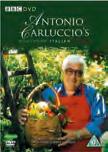
Evocative flavours and textures – bright red peppers, and the lemons more lemony, and the melons more melony than can ever be imagined in British shops. Carluccio looked like a burly Mediterranean Barry Cryer, as he waddled appreciatively around picturesque towns, shops, kitchens and the Abruzzi countryside. Nevertheless, my son once saw him in Waitrose, Petersfield, buying a canister of squirty cream.
The Kenneth More Collection

More was English in the way Burton was Welsh – an embodiment of the archetypes. He was to be relied upon for chortling good cheer and breeziness, an officer-class dependability, with a crisp, attractive speaking voice. Whether it’s vintage cars (Genevieve), locomotives (North West Frontier) or the Titanic (A Night to Remember), he’ll slap an engine’s flanks and cry, ‘Come on, you old beauty!’ Female co-stars are similarly joshed. In Reach for the Sky, More’s Douglas Bader – a role Burton rejected – is much nicer than the real Douglas Bader, who incidentally got
drunk easily because he had no legs. Even though he had hollow legs, he didn’t have hollow legs, if you follow. More is increasingly treasurable and, as with David Niven and Cary Grant, there are no contemporary equivalents.
Tim Minchin So F**king Rock Live! (2008)

The lyricist and composer of the Matilda and Groundhog Day musicals is also a brilliant performer, hopping about barefoot and in mascara like an Australian elf. His songs are as ingenious as Victoria Wood’s – a comic facility coupled with psychological insight, even philosophic insight: ‘Science adjusts its views based on what’s observed / Faith is the denial of observation so that belief can be preserved’. One of his songs is entitled If You Open Your Mind Too Much Your Brain Will Fall Out. Sheer energy and genius. Look for the double-disc special edition with the interview material and clips.
The Girl Who Had Everything (1953)

You’ll have to obtain this from Spain, though the soundtrack thankfully is the original English-speaking one. Another overlooked Taylor picture – and if any girl ever had everything, it was Taylor, with her husbands, diamonds, yachts, private jets, money, fame. Co-starring as her father is the imperturbable and ironic William Powell, who plays a Kentucky lawyer defending a gangster sleazeball, for whom spoilt only-child Taylor instantly falls. There is a good deal of erotic attraction, with Taylor required to climb in and out of swimming pools. She and the gangster, Fernando Lamas, gaze at horseflesh in paddocks or rush home early from restaurants. Taylor, married to Michael Wilding at the time, is quite gorgeous – and it is good to be reminded she wasn’t always the wheelchair-bound Chaucerian bawd we mostly remember from her later years.
Roger Lewis’s Erotic Vagrancy: Everything About Richard Burton and Elizabeth Taylor is published by Quercus

The Oldie Christmas Gift Guide 2023 25
A child’s Christmas in Northern Ireland
MARY KILLEN loved the innocent days of her youth
During Christmases of the 1950s and 1960s, Northern Irish children knew nothing of present mountains.
What we did know about was dancing and skipping for weeks in anticipation of the one present we knew we would get. This surprise sat tantalisingly below the tree for up to a week beforehand.
We didn’t even dare secretly to unknot the twine and peek inside. It’s funny to think of now but, in the past, children used to obey their parents rather than the other way around.
In my household, we were also excited by the arrival of a group of semi-comatose guests, who would be propped like so many sacks of potatoes, around the glowing coal fire. These were residents of the local nursing home who had no family to go to at Christmas. All the GPs of the town – my father was one – would make room for a handful of them at their own tables, as it was the season of goodwill. We were fascinated by the waxen strangers.
Christmas was a special time because things happened then that just didn’t happen during the rest of the year. We didn’t have turkey and all the trimmings, brandysnaps or mince pies at any other time. Great waves of pleasure came with each mouthful and everyone groaned ‘Mmmm!’ and marvelled at the unfamiliar taste sensation.
Since greed was not an option for the rest of the year, there was no question of the feasting being overshadowed by self-loathing.
Indeed, until as late as the Seventies – even in sophisticated Kensington – it was established that many children, and even some adults, would be sick on Christmas Day. It was almost a custom.

Only at Christmas was there plum pudding with the chance of finding a hidden sixpence. As with fish bones and chicken bones, the children of yesteryear could look after themselves and make a point of not swallowing them.
Only at Christmas did the Bakelite musical box which played Silent Night come out. It took the form of a white church the size of a biscuit tin
and it lit up while the tune was playing. We stared at it for hours but the door and windows were sealed – which frustrated us as we wanted to insert our figurines made of pipecleaners to act as the congregation.
Only at Christmas did the tree and decorations come out – ancient and fragile glass balls, and the angel (called ‘the fairy’ in Ireland) at the top, which caused vague unease. It didn’t seem right that she had to live in the attic for the rest of the year.
‘Ah,’ said my mother dismissively, ‘she’s a fairy. She goes back to Fairyland during the rest of the year.’
I believed her, of course, even though the assertion posed many unanswerable questions along with ‘How can Father Christmas drop stockings for all the children in the world if there is only one of him?’
The stockings typically contained: one tangerine, cupped in silver paper and with a leaf on it, and more pertinently giving off the intoxicating scent of tangerine; a small game of tiddlywinks with dice; a magic pad that you could draw on then slide a bar across to wipe the drawing; and maybe a comb.
And in those innocent times we were thrilled by these. Nothing was plastic and there was no such thing as mounds of Barbies or noisy electronic toys (without batteries).
To digress, do you know how Michael O’Leary first had the brainwave for his business model?
He started a corner shop in Dublin
and kept it open on Christmas and Boxing Day, selling wildly overpriced boxes of chocolates and batteries.
O’Leary said that he had to waddle home on Boxing Night, so great was the amount of cash. It gave him the idea of exploiting human unpreparedness.
Consequently, Ryanair sold cheap flights. But if you didn’t plan ahead and print out your boarding card before going to the airport, then you could obviously afford £40. And you deserved to pay it.
One year, I remember being puzzled by the colourless streamer that waved through the branches of the Christmas tree. Back in those days, loo paper usually came as stiff, unabsorbent sheets, very like today’s greaseproof paper. You pulled out about two at a time from a dispenser box. One year at Christmas, Izal brought out a new product – a continuous roll of loo paper. This had never been seen in Ireland before.

Someone said to my mother, ‘Do you know, Betty, I think that might be lavatory paper.’
And someone else said, ‘But, sure, doesn’t it look very well on the tree?’ and the company agreed that it did. So it stayed up for the course of that Christmas. Those were simpler, less self-conscious times.
One year, I heard my parents discussing my present – it was to be my first doll. As it happened, I was the youngest in my year at school and the other girls all already had dolls.
At the school carol service, the kindergarten girls were to be lined up on the stage as so many Virgin Marys cradling so many baby Jesuses.
My mother begged my father to let me have the doll early, so I could bring it on stage. Otherwise I would be the only one without a doll.
My father said no. And so it was that I took to the stage swaddling an empty bundle of rags instead of a doll. Today, I would have had PTSD and sued someone but in yesteryear we were all much more easygoing.
And when on Christmas Day I finally got my doll, it was as though all my dreams had come true. I was so happy I almost burst.
26 The Oldie Christmas Gift Guide 2023
Joys of Christmas in black and white ALLAN CASH PICTURE LIBRARY / ALAMY STOCK PHOTO

A glass or a bottle?
What to buy for wine-lovers. By BILL KNOTT
What do you buy a wine-lover for Christmas? The answer might seem obvious, but there is a distinct danger that your vintage gift might fall victim to one of the many perils that stalk the festive season.
Among a cavalcade of bottles, your fine red Burgundy might end up untagged and unacknowledged in the recipient’s cellar; it might be consumed carelessly and unappreciatively amid bacchanalian chaos; it might even – heaven forfend – end up in the mulled wine.
the flute. They’ve now turned to the tulip glass: champagne is, after all, a wine, so why not drink it like one?
Old-style brandy balloons are becoming obsolete too: while they are the perfect accessory for meditative swilling in front of a roaring fire, a Havana smouldering nearby, the blast of pure alcohol that assaults the nose buries a brandy’s subtler nuances. I have made numerous trips to Cognac and never seen a balloon glass: tulips are all the rage there as well.
Wine
Paris goblets that you could bounce off a concrete floor, and
Thankfully, there are safer and longer-lasting gifts that are always welcome. glasses, for instance: wine always tastes better from an elegantly shaped, thinrimmed glass, but they are sadly more prone to breakages than the old-school Paris goblets that you could bounce off a concrete floor, and even the most cautious oenophile loses a few every year.
Perhaps the best-known brand for quality wine glasses is Riedel (riedel.com). Made by an Austrian family business for ten generations and based on the (highly dubious, in my view) theory that each grape variety and type of wine needs its own glass to direct the flow of wine to the optimal part of the palate, there are hundreds to choose from. Having separate glasses for Saint-Estèphe, Pauillac and Saint-Julien, for example, strikes me as the height of nerdishness, but they are undeniably beautiful pieces of crystal.
on the (highly dubious, in



By contrast, most wine-lovers I know have very few types of glass.
The trend in recent years has been towards the style of glass that professional tastings and tasters invariably employ: a tulip-shaped glass that acts as a funnel for the nostrils, concentrating the wine’s aromas. This only works properly if the glass is filled just to its widest part, so a glass with a nominal capacity of, say, 360ml, will be at its best with about 100ml of wine in it.


Such glasses are not just for table wines, either. Discerning champagne drinkers, for instance, having long ago abandoned the coupe (even wedding caterers seem finally to have got the message) in favour of
johnlewis.com)

and have titanium-reinforced everyday use.
Some recommendations, then: John Lewis’s Connoisseur White Wine Glasses (380ml; £45 for four; johnlewis.com) are made in Italy from crystal and have titanium-reinforced stems: they are dinner-party smart, but also dishwasherproof and sturdy enough for everyday use.

exposed to the air – indeed, some lighter wines, old Burgundies for instance, can oxidise and fade very quickly – so a ‘mature wine’ decanter is shaped like a bottle, with a narrow aperture at the top.

As are the rather swankier,
resulted in a single wine glass;
As are the rather swankier, hand-blown glasses from Richard Brendon’s Jancis Robinson collection (richardbrendon.com). His collaboration with the distinguished wine writer, broadcaster and critic has resulted in a single wine glass; priced at £90 for a pair. Made in Slovenia from featherlight, lead-free crystal, they would grace any dining table.
Brendon and Robinson’s collaboration may have produced only one wine glass, but it has spawned two decanters (£140/£150), for the very good reason that decanting wine is an operation performed for one of two very different objectives.
The first, more traditional reason is to separate an old wine (at Christmas, often a vintage or crusted port) from its sediment. Old wines rarely benefit from being
Young wines, by contrast, can sometimes be reluctant to show their charms – ‘closed’ is the technical term – and often improve with exposure to air, even to being sloshed around a bit. So, a ‘young wine’ decanter is shaped to hold a bottle of wine at its broadest point, offering maximum exposure to the air. White wines, especially young-ish white Burgundies, can benefit from this treatment as much as reds.
Apart from the Brandon and Robinson decanters, there are many of both types: for aerating young wines, the Andrew James red wine decanter (amazon.co.uk) does what it says on the tin, and (of course) works for white wines too. It boasts an angled spout to help avoid drips, looks jolly smart and is priced at a very reasonable £36.99.
For the best of both worlds, the Le Creuset Vitesse Glass Decanter (johnlewis.com, £75) has a 750ml capacity, so it can happily be used for port and old wines, but also a nifty aerator attachment for younger wines; and, like the Andrew James decanter, it comes with a bag of ball bearings that, when gently swirled around the decanter, will remove any stains from the glass.
As gifts, both glasses and decanters carry with them the gentlest of hints: that they might, on some future occasion, be filled with something delicious at an occasion at which you might just be present; it is better, after all, to give and receive.
28 The Oldie Christmas Gift Guide 2023
Hand-blown glass from Richard Brendon’s Jancis Robinson collection
Le Creuset Vitesse Glass Decanter
Smart: Andrew James red wine decanter





What do you give a gardener?
DAVID WHEELER suggests gifts that are practical and fun

Youngsters should gift the oldies in their lives something practical or frivolous; oldies should indulge the young with something enduring. But what? I’ve been seeking inspiration from a throng of mixed-aged gardening and ‘outdoorsy’ friends.
‘I can’t walk all the way over there,’ said Maude, an octogenarian friend curious to see what the bold blue splashes were in a herbaceous border on the other side of a tennis-courtsized lawn in a garden we were visiting for the first time. I passed her my binoculars. ‘Ah, they’re asters, indispensable September gems.’
I often have binos with me in the garden, not just for spotting birds or identifying the very occasional low-flying aircraft or ogling boats on the distant estuary, but also to scan a tree’s canopy, especially in spring when out-of-reach magnolia flowers reward close inspection.

adjustable, costs about £60 and could support body weights of up to about 15 stone – so, more cake please!
of hedge trimming. They operate well single-handedly, but greater control is obtained by using both hands. My knees might be kaput but my hands and wrists are strong, due in part from manually kneading bread dough twice a week for the past 50 years. Colin, recovering from replacement knee ops, says, ‘What took a full day to do is now done in half that time, so backache is also halved.’ Stihl has models for little more than £100.
Young and old find a manypocketed gilet (a sleeveless bodywarmer, fleece or puffer vest) essential. It keeps the torso warm yet frees up working arms.


kneeler with side handles to help myself down for a spot of close weeding and, more
Richard, a botanist friend who uses binoculars on professional wildflower surveys over large tracts of land, recommends small-bodied models, easier on the shoulders than my wonderful but now burdensome 8x50 Zeiss. He prefers the 8x20s ‘They’re excellent for keeping in your shirt pocket. They don’t have the wide-angle field of larger 8x30 or 8x40 models, nor are they particularly close-focus, but will certainly get down to about ten to 15 feet, which is perfectly adequate for my work.’ A decent pair, such as the Leica Trinovid BCA 8x20 Compact, will set you back about £400, although much cheaper versions are available. Members of a local birding club will edify those lacking binocular know-how.
In my own garden I use a padded kneeler with side handles to help myself down for a spot of close weeding and, more importantly, easing myself up again. Turned upside down it becomes seat. Some have handy little tool bags attached and shouldn’t cost more than £20. Online suppliers abound and most garden centres and some disability shops stock them.
Taller gardeners benefit from long-handled forks and spades to avoid aching backs. Longhandled loppers may well negate the use of a dangerous stepladder when it comes to dealing with errant out-of-reach twigs and branches. And those long-handled leaf grabbers make light work of a potentially boring chore – how useful they’d have been to at least one former US president preoccupied with leaf sweeping in his advanced years.
know-how.













































Since recent life-changing surgery I have made great use of a combined walking stick and . Its three sturdy legs and seat flip open easily, and in gardens where benches are few or non-existent, I can plop myself down and contemplate surrounding glories in short bursts of comfort. Mine is height
combined walking stick and . Its three sturdy legs and seat flip open easily,












Even with a toolbag attached I still belt sheath or holster, small enough for a mobile phone, essential wide – plastic, polyester,



























Quality is the overriding priority when oldies choose a present for a younger gardener – the longer it lasts, the longer you’ll be remembered. Trawl such internet sites as Niwaki, RHS-recommended Burgon & Ball, Darlac or the Dutch firm of Sneeboer, whose skilled craftsmen have been using traditional techniques in the manufacture of garden tools for more than 100 years.
of hooks and pockets assortment for just about any small job in the garden; fully loaded,








Even with a toolbag attached I still use a belt sheath or holster enough for a mobile phone, essential in case you fall or need help if you’re alone in the garden, or secateurs (why would you go into the garden without either?). Larger ones carry a few extra small necessities. Choices are wide – plastic, polyester, canvas, leather. For an even greater cargo of implements consider a tool belt with a variety of hooks and pockets for gizmos of rich assortment for just about any small job in the garden; fully loaded, though, they might be a tad too heavy for us frail ones.
Several chums have recommended cordless (battery-powered) shrub or grass shears, lightweight hand-held gadgets ideal for taking the pain out
firm of Sneeboer, whose skilled craftsmen have been using traditional techniques in the manufacture of garden tools for more than 100 years. for the ‘dapper chap’ or ‘chic lady’. Search there for tools and knives gloves and scarves barbecue and that all-tooessential personalised hip-flask

Farrar & Tanner will personalise selected products for the ‘dapper chap’ or ‘chic lady’. Search there for smart tools and knives, stylish gloves and scarves, bespoke barbecue and that all-toopersonalised hip-flask.
And if all else fails, buy an oldie some muscle. Hire them an able-bodied individual to get that damn job done that’s been driving them crazy for far too long.

The Oldie Christmas Gift Guide 2023 31
Belt up: a good tool-holder means you’re ready to tackle any small job
A classical selection
RICHARD OSBORNE

chooses CDs to nourish and lift the soul
The 400th anniversary of the death of William Byrd was well marked this year, rather better than that of his more wayward contemporary, the great English madrigalist Thomas Weelkes, who also died in 1623.

Happily, amends were made by Tom + Will: Weelkes & Byrd 400 Years, a cleverly curated collection of madrigals and consort song for viols and voices by The King’s Singers and our longest-serving viol consort, Fretwork. One reason why Weelkes’s often erotically charged minstrelsy gets too few hearings is the sheer difficulty of the music. Not that you’d know it from these performances (Signum Classics SIGCD731, £13.50, prestomusic.com).
There’s a similar intimacy in the marrying of words and music in late-19th-century French art-song, or ‘Mélodie’, of which the composer Gabriel Fauré is the supreme master. It’s a refined art and an elusive one. In my own lifetime it was to the great French baritone Gérard Souzay and pianist Dalton Baldwin that one naturally turned. Now another pair has swum miraculously into view, tenor Cyrille Dubois and pianist Tristan Raës. Their threevolume set of Fauré’s Complete Songs is a gift that promises to keep on giving (Aparté AP284, 3 CDs, £21, prestomusic.com).
Now that champagne has become unaffordable, why not invest in some vintage French dance music? In their latest anthology, Les Nuits de Paris, François-Xavier Roth and the period instrumentalists of Les Siècles provide us with an exhilarating selection of music you might have heard in pre-1914 Paris. Who could resist a quadrille on Offenbach’s
‘Orphée aux Enfers’ by Napoleon III’s director of court balls Isaac Strauss (no relation), Waldteufel’s dashing ‘Bella Bocca’ polka, or a Frenchman’s take on the perils of a Channel crossing in a stomach-churning ‘Valse du Mal de Mer’ (Bru Zane BZ2005, £13.05, prestomusic.com)?
There are two great actorperformers the sound of whose voices always leaves me rooted to the spot. One is Laurence Olivier; the other is Maria Callas, the centenary of whose birth is on 2nd December.

The gramophone was not always kind to Callas’s voice, a problem that was largely overcome when her complete studio recordings were remastered with technology that bypassed the intolerances of 1950s microphones. That 2014 set, Callas Remastered, is still available (Warner Classics 2564633991, 69 CDs plus 132pp book, £153.69, amazon.co.uk). Warner’s grander centenary set La Divina: Maria Callas in all her Roles has studio and live performances as well as visual footage (Warner Classics 5419747395, 131 CDs, 3 Blu-ray, 1 DVD ROM plus 148pp book, £290, prestomusic. com). Expensive? Hardly, when one ponders what riches are here.
There’s a diary entry in Alec Guinness’s My Name Escapes Me: ‘During dinner we played a CD of Nielsen’s Clarinet Concerto, which lifted our spirits no end.’ Carl Nielsen (1865-1931) has that effect. Where his exact contemporary Jan Sibelius was a creator of landscapes without figures, Nielsen was a man fascinated by the human condition.
His music is hospitable and nourishing, even in the extremes of ‘distress and delight, suspense and
relief’, as he puts it in his memoir of an impoverished rural upbringing, My Childhood. The Danish National Symphony Orchestra has been the composer’s greatest advocate. Its new set of Nielsen’s six symphonies, under conductor Fabio Luisi, is its finest yet (Deutsche Grammophon 486 3471, 3 CDs, £23.85, prestomusic.com).
Norway has long provided London’s Trafalgar Square with its Christmas tree. Now the Norwegians are reinventing and re-energising our Christmas music. At least, Grete Pedersen is, with her wonderful Norwegian Soloists’ Choir and their attendant troupe of violins, keyed fiddles, accordions, harmoniums and the like. As well as a roistering setting of ‘Adeste fideles’, ‘Ding, dong merrily’ arranged as jig, and an exquisite short carol by Charles Ives, we have the keening beauty of more local Nordic gems.
This latest collection Veni: Songs of Christmas II is a disc to cherish (BIS 2511, £12.75, prestomusic.com).

The American composer and pianist William Bolcom was in his late twenties when he fell under the spell of the king of ragtime, Scott Joplin. He’d play Joplin to his friend Joshua Rifkin, whose 1970 Joplin album became a global bestseller. Bolcom’s own Complete Rags have now been recorded by the Canadian Marc-André Hamelin, a pianist who can dazzle and delight in anything from Bolcom to Bach. I’m not a fan of background music, but these discs have proved perfect accompaniments to the early-evening cocktail (Hyperion CDA68391/2, 2 CDs, £20.80, prestomusic.com).
Prices are subject to change
32 The Oldie Christmas Gift Guide 2023
Musical greats: William Byrd, Gabriel Fauré and Maria Callas, as Giulia in La Vestale

Pop music
MARK ELLEN on great records that make great gifts

It seems astonishing that fresh-faced, pop rascals Blur, such a threat to the Old Guard with their rambunctious, Kinks-coloured, music-hall hits Country House and Parklife, have been in business for 33 years. They’re now firmly part of the establishment, themselves filling Wembley Stadium twice this summer. Periodically they overcome internal tensions to make records as good as The Ballad of Darren, Damon Albarn sounding, as ever, as if slightly bored by the irksome rigours of the outside world, and the group delivering huge, chunky but elegant pop tunes – strident, bracing, symphonic –with powerful echoes of David Bowie.
You can imagine the Lemon Twigs’ record collection too, their new album, Everything Harmony, so effortlessly light, dramatic and tuneful that they must have been brought up on the Byrds, Beach Boys, Simon and Garfunkel and 1940s musicals. These two brothers from Long Island sang on the Broadway stage when they were children so I blame – indeed applaud the parents.
Ben Folds has the same traces of old mid-town Manhattan, a witty and inventive American pianist raised on Elton John and Billy Joel who made his name with the lounge bar pop of the Ben Folds Five (a trio, but of course). What Matters Most is divinely self-mocking, fresh and clever, tackling everything from mid-life crises to discovering old schoolfriends online.
Other triumphant returns include Fuse by Everything but the Girl, a collection of melancholy, electronic pop by wife-and-husband duo Tracey Thorn and Ben Watt, and Supernatural Thing, enigmatic folk-soul from the Oregon songwriter M Ward deploying the harmonies of Swedish sisters First Aid Kit.

Some sort of award for the best use of a sleepless night should go to Paul Simon who woke repeatedly from the same dream over a three-week period to write down the lyrics to Seven Psalms, a 33-minute, single-track recording contemplating his mortality and ‘testing the possibilities of faith’, embroidered with gongs,
bells, rich percussive textures and subtle guitar echoes of his famous version of Anji: extraordinary and utterly immersive.
Left-field country legend Lucinda Williams is glancing in the rear-view mirror too, her sublimely weatherbeaten songs looking back at life and relationships on Stories from a Rock n Roll Heart, a record full of barroom rockers and wistful ruminations about the healing power of music (‘I know how to ease my lonely heart/ With Patsy Cline and Muddy Waters’).
Nick Drake died nearly 50 years ago, his three frail and immaculate albums barely celebrated in 1974, but his reputation has justly blossomed ever since. A gorgeous tribute album appeared this year, The Endless Coloured Ways: The Songs of Nick Drake, with reinterpretations of his best work by various young kindred spirits and fellow singersongwriters, the captivating Feist and John Grant among them. Folk singer Karine Polwart rebooting Northern Sky (plus trumpet) is a particular treat.
On a different tack, the operatic tones of Rufus Wainwright tend to be as rich as cheesecake and indigestible beyond three tracks, but the marvellous Folkocracy finds him a little rougher and less intense. This is a zinging selection of mostly old folk and traditional songs – Wild Mountain Thyme, Arthur McBride, even Neil Young’s Harvest – in colourful arrangements and with stellar support from David Byrne, Chaka Khan and Sheryl Crow.

Rickie Lee Jones, the R&B/jazz
singer with the 1970s hit Chuck E’s in Love, plays much the same card. Pieces of Treasure is a reworking of Great American songbook gems including the Fred Astaire hoofer One for My Baby (And One More for the Road) and a freewheeling cover of On the Sunny Side of the Street, the whole shebang performed with a string bass, jazz guitar and the kind of creaky saloon bar piano you imagine laden with wobbling bottles.
Which is precisely how Bob Dylan staged his Shadow Kingdom concert, streamed in 2021 and now out as a soundtrack album. This was unforgettable, the old buzzard and his all-acoustic band in a fictional smoky bordello - ‘the Bon Bon Club’, supposedly in Marseille – with glamorous 1930s-styled, juke-joint spivs dancing and drinking around them. The 14 early songs they performed are on this wonderful album, Dylan abandoning his tune-free, phlegmy croon and remembering some of the melodies: the joy! Fix a cocktail and get lost in When I Paint My Masterpiece and Watching the River Flow
One of Dylan’s old producers, Daniel Lanois is the architect of the hypnotic Amatssou from Tinariwen, the Malian collective from the Sahara region with a sound known as ‘desert blues’, guitars, banjos, fiddles and mesmerising percussion, all sung in their local dialect. My theory that ‘world music’ is perfect for multi-age family gatherings will be re-tested this Christmas: if you don’t understand the lyrics, music isn’t divisive and peace will reign.
Now just add port and Stilton.
34 The Oldie Christmas Gift Guide 2023
ALAN RENNIE;
/ ALAMY LIVE NEWS
Remarkable voices: Rufus Wainwright (left) and First Aid Kit
ENRIQUEPSANS
To advertise, contact Monty on 0203 8597093 or via email MontyZakheim@theoldie.co.uk scc rate £45+vat. The copy deadline for our next issue is 30th October 2023




Gifts
History





Food
Music
scc
The
October 2023
Video To advertise, contact Monty on 0203 8597093 or via email MontyZakheim@theoldie.co.uk
rate £45+vat.
copy deadline for our next issue is 30th
Genealogy


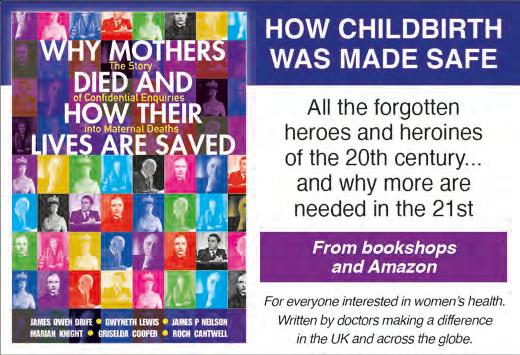




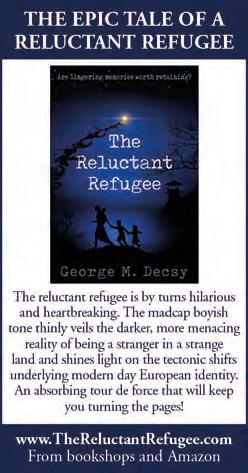

Health
October
Clothes & Bedding Books & Publishing Clothes & Bedding
To advertise, contact Monty Zakheim on 0203 859 7093 or via email MontyZakheim @theoldie.co.uk
Skincare To advertise, contact Monty on 0203 8597093 or via email MontyZakheim@theoldie.co.uk scc rate £45+vat. The copy deadline for our next issue is 30th
2023
Homewares
Christmas Prize Quiz

A delicious Partridges Christmas Treats Hamper goes to the winner of our quiz – set by MARCUS BERKMANN

Who was the only actor to appear in all 295 episodes of Last of the Summer Wine?

2 The album version uses the name ‘CocaCola’ and the single uses ‘cherry cola’ instead, to avoid a BBC ban. Who flew from Minneapolis to London just to sing the words ‘cherry cola’?
3 Which Scottish football team played in two FA Cup finals, in 1884 and 1885? They lost, on each occasion, to Blackburn Rovers.
4 Which day of the week was originally Jupiter’s day, and still is in France?
5 What links the waltz, the fandango, the minuet, the mazurka, the polonaise and the saraband –beyond the fact that they are all dances?
6 What six-letter word is the technical term for those tiny hamburgers you get as canapés at parties? The origin of the term is unknown, although an American regional hamburger chain was quick to trademark it in 1985.

7 Which country did Henry Kissinger once describe as ‘too big for Europe, too small for the world’?

9 Which female American novelist, a great favourite of Paul Ryan, Alan Greenspan and Jimmy Wales (who founded Wikipedia), was born Alisa Zinovyevna Rosenbaum in St Petersburg in 1905?
10 Which nine-letter word was first recorded in the writings of Thomas Elyot in the 1540s, meaning ‘one who binds or ties something’, and was only applied to the massive reptile it’s now generally used for 50 years later, in the 1590s?
17 In 1939, Duke Ellington offered the songwriter Billy Strayhorn a job and sent him the money to travel from Pittsburgh to New York City. He even wrote directions for Strayhorn to get to his house by subway. How did those directions begin?

18 Which British monarch, featured in Jackie Chan’s 2003 martial arts western comedy, Shanghai Knights, was romanced by Charles Darwin in 2012 animated caper The Pirates! In an Adventure with Scientists, and was played by Peter Sellers in drag in The Great McGonagall (1974)?
19 Who is the only head of the CIA who later became US president?
11 In the 1850s and 1860s, who made incognito visits to Europe and the US under the name ‘Lord Renfrew’?
12 What did Fidel Castro, Bill Clinton, Golda Meir, Sir Oswald Mosley, Leon Trotsky, Richard Wagner, Isadora Duncan, Magic Johnson, Marc Chagall and Burt Reynolds all call their autobiographies? It’s a two-word title.
13 Who had the bestselling single in the UK in the years 1958, 1960, 1961 and 1970?
14 And who had the bestselling single in the UK in the years 1959 and 1988?
20 Which artist, born Michelangelo Merisi in 1571, took his name from the small town in which he grew up, moved to Rome, was arrested 11 times in six years, once for throwing an artichoke at a waiter, and went on the run in 1606 after killing a man during an argument about a tennis score?

8 Nicolas Cage in Adaptation, Edward Norton in Leaves of Grass, Lindsay Lohan in The Parent Trap, Jeremy Irons in Dead Ringers, Tom Hardy in Legend and Bette Midler in Big Business all played what?
15 Cricket around the world is run by the ICC, the International Cricket Council. But originally those initials stood for something slightly different. What was it?
16 Who was the second student ever to be elected rector of Edinburgh University? He was elected in 1972, aged 21.
A wonderful Partridges Oldie Christmas Deli Hamper (see p21 for more details or visit partridges.co.uk – to buy at the exclusive Oldie price of £120) is the prize for the first set of correct answers drawn out of a hat. Email your entry to: comps@theoldie. co.uk, subject heading Xmas Gift Quiz Prize Draw. Closing date: 25th November 2023. Result: on oldie.co.uk, 27th November.

38 The Oldie Christmas Gift Guide 2023
ZUMA PRESS, INC.; ALLSTAR PICTURE LIBRARY LTD; PICTORIAL PRESS LTD/ALAMY STOCK PHOTO































































































































































 Nigel Summerley
Nigel Summerley










 By Roger Lewis Riverrun £30
By Roger Lewis Riverrun £30


































 DAVID HOLME, ACCRINGTON
DAVID HOLME, ACCRINGTON







































































 lucinda lambton
lucinda lambton




 patrick barkham
patrick barkham





























































































































































































































































































































































